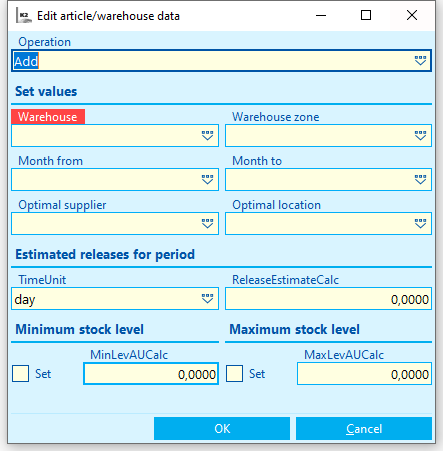Articles
The Articles database contains a list of all articles, materials, products, semi-finished products and other special item types, which are linked to the documents used in the individual modules of the K2 program. The Article card contains all information about the articles: VAT rate, minimum stocks in warehouses, purchase and sales prices, turnovers and movements of articles, etc.
Each article has its internal number that is automatically assigned by system (after saving by pressing F2 key) and that is important for an unique identification of articles in K2 IS.
You cannot cancel the already created Article card. It is only possible to invalidate them by pressing the F8 key. Making records invalid means that the cards aren't visible in the Book mode and it isn't possible to work with them. The invalidated cards are accessible only in Evaluation filter off. The invalid cards have a red cross icon next to the field Abbreviation 1 on the 1st page of the card ![]() . By again the pressing of the F8 key you can make an appropriate record invalid again.
. By again the pressing of the F8 key you can make an appropriate record invalid again.
Book of Articles
From the point of monitoring Stock records, the settings of the requested stock and the current period is essential. The display of stock information then applies to these. These data are also essential for the printing of stock reports. The set period and stock are displayed in the upper blue bar on the screen. Changing the period and stock may be done by pressing the Alt+F10 key.
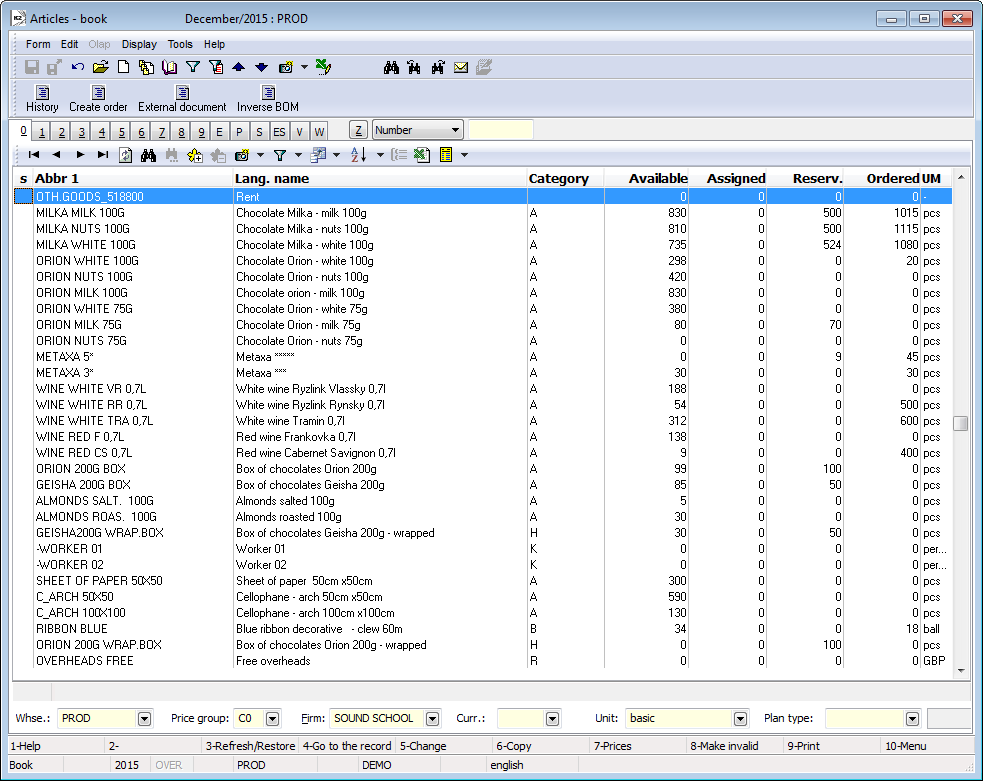
Picture: The Articles book
Columns Description:
Abbr 1 |
The Abbreviation 1 on the 1st page of the Article card. |
Lang. Name |
The name on the 1st page of the Article card. |
Category |
The Category from the 1st page of the Article card. |
Available |
The number of the Article units that is available in a warehouse at the moment. Article will get into Available by confirming the stock documents:
Note: In the case of two document confirmation, the quantity stated on a Receipt Card will be added to the Received column (it is not a default column) during the first confirmation of a Receipt Card. During the second confirmation this quantity will be transferred to the Available column. By displaying the "BFIsAvailable" column, the program will indicate the available levels of Articles in some of the company's warehouses to the User - in this case, the icon |
Assigned |
Number of Article units that is blocked for a particular customer, branch, or production. However, this quantity is still physically in stock. The blocking occurs if the Article is located on a Release item of an unconfirmed stock document. By the type of blocking, we distinguish the following:
Confirming the document will automatically deduct the quantity of units from Assigned, while the article is no longer physically in stock. The value is displayed only if the User has set the current period. Note: Articles on internal Transfer Notes within a warehouse are not blocked (do not enter to the Assigned). If You want to treat the internal Transfer Notes as interim Transfer Notes, you can activate the Client parameter Count Internal Transfer Notes to Assigned. Note: 2: The value in the column is not affected by the set Plan Type (the Plan Type field in the bottom part of the screen), as it is not being calculated from the document items, but from the stock records. |
Reserved |
The number of Article units which is necessary to be ensured for a customer, a branch, or for production. The Article might not be available at the moment and it is important to order or produce it. Otherwise, the Article is in a warehouse and a customer (branch, production) asks for it. However, the reservation is not blocked for the customer. Depending on the nature of the request, these are items on the following documents:
The displayed values are independent of the selected period. The quantity read from the Job cards and Reserving Cards is independent of the warehouse, but respects the display settings of your own companies. For the quantity loaded from the Transfer Notes, the warehouse is respected. Note: The quantity from the documents, whose Plan Type is selected in the lower part of the screen in the Plan Type field, is loaded to the column (the description of Plan Types is in the chapter Basic Code Lists and Supporting K2 Modules - Plan type). Note: 2: Items of internal Transfer Notes with the "r" flag are not counted into Reserved. Free Reserving Cards are also not counted. |
Ordered |
The quantity of Article units that is ordered by suppliers, branches, or that will be produced by their own production. Depending on the nature of the request, these are items on the following documents:
The displayed values are independent of the selected period. The quantity read from the Job cards and Reserving Cards is independent of the warehouse, but respects the display settings of your own companies. For the quantity loaded from the Transfer Notes, the warehouse is respected. Purchase Orders: Issuing an unconfirmed Receipt Card to a Purchase Order item will deduct the quantity from Ordered and will add it to the In Receipt column. The quantity will be moved from In Receipt to Available only after confirming the Receipt Card. Confirmation or cancellation of a Purchase Order is then treated as a cancelled request to purchase and the quantity will be removed from the column Ordered. Note: The quantity from the documents, whose Plan Type is selected in the lower part of the screen in the Plan Type field, is loaded to the column (the description of Plan Types is in the chapter Basic Code Lists and Supporting K2 Modules - Plan type). Note: 2: The items of internal Transfer Notes with the flag "r" are not counted into Reserved. Note: 3: In the book, you can also see a column showing the ordered quantity only from the Purchase module (ignoring the quantity of a Transfer Note and production) - this is the field Ordered Purch. ("OrderedPurchCalc" / "OrderedPurchUMCalc"). |
In Receipt |
Contains the quantity from Receipt items of unconfirmed stock documents:
|
Optional columns (not shown by default):
Received |
Number of Article units received by the first confirmation of the stock document. |
Dispatch |
Number of Article units issued by the first confirmation of the stock document. |
Available (CFAvailable) |
Number of Article units available on a contract code "-". It is a "free" availability. If the contract code records are not tracked (article, warehouse), the value is the same as the classic Available column (CFDisp). |
Offered (OfferedCalc, OfferedAUCalc) |
The number of Article units (in the case of the OfferedAUCalc field also in alternative units) that is found on non-realized offers (in offered items). |
Coverage Status |
Displays the value of coverage status requirements on given goods. Its value is calculated as follows:
|
Internal Reservation |
The level of internal reservations for products. Internal reservations are defined by the items of internal Sales Orders with a Reserving Card and without a Job Card with Realization. Closer description is provided in the chapter Internal Sales Orders - Internal Reservation for Production. |
Note: In the individual columns it is possible to display the quantity not only in basic, default units but within a specific unit as well (see bellow).
Columns of stock records for any warehouse
In the book of Articles are the so-called parametric columns available, which allow you to monitor the stock records data on requested warehouses. The adjustable parameter of these columns is therefore "warehouse". These are the columns for the following data:
- Available - the column Available [warehouse]
- Assigned - the column Assigned [warehouse]
- In Receipt - the column In Receipt [warehouse]
- Reserved - the column Reserved [warehouse] (the classification is important in the “dependent coverage on warehouses” setting).
- Ordered- the column Ordered [warehouse] (the classification is important in the “dependent coverage on warehouses” setting)
In the Column Settings, it is necessary to fill in the Stock field - by the abbreviation of a warehouse. The column then displays the values for this warehouse regardless of the currently set user information warehouse.
This may prove useful if the User needs to e.g. constantly monitor data of other selected warehouses in addition to their own warehouse (information warehouse).
Field description in the lower part of the screen:
Warehouse |
Current warehouse which are all the information taken from. The data about Article statuses that you can see on the screen are from a current warehouse. Abbreviation of a current warehouse is displayed in the upper blue bar on the screen too. You can change the current warehouse in this field or by pressing the Alt+F10 keys. The Display Interval form, where you can set a period and a current warehouse in the Warehouse field, will be displayed this way. |
Price Group |
It affects the display of selling prices in the Price Group ("CFDealC") column - the column is not displayed by default. When you enter the appropriate Price Group, it will show a valid selling price for the given Price Group. If there is no existing selling price for an article in the given Price Group, the price in accordance with the Unsorted Price Groups parameter settings will be displayed. |
Company |
It affects the display of selling prices in the Price Group ("CFDealC") column - the column is not displayed by default. When you set the selected company, the Price Group applied for its given supplier will appear. Displaying a Customer price has a priority over displaying a Price Group. If the Customer price of an article of this company does not exist, the price of a selected Price Group will be displayed in the Price Group column. |
Currency |
It affects the display of selling prices in the Price Group ("CFDealC") column - the column is not displayed by default. When you set currency, the selling prices (for the set Price Group or customer) defined in the given currency will be searched for. If such price exists, it will be displayed. However, if such price does not exist, a price in accordance to the rules described in the Price Group and Company fields will be applied, and this price will then be recalculated into the rate of the requested currency. |
Unit |
Unit that is selected in this field affects values in columns that display the quantity of articles (e.g. Reserved, Ordered,...). A unit into which the article is calculated will display in the UM column. In this field, you can select a basic unit, a default unit for Purchase/Sale, a unit for production, a unit for Transfer Notes, or a specific unit of measure (value "other" and unit selection from the displayed menu). The values for Article cards that do not have the required unit are displayed in the basic unit. |
Plan Type |
The selection of a plan type from Plan type code list. The quantity for Ordered and Reserved fields will be calculated according to the Plan Type. A detailed description is provided in the Basic Code Lists and Supporting K2 Modules - Plan Type chapter. |
|
The button for coverage setting. Coverage setting influences the loading of records in the Coverage of Demanded Articles function. This setting influences the loading of requests and their coverage. |
Articles card
Articles card is divided into 9 numbered pages, pages relating to concrete modules follow. These pages are marked by the letters. If in a Browse mode in the Articles book you select by the light indicator a concrete Article card and press F4 or Enter key, you get on the previous opened page of a selected card in the Articles book. The same data you can see in a Change mode after pressing F5 key.
Basic Data (1st page)
On the 1st page of an Article card the basic data a stated.
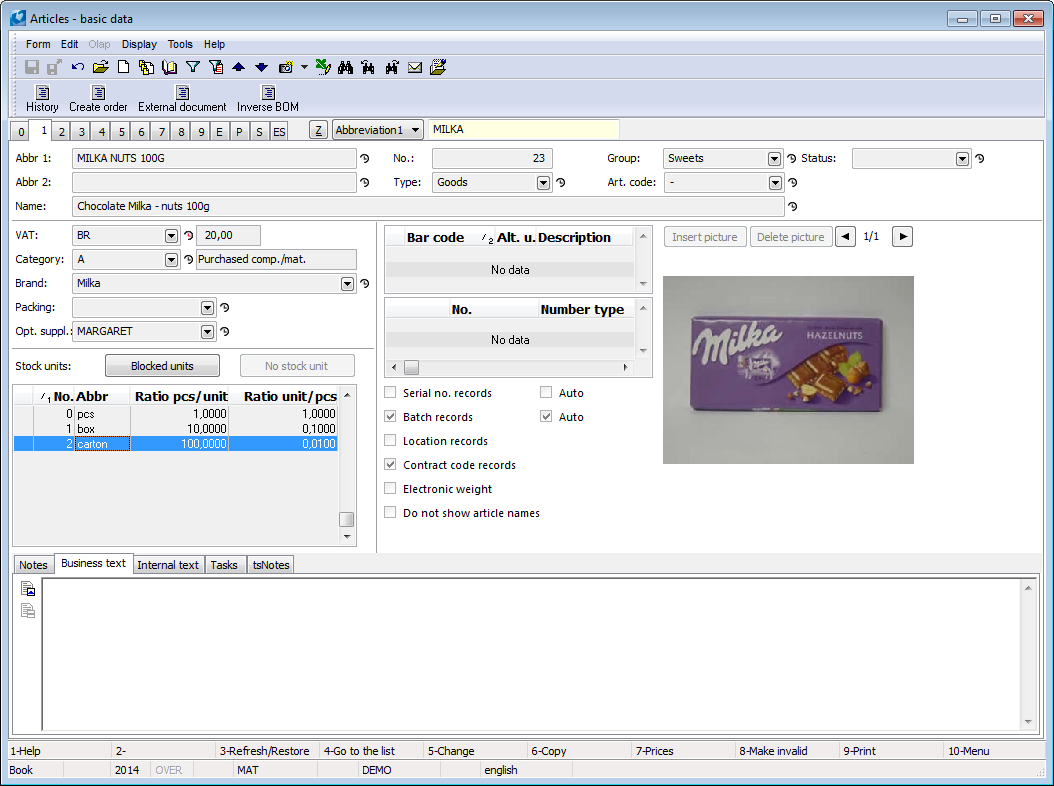
Picture: Articles - 1st page
Description of Fields:
Abbr 1 |
Obligatory unique article identifier. By this abbreviation can be hidden either article name or its part of name or random code (e.g. numeric). According to the abbreviation 1 you can search an article from a book. Abbreviation is standard given in quantity 30 characters. Note: The term abbreviation has an analogous meaning either in the Suppl./Cust. or in Articles database. |
|
Abbr 2 |
Filling of the field Abbr 2 isn't obligatory. It is possible to use it for example for PLU, etc. |
|
Name |
Field for entering a complete article name. |
|
Number |
It is a registration number of an article which is created automatically during the first saving of the Article card. Actually a registration number is an order number of entered article. Note: In the Client parameters on the 2nd page it is possible to check the option Enter article No. which enables to enter an article number on a new card manually. |
|
Type |
Article Type. Obligatory detail. |
|
|
Non-stock items |
For non-stock items a stock level is not counted. By conversion you can count only turnovers. |
|
Packaging |
It works as a stock item, it is only always valued at fixed prices (i.e. the accounting part of the Stock recalculation function does not process these cards, the physical part of the conversion does). The turnover record is calculated for packaging regardless of the Customer / articles records option in the Client Parameters. |
|
Breakdown |
When inserting a "Breakdown" card into the purchase, sale, transfer notes and job card documents, the article card itself is not inserted into the document, but the cards that create the items of this card are inserted. For purchase, sale and transfer notes documents, you can define a breakdown items on the 3rd of Articles tab in Breakdown Items section. The breakdowns for production you define in the Alternative routing book. The article card of "Breakdown" type should have its own alternative in a Routing variant book and items of breakdown entered as routing items for usage in the production. Example: You can create e. g. a Computer card and you can define the list of articles on the 3rd page which you sell under the name Computer (e.g. monitor, keyboard, mouse). When you insert this card to sales order, a list of articles from the 3rd page is inserted, but the Computer card is not inserted into the document. |
|
Article breakdown |
Apply the same rules to cards of the "Article breakdown" type as to cards of the "Breakdown" type, with the difference that, in addition to the items of breakdown, the card itself is also inserted into the documents. Example: You can create e. g. a Computer card and you can define the list of articles on the 3rd page which you sell under the name Computer (e.g. monitor, keyboard, mouse). When you insert this card to sales order, a list of articles from the 3rd page, including the Computer card, is inserted. |
|
Discount |
This value had got its meaning in the lower versions of K2 IS. |
|
Master card |
An article card used for e-shop. The article card with this type is important as superior article card for various article variants. Article card with this type cannot be inserted on documents, the information on the availability is the sum of the subordinate variants. |
|
Stock item |
Stock items have got the influence on stock records. |
Group |
Group is a random number or text which every article has to have assigned. Instead of text in this field can be entered dash too, that means it won't have got assigned a concrete group. By this division the database Article breaks up to the smaller and clearer groups with the collective properties (e. g. groups Grocery, Tools, Spare parts ...). Note: A record from the Groups code list cannot be deleted if the given group is already used on Article card. |
|
Article code |
Article code is a random number or text which every article has to have. In this case a dash can be entered in this field. According to the article code it is possible to divide articles for example to inland software or foreign software, alcohol to beer, wine, spirits, etc. Article code can enter to accounting as a complementary (helping) analytics of appropriate accounts. |
|
VAT |
VAT rate code list. |
|
Category |
Article category is the key code list for production. It is important for differentiation the article into materials, performance, semi-finished products, products, etc. Each type of article has different properties that determine its behaviour in production. You can set the category options on the 1st page of Category card. In types, you can also define calculation formulas for calculating the prices of products and semi-finished products. Article category influence option of sorting of the Article card to the individual documents and option of separated print in the documents too. On the Article category it is possible to preset auxiliary stock records for articles cards. Detail description is described in the chapter Master Data of Production module - Article - Article category. |
|
Brand |
Brand or article producer. You can select both the a record from the code list and enter any name. |
|
Packaging |
Packaging with the article card. When you insert the article into the document, the packaging card is inserted into the document automatically. |
|
Opt. suppl. |
Here you can set an optimal supplier, that means a supplier who satisfies your requirements best. The selection is executed from the Suppl./Cust. card. The field is important when recalculating of stock prices according to the optimal supplier price in the case that the price is defined on the 5th page of this supplier and when ordering by Create POs for requested goods function. |
|
Packet type |
Packet type defines the possible methods of transport by which the articles can be shipped, including the weight limit for each method of transport. This field is mainly used for e-shop. |
|
Stock units |
The stock records, the economic records (at energy deliveries, at transport) is kept in this stock unit e. g. pcs, m, kg/pcs, GBP/km (of transport), GBP/hour (of training) MWh, etc. In addition to the basic stock unit, also other units having a certain ratio to the basic unit can be listed on each Article card. E. g. the basic stock unit can be pcs and the others stock units can be package and kg. By pressing Ins key in the table of stock units you can insert a new stock unit. The usage of stock units is applicable so that a quantity of high numbers did not have to be placed in the documents. If you use the possibilities of other stock units, we recommend to use the smallest unit as a basic (first entered) unit. |
|
Blocked units |
By this button you can display the stock units that had been blocked and they are not used at the moment. |
|
No stock unit |
The button simplifies the settings of unit in the Article cards where the unit is not important (especially a card other than articles). By using this function you can save manual filling in data - a basic unit record with unit of measure "-" will be automatically created. |
|
|
Number |
Unique number of stock unit. The user cannot influence this number. Unit with number = 0 is a basic stock unit. This fact is described at this unit too. The symbol "•" informs about basic unit in a flag column on the 1st page of Article card. |
|
Unit of measure |
Abbreviation is selected from the code list of units of measure. |
|
Ratio basic / current unit |
Ratio determines a quantity of basic units to one currently entered unit. Against the field Current unit / basic ratio is the inverted value, and after you change one of these fields, the second one is automatically calculated. |
|
Cur./basic unit ratio |
Ratio determines a quantity of current units being entered in one basic. Against the field Basic ratio / cur.unit it is in inverted value.The second value will be automatically counted after you change one of these fields. |
|
Width, Height, Depth |
Field for entering unit dimensions. The field is used only for records, it isn't used by the standard. |
|
Dimension unit |
Abbreviation of selected stock unit. |
|
Net weight (kg) |
Weight of article without packaging. This weight is used by the function Calculate product weight. It is entered only on basic unit. |
|
Gross weight (kg) |
Weight of appropriate stock unit of article with packaging. This weight is used during the calculation of item's weight and than document. |
|
Capacity / Capacity unit |
Capacity of stock unit. Field is used only for records, it is not used by the standard. |
|
Area / Area unit |
Area of stock unit. Field is used only for records, it is not used by the standard. |
|
Handling equipment |
Assignment of handling equipment to the stock unit. By this assignment, we express how to handle with the appropriate unit in the warehouse by the personnel (e.g. the stockkeeper wears it in hand or has to use a trolley, etc.). For each handling equipment it is also possible to determine the group of warehousemen to work with this technique. We do this on the 1st page of the dial in the Queue field (for example, the queue for handling equipment "truck", which is assigned to the storage unit "pallet", is queue "A", which workers are authorized to drive a forklift). |
|
Integer unit |
If you use this unit, you can not enter a decimal value in the items. |
|
Default unit for purchase |
By checking this field the stock unit is automatically set after you select the article in the Purchase item. This field can be checked only in one unit. If the flag is cancelled in any item, it will be automatically set in a basic unit. |
|
Default unit for sale |
By checking this field the stock unit is automatically set after you select the article in the Sale item. The field can be checked only in one unit. If the flag is cancelled in any item, it will be automatically set in a basic unit. |
|
Default unit for production |
By checking this field the stock unit is automatically set after you select the article in the Job card item. The field can be checked only in one unit. If the flag is cancelled in any item, it will be automatically set in a basic unit. |
|
Default unit for transfer notes |
By checking this field the stock unit is automatically set after you select the article in the Transfer notes item. The field can be checked only in one unit. If the flag is cancelled in any item, it will be automatically set in a basic unit. |
|
Default for transfer notes |
The warehouse unit default for Stocktakings is automatically preset when entering items into the Stocktaking lists, and Stocktaking processing is also performed in this unit (calculation of Stocktaking differences, creation of documents). |
|
Default unit for internet shop |
By checking this field the stock unit is automatically set after articles selecting in the Internet shop item. The field can be checked only in one unit. If the flag is cancelled in any item, it will be automatically set in a basic unit. |
|
Quantity unit for i-shop |
If this field is checked, it is possible to order the goods in the internet shop only in this quantity unit in the given ratio to the base unit. The field can be set only in one item. |
|
Block the unit / Unblock the unit |
If you do not want to use any stock item for this article card, you can block it. The unit will be neither offered nor displayed, if the button Blocked units is not on. Blocking will automatically cancel possible checking of Default units fields at the same time and displays the flag On a blocked unit the button will be changed to the Unblock the unit button. This operation can be executed only on the last entered unit with an appropriate unit of measure. |
|
Save as New One |
This button enables to save actually edited unit as a copy and it blocks the original unit at the same time. It is very suited to use this function especially if the ratio of a unit changes to a basic unit, because the correction of a previous unit would cause very important change of existing documents. |
Bar code |
The table of bar codes enables to register the various bar codes to various units of an one Article card. You can insert a new code by pressing Ins key in the table. The code also records whether you use it for EDI or whether it is the default bar code. This information is used in e-shop to export articles for price comparators. |
|
Supplementary article numbers |
Define additional identification information for that article card. It can be a "Product Number" (S/P), which is often displayed in the e-shops and is used to trace, for example, a suitable replacement or alternative piece. |
|
Serial no. records |
Serial no. monitoring in stock records. If this field is activated, then the items with this article in the stock documents and job cards have to contain serial numbers, otherwise the program will not allow to confirm a document. Note: The option can not be changed by default if there is a record in the stock records (non-zero Received or In receipt or Available or Assigned or Dispatch) for a article card. Detailed description of serial numbers is stated in the Purchase and Sale Shared Elements - Serial numbers chapter. |
|
|
Auto |
This value enables to create automatically the serial numbers when confirmation of a receipt card. Detailed meaning is stated in the Purchase and Sale Shared Elements - Serial numbers chapter. |
Batch records |
Batch monitoring in stock records. By checking of this field the batch will be required in all stock documents items. Note: The option can not be changed by default if there is a record in the stock records (non-zero Received or In receipt or Available or Assigned or Dispatch) for a article card. |
|
|
Auto |
If this option is activated, batch for receipt items: positive item of receipt card, negative item of job card, header of job card, is automatically created when confirmation the stock document. |
Location records |
Location monitoring in stock records. Stock location record are counted only in warehouses, that have the Location records field enabled. In this case, the location entering is required on all stock documents. Note: The option can not be changed by default if there is a record in the stock records (non-zero Received or In receipt or Available or Assigned or Dispatch) for a article card. |
|
|
Auto |
If the option is activated, then there is a proposal of location for the receipt of article to the warehouse. Location for the item is proposed at the time of inserting the article card into the receipt item. Release notes: location is proposed according to the optimal location defined for warehouse / zone / Business year (the 4th page of the article, Article/warehouse data table). Receipt cards, transfer notes: location is searched according to the existing inventory of the specified article card at first, if an article is not found at any location, then according to an optimal location, which is defined for warehouse / zone / period. A rule, that a proposal for a location takes a current location load into account, it means that it is compared, whether a location capacity will not be exceeded by the receipt of a current item, always holds. |
Contract code records |
Contract code monitoring in stock records. Stock contract code record are counted only in warehouses, that have the Contract code records field enabled. Note: The option cannot be changed by default if there is a record in the stock records (non-zero Received or In receipt or Available or Assigned or Dispatch) for a article card. |
|
Electronic weight |
Electronic weight is used in the bar codes where the weight is coded. |
|
Do not show article names |
By checking the Do not show article names field you define that in the documents, where the article is, only the text entered in the Description field (on an item of purchase or sale) or in the Name field (on an item of a transfer note or a job card) displays. Otherwise the text will be understood as a supplement of an article name. |
|
Note: Activation / deactivation of the option of an auxiliary stock records
The options for monitoring auxiliary warehouse records can also be changed if the articles are in stock records only if the client parameter Do not check stock records settings on article card is activated.
Insert image
If you have the article image, you can add it by pressing the Insert picture button. The picture appears to the right of the bar code. These pictures help to create the offers in the Marketing module. You can delete a picture by pressing the Delete picture button. Associated pictures will be added automatically on the 9th page into the Attached documents part. By double click on this picture, you can open it separately in a browser.
Tabs at the bottom of the form
You can use the Notes tab to work with notes. Further description of work is stated in the chapter Basic Code Lists and Supporting Modules K2 – Notes.
You can also use the Business text and Internal text tabs. The business text is automatically printed on the Offers, it is possible to display it on other purchase and sales documents. If the SupplFromArticle parameter is empty on these documents, the Business text is printed. The value 0 would not print the text. (Note: In addition to the mentioned values, the parameter can also be used to enter the supplement abbreviation, which is inserted on the articles, if the text from the supplement should appear on the document).
The Product keys tab is used to work with discount coupons. In Change mode, you can assign product keys to article card or delete existing ones. By pressing Ins you get to the Product Keys list. Here you can create additional keys, edit existing, confirm or undo the confirmation of records. If article is assigned to the Product key then the article appears on the 1st page of the given key in the list of articles.
On the Language names tab, you can enter and edit foreign-language article card names. Enter the description into the editable Text column.
The packet type is used to define the special and possible methods of transport for the Articles. For a packet type, the User assigns specific methods of transport, which in addition may limit the maximum weight. It is used especially in the Eshop, where if the type of package is defined for the Articles, including methods of transport, then in the 2nd step of the basket, the User is offered only suitable methods of transport.
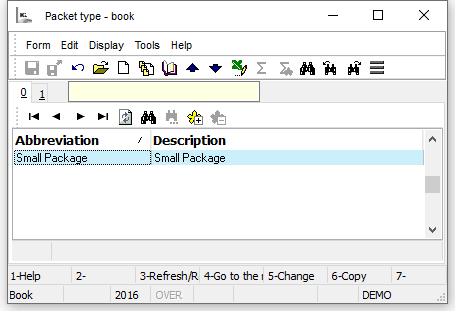
Picture: Packet type
Prices and others data (2nd page)
On the 2nd page of an Article card the information about purchase prices is contained.
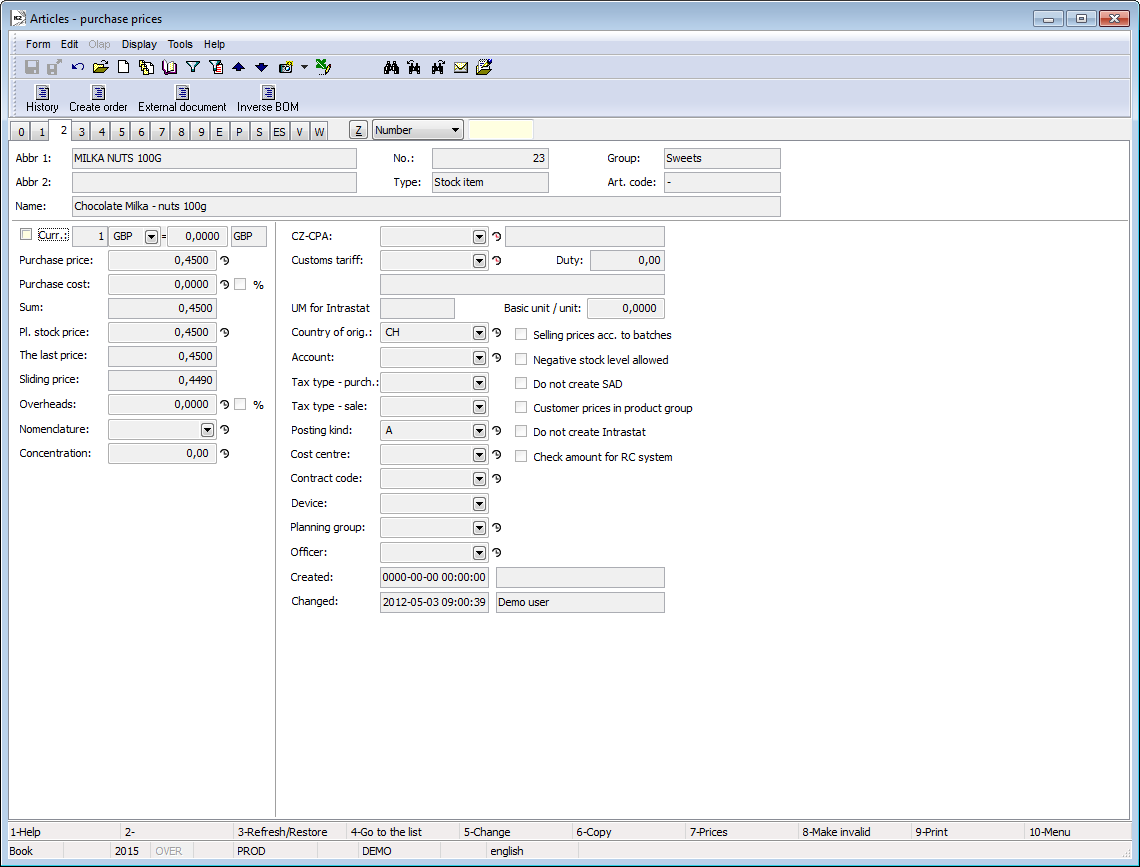
Picture: Articles - 2nd page
Fields Description:
Currency |
Change mode: Off: Prices are set in the base currency. By changing the rate, the amount in the base currency will not change, the amount in foreign currency will be recalculated. On: Prices are entered in the selected foreign currency. By changing the rate, the amount in the base currency will not be changed, the amount in foreign currency will be recalculated. By saving the Article card, you also save the settings (off / on) of this option.
Browse mode: Activation / deactivation only temporarily shows the amounts (in / without currency).
The currency is taken into consideration when you select the appropriate supplier price in the Purchase price calculation by the Recalculate article price. |
Purchase price |
Estimated purchase price excluding VAT. |
Purchase cost |
Cost associated with the acquisition of articles (e. g. transport, premium, commissions etc.). They are given either as a percentage of the purchase price (the absolute value of the purchase cost will be automatically derived from the purchase price and from defined percent) or in absolute value. This field is used to compute the costs associated with the acquisition of articles. The value of the field is set when the item is placed in the PC item field (planned incidental costs). |
Sum |
The sum of Purchase costs and Purchase price appears automatically. In the Article card is only displayed. |
Pl. stock price |
This field does not calculate K2 IS, but a user can enter it. If the invoice price (price of Invoice In) is unknown upon receipt of the article, then the value of this field is entered into the Receipt Card as a Receipt price. A price from this field evaluates the product, if you price the products by a fixed stock price. The field is updated by Recalculating of stock prices (it is possible to enter it by a sliding price, last price, etc.), at products and semi-finished products by Recalculate products (it calculates the price on the basis of the routing variant). |
The last price |
The price of the last confirmed invoice in that has confirmed a receipt card for this article too (at least 1. confirmation). |
Sliding price |
Sliding price of article for an accounting warehouse. It is calculated as the current share of the value of the article in stock in CZK and the quantity in stock. It displays the value from an accounting warehouse where the basic stock that is actually defined in the Article book is included. Or a value from a warehouse that has the Default accounting option enabled. It is also updated with the Stock recalculation function. Note: With zero inventory availability, the value of the sliding price is equal to the price of the last move (for reasons of fair pricing). |
Overheads |
In this field you can enter a surcharge (a production overheads) that evaluates the production absolutely or in percent. This also enters the calculation of the product stock price according to the specified costing model (see the Master data of production module - Article - Article categorychapter). |
Nomenclature |
The field you fill only in the article cards that subjects to an excise tax. In the field you select a six-digit code under that it will be stated in an excise return. This code has attached the excise rate. The excise rate is stated in relation to an unit of measure that is specified in law on excise and this unit has to be stated as the one of the alternative stock units in the Article card, otherwise K2 IS declares an Error. The defined value and associated excise rate are automatically copied into the purchase and sale item. |
Concentration |
This field you fill only in Article cards that subjects to a excise on alcohol (you enter the percentage content of alcohol in the product as a decimal, i. e. 40% enter as 0.40) or a excise on beer (you enter the number of whole degrees Plato). |
CZ-CPA |
Standard classification of production issued by the Czech Statistical Office. It serves to ensure international comparability of statistical indicators. |
Customs Tariff |
The code list Customs tariff is described detailed in the Basic code lists and supporting modules K2 - VAT rate / Customs tariff chapter. |
Duty |
This field serves only for displaying of the percentage amount of duty. |
UM for Intrastat |
It displays the unit of measure for Intrastat. The value is to be entered in the Customs Tariff. Fields can not be edited, change is possible in the Customs Tariff. |
Basic unit / unit |
Assign the ratio of the Intrastat unit to the base unit. Note: If the value remains zero, then the Intrastat calculation will be notified of this fact and the article will not be loaded into Intrastat. If the card does not enter Intrastat, the value may remain zero. |
Country of orig. |
To the Article card you can assign country of origin that can have continuity in the Purchase and Customs module. |
Account - purchase |
Account from the accounting classifications. It fills in Non-stock cards, it is used on purchase documents. |
Account - sale |
Account from the accounting classifications. It fills in Non-stock cards, it is used on sale documents. |
Account - sale consol. unit |
Account, which you can apply to purchase documents, when on the 1 st page of Suppl./Cust. card is on the flag Company of consolidation unit. |
Account - sale consol. unit |
Account, which you can apply to sale documents, when on the 1 st page of Suppl./Cust. card is on the flag Company of consolidation unit. |
Tax type - purch. |
Tax type that will be filled in the purchase item. |
Tax type - sale |
Tax type that will be filled in the sale item. |
RCS - Type of tax for purchase |
If Check amount for RC system is enabled on the Article card, this tax type is automatically added to the Invoice item if the query "Do you want to set the tax type for RC system from Articles?" upon confirmation of the Invoice In. A more detailed description is stated in the documentation Accounting / VAT / VAT guide, import and export / Reverse charge mode. |
RCS - Type of tax for sale |
If Check amount for RC system is enabled on the Article card, this tax type is automatically added to the Invoice item if the query "Do you want to set the tax type for RC system from Articles?" upon confirmation of the Invoice Out. |
Posting kind |
The kind according to that the articles will be charged on the stocks. The field can be edited if there is no stock movement on the Article card in the period blocked for accounting changes. Note: This field was created from the field Brand on the 1st page of the Article card. For the needs of production is needed to distinguish several types of goods, while for the needs of accounting just fewer species. |
Cost Centre |
The cost centre that will be filled in the purchase or sale item. |
Contract code |
The contract code that will be filled in the purchase or sale item. |
Device |
The device that will be filled in the purchase or sale item. |
Code 1 |
Arbitrary code. It serves for user identification. It will be filled in the purchase or sale item. |
Code 2 |
Arbitrary code. It serves for user identification. It will be filled in the purchase or sale item. |
Code 3, Code 4, Code 5, Code 6 |
Another distinctive code. The fields (from Code 3 to Code 6) are available only in universal interface. They are not displayed by default. The method of inserting is described in the chapter ... It will be filled in the purchase or sale item. |
Planning group |
The selection from a code list that you can define. This field is used for products and semi-finished products separation to various groups for planning. This separation is possible to use in the Capacity plan script (plan_capaplan.pas) where by GroupByPlanGroup parameter you can display requirements for source separated according to the planning groups. Example: Product A is produced on the Line 1 source and has a defined planning group A. Product B is also produced on the Line 1 source and has a defined plan. group B. The requirements for this source, which result from the product Job Card A and B, are then divided in the capacity plan according to these 2 planning groups. |
Officer |
It enables to add e. g. a responsible person to the article, it is a link to the Officer book. After selecting of this articles into the document the data will be copied to the item. |
Selling price acc. to |
If on the 1st page of the Article card the Batch record field and Selling price acc. to batch are checked simultaneously, it is ensured that the final selling (invoice) price is the price according to the batch edited according to the defined price and product groups. In their definition the value Relative has to be checked. The condition is to have checked this field by an appropriate batch too (1st page of the Batches book), what occurs automatically according to the setting of this field. |
Negative stock level allowed |
By checking this flag the negative status are allowed in stock records. Note: It is not recommended to allow it for the articles that is normally purchased and sold. It is used e. g. at any Article cards used in production. |
Do not create SAD |
It is impossible to create SAD by checking the flag. That means if you create e. g. SAD from Invoices In, then the SAD will not been created for these Invoice items that has this flag on. |
Customer prices in product group |
You check this field if you define customer prices in a product group in a customer card and you do not do the recalculations of the Price groups and Customer prices. In this case the customer price will be found directly in the definition of a product group regardless if down on the 5th page of an Article is this price calculated. |
Do not create Intrastat |
By checking the flag, it is impossible to create Intrastat for the article. If the article is on the invoice entering Intrastat, then the good that have the field checked do not enter Intrastat. |
Check amount for RC system |
It will be checked on the Article cards, which are a subject to Reverse charge mode if the amount of the tax base exceeds CZK 100,000. |
Created by |
Date and time of the Article card creation and an user who created the record. |
Changed |
The date and name of the user who made the last change. |
Routing (3rd page)
Third page of the Article card is divided into three parts.
Routings
First table displays individual routing variants. The settings of alternate routings is executed in the Alternate routings book. Two fields in the header of this page are linked to alternate routings:
Description of Fields:
Variant |
A default (basic) routing alternative of a product. Alternative will be entered according to the setting of Default value in alternate routing. Or vice-versa, by setting of an alternative to this field the activation of a value Default in the routings will be adjusted. By invalid of a default alternative in the Alternate routings book the value in this field will be deleted. |
Copy |
The settings, which routing variants will be copied during an article copying by F6 key.
|
Show blocked routings |
Invalid Alternate routings are not displayed by default. You can display them by activation this value. |
The detailed description of this problem is stated in the Master data of production module - Routings chapter.
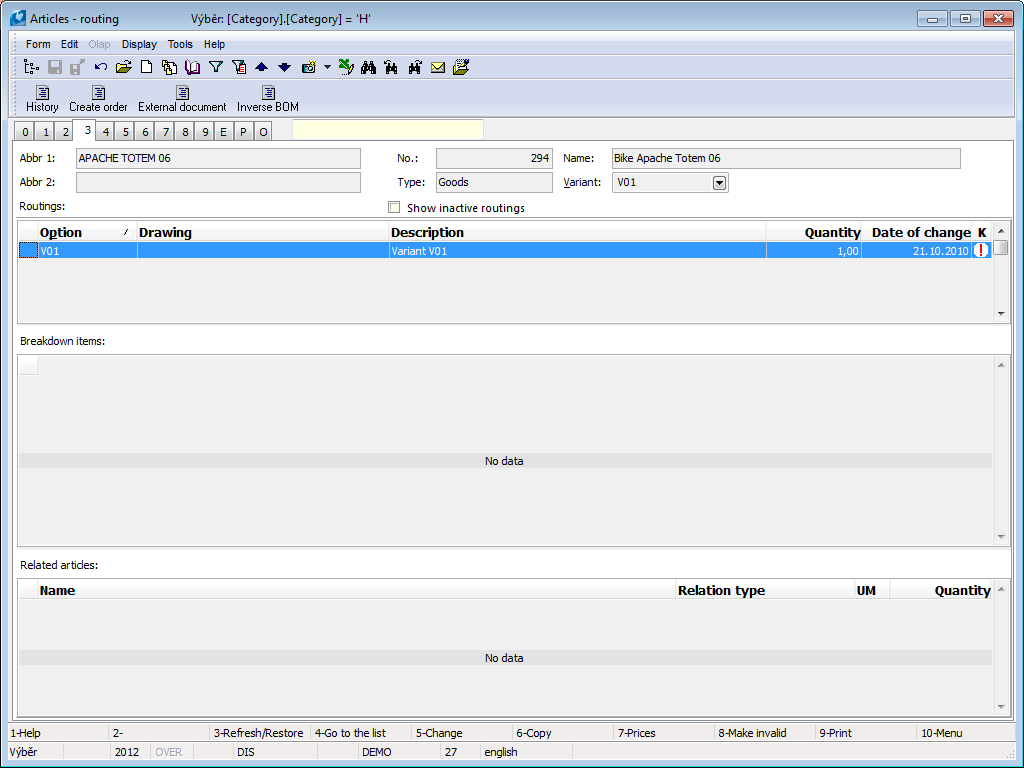
Picture: Articles - 3rd page
Breakdown items
The second table defines the breakdown items. You can define the breakdown items to the article cards with the type Breakdown and Article breakdown. The definition of Breakdowns on the 3rd page of Article card is defined only for Purchase, Sale and Warehouse modules. The breakdowns for production is defined in the Alternative routing book. The article card with a Breakdown or Article breakdown type has to have its own alternative in a Alternative routing book and breakdown items entered as routing items for the usage in production. The detailed description in the Basic code lists and supporting modules K2 - Articles - Article card - Basic data (1st page) chapter.
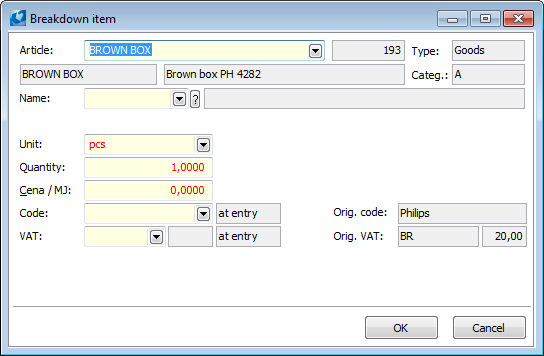
Picture: Articles - 3rd page - Breakdown item
Selected fields description:
Price/UM |
Price of Breakdown item. This field in not used in a standard, it is used for special program modifications. |
Related articles
The third part of this form serves for expression of a relationship of various article cards. you can define the Relation type in the Relation field. By default, it deals with the type "related" and "alternate" articles, e. g. for e-shop. Other types of relation can be added according to your needs.
Article variants
The fourth part of the form concerns the K2 e-shop and group the article groups under one product, which will represent its variants.
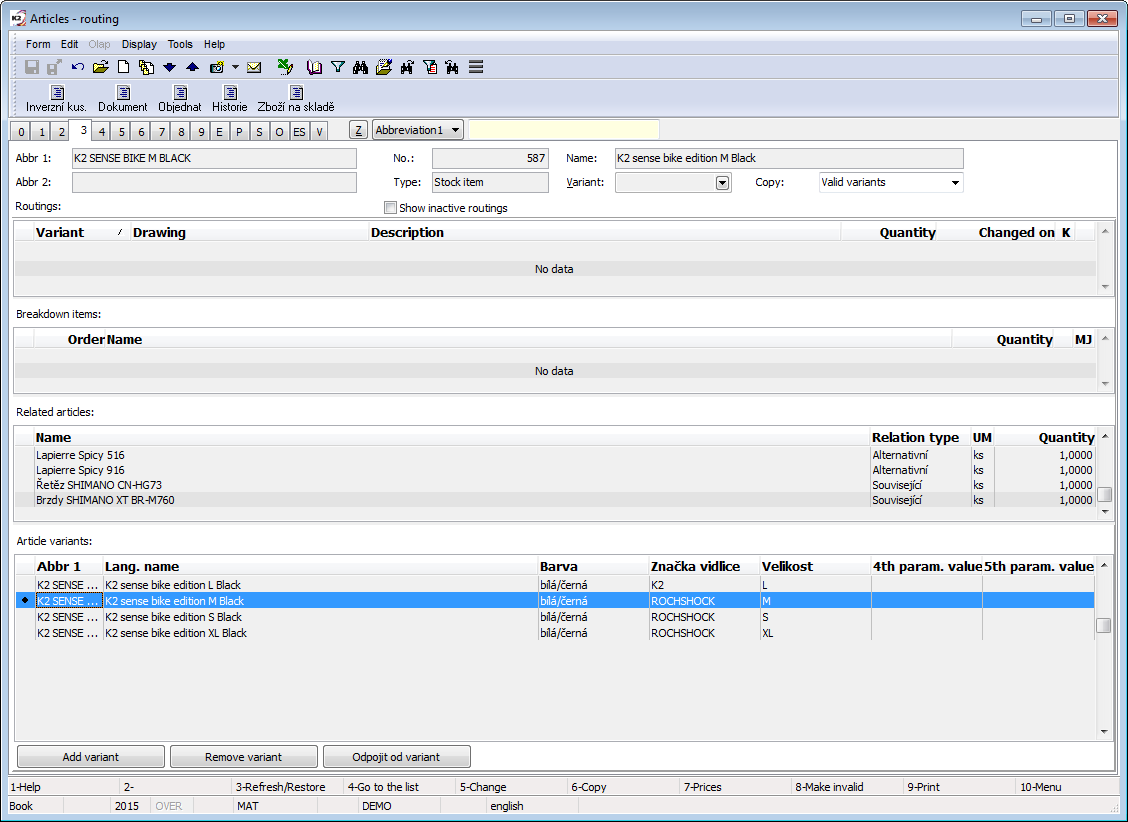
Picture: Articles - 3rd page - E-shop article variants
If you want to see some (especially distinguishing) parameters in the Article tab, you should set the Parameter to differ article variant to those parameters in the Classification. The first 5 parameters with this flag are displayed in the table.
If you want to adjust the order of displayed cards, it is necessary to:
- To check the parameter according to which you want to sort in the Classification, where it must have the properties Parameter to differ article variant (this parameter will also appear in the column of this table) and Sort by comparison value.
- Fill in the value of parameter for comparison (field Hour to sort) on the Article tab: To fill in the value, it is necessary to call up the change form with the Shift+enter key. You can enter a numerical value - e. g. in a previously used unit, the order of sizes XS = 1, S = 2, M = 3, etc.
Supplier prices (4th page)
The 4th page of the Article card is used for the case the business partner delivers articles by the system of fixed prices and its adjustments according to the product groups, multipliers and the codes of article. Added supplier price is displayed on the 5th page of the Suppl./Cust. card.

Picture: Articles - 4th page
Upper part of the card can be controlled in the Browse mode by the buttons over the table, in the Change mode extra by the standard keys. You can insert a new supplier prices by means of Supplier prices form by Ins key or by the Insert (x) button. You open the same form for performance changes in existing records by the button Change or by Enter key. The button Delete or by pressing Delete key you use for deleting of selected Supplier price.
If the light indicator is positioned on submitted supplier, you can open the Suppl./Cust. book by pressing Ctrl+Enter key in a Browse mode and you can see the card of a selected business partner.
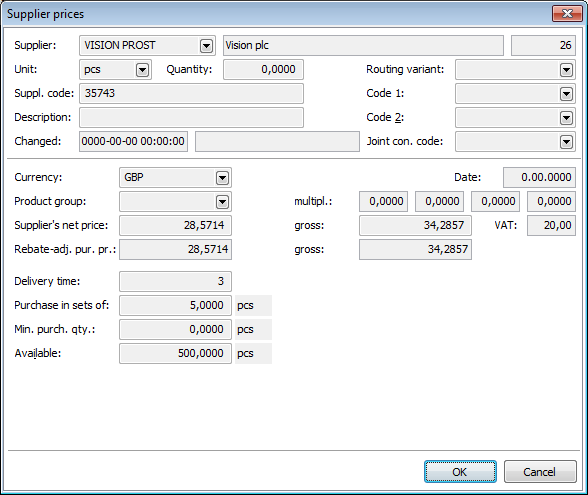
Picture: Supplier prices form
Description of Fields:
Supplier |
Supplier. |
Unit |
The field for a stock unit setting to which the price applies. |
Quantity |
Quantity of articles from which above (including) the supplier price is valid. Default quantity should be equal to zero. |
Suppl. code |
It is marking of an article used by supplier. |
Description |
In a Description field you can set the next comment to this article. |
Changed |
The date and an user name who made the last change of the record. |
Routing variant |
Some articles delivered can have more routing variants. It can serve for user identification. |
Code 1 |
Possibility of setting any code. It serves for user identification. |
Code 2 |
Possibility of setting any code. It serves for user identification. |
Joint Contract Code |
It indicates contract which the supplier price related to. |
Currency |
The currency in which the price is specified. If the field is not set, the price is in a basic currency. |
Date |
This field is useless in the IS K2. |
Product group |
Product group is relevant only if you edit the multipliers of a price or if you want to set supplier price rounding. Product group is assigned to a specific supplier. You select the product group from the book Supplier product groups. Here you can define a new product group by pressing F6 key (or Ins) or change (including multiplier values) whichever product group by F5 key. After you select a product group, the multiplier values will be automatically entered into the appropriate fields. The set rounding is applied to the calculation of the Rebate-adjusted purchase price field. |
Multipliers |
Multiplier means a figure that provides the possibility to take into consideration various variances of supplier prices (discounts,... - multiplier <1; transport, surcharges >1 etc.). For each product group, you can specify four such factors that are further reflected in the net purchase price of articles. Multiplier values are set in the book on the 1st page of Supplier product groups. |
Supplier's net, gross price |
By entering data to this field you usually say which initial price is valid for an appropriate product group per one stock unit. This is a price that the supplier has in his/her price list. Net price will be automatically recalculated to Supplier's gross price according to VAT rate defined in the Article card. The same calculation is valid vice versa too - after you set the Supplier's price into the Gross field the Supplier's net price will be calculated. Note: If the supplier is stated as a optimal on the Article card (Opt. suppl. on the 1st page of the Article card), supplier's net price will be taken to an appropriate Article card as Purchase price (the 2nd page of Article card) after conversion (function over the filter of articles Article prices recalculation - Purchase price). |
Rebate-adjusted purchase price |
Rebate-adjusted purchase price is calculated from the Supplier's net price multiplied by all four multipliers. Similarly theGross purchase price is calculated from Supplier's gross price. A Rebate-adjusted purchase price is automatically entered into an order. Purchase prices only display in a form. |
Delivery time |
According to the provided data from supplier you fill the delivery time. |
Purchase in sets of |
Value indicate after which sets the goods can be take from a supplier. You can fill a field according of the supplier data. For example the script Create POs for requested articles works with this field standardly. |
Min. purch. qty. |
Value states minimum quantity which is possible to take from a supplier. You fill a field according of the supplier data. For example script Create POs for requested articles works with field standard. |
Available |
Here you can fill the quantity of articles that is in the supplier warehouse. You proceed from supplier's provided data. Note: If you change unit of measure in the field Stock units, than the data in this field will display according to new selected unit of measure. |
After checking of the field Filter of item the entered supplier prices are possible to filter according to selected supplier by selection of supplier in the field Supplier.
You can get to the supplier prices also from the Purchase item form by the button Supplier prices. Items of supplier's price list are filtered on supplier of the document by default. If you cancel checking of the Filter of item field, you can turn off this filter and than you will see all items of supplier's price list of all suppliers.
By Enter key or by double clicks by the mouse the price from supplier's price list, where the light indicator is, inserts to the form Purchase item.
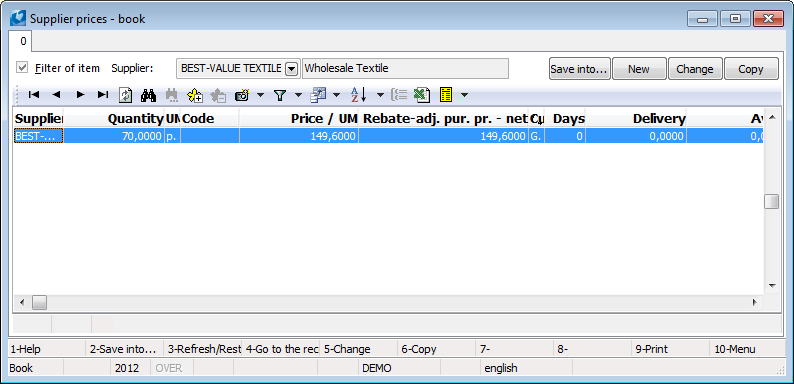
Picture: The Supplier prices form is activated from purchase item
By the button Save into... it is possible to save data from a purchase item (quantity and price of order) to the item of supplier's price list where the light indicator is. Before you save the changes, the Supplier prices form is opened and you can edit particular data. It can be executed by F2 key too.
By the button New you can save data from purchase (quantity and price of order) item as a new item of supplier's price list. Before you save the changes, the Supplier prices form is opened and you can edit particular data. It can be executed by Ins key too.
By the button Change you get to the change mode of supplier's price list item where the light indicator is. It can be executed by F5 key too.
By the button Copy you get to the copy mode of supplier's price list item where the light indicator is. It can be executed by F6 key too.
Min / max quantity, dead stocks, successor
The following data can be preset in the middle of the 4th page of the Article card:
Unit |
UM selection to enter/display the quantity in fields for min. and max. quantity. |
Min. quantity |
Minimum quantity which has to be on stock. If you update the field and given quantities, it has got importance for Coverage (see the sub-chapter Coverage of article demanded), some functions and output reports (for example moreover Create POs for requested Articles). |
Max. quantity |
Maximum quantity which can be on stock. Activating the field and specifying the quantity is important for Coverage (see the subchapter Coverage of article demanded), and some functions and output reports (e. g. Create orders for articles demanded, Stocktaking / Stock article). |
Dead stock (days) |
Checking the field Dead stock (days) activates the monitoring of dead stocks for appropriate article card. Given number of days influences some output reports (e. g. Dead stock stocktaking). |
Successor, Valid to |
Succession article card. The evaluation of this card (Daily reports, Turnover, ABC analyses) includes the data of the predecessor card after the expiration of the predecessor card - displayed in the Valid to field. The data is only for browsing here. You can enter it on the successor card in the Predecessors overview sub-tab. |
Article/Stock data
In the lower part of the 4th page of Article card you can set the data for combination of article/stock/period.
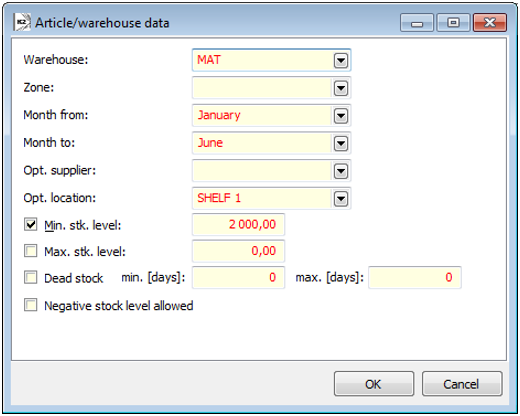
Picture: Article/Stock form
Fields Description:
Warehouse |
Warehouse to which the other data apply. |
Zone |
Zone of warehouse to which the other data apply. |
Month from, Month to |
Period (range of months), after which the set data is valid. |
Optimal supplier |
Optimal supplier for a given combination. |
Optimal location |
Optimal location of goods for a given store / zone / period combination. Description of the rule for adding the location into a receipt is stated in the Basic data of article chapter, Location - Auto field. |
Estimated releases of period |
Sales / consumption estimate for prediction. If no model is found in the prediction calculation, or if there is insufficient historical data to calculate predictions, the future sale / consumption is given by this data. You can enter the value on a daily basis, for longer (week, month) inputs, you can choose the input for the simplified input (estimate). |
Minimum quantity, Maximum quantity |
Minimum quantity, Maximum quantity allowable quantity for a given combination of stock and period. |
Lager, Minimum, Maximum |
The meaning of the fields is the same as the settings for the Article card in the middle of the form. |
Negative stock level allowed |
If you activate the option, you will enable negative levels for the set data combination. |
Overview of predecessors
You can enter predecessors of the given article card on the Overview of predecessors tab. By means of Valid to field you will specify the expiration date of the predecessor card. After the entered date, all data necessary for the logistical evaluation (Daily Reports, Turnover, ABC analyses) are moved to the calculations for the successor card. That is, daily stocks and sales after this date are included in the calculation of turnover and ABC analyses of the successor card.
Selling prices (5th page)
Selling prices are defined on the 5th page of Article card.
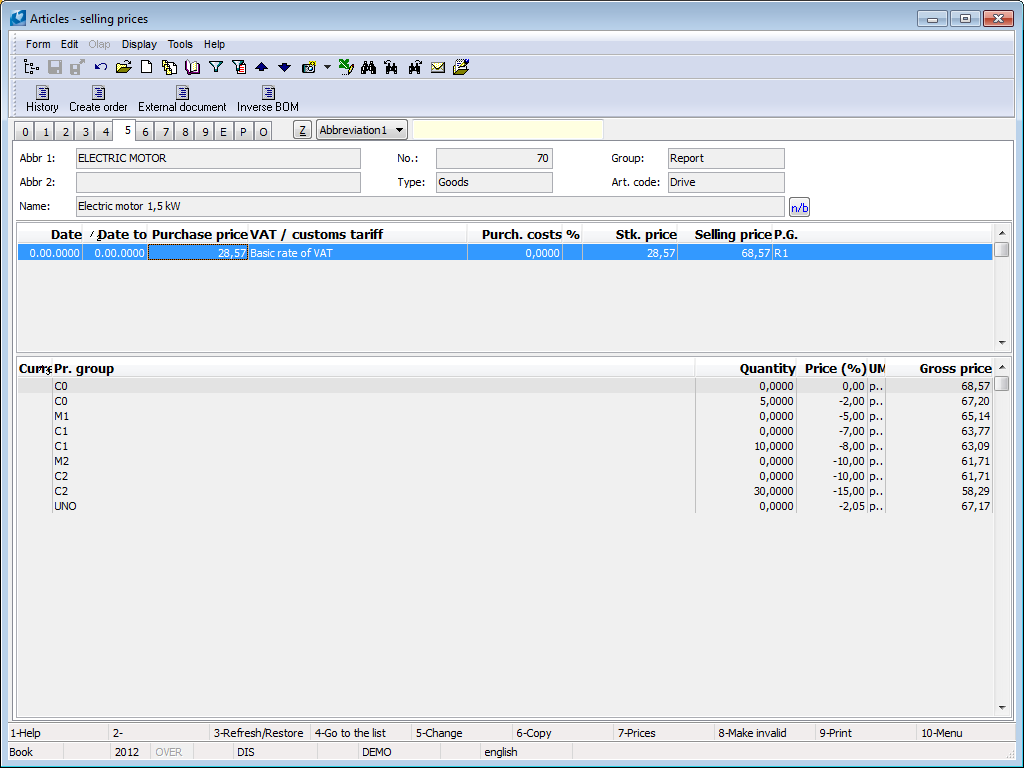
Picture: Articles - 5th page
The button 'n/b' is located in header of 5th page of Article card. By this button you can switch net and gross price either in Change or in Browse mode. For change of these prices you can use Ctrl+Alt+B key as well.
In the upper part in the 1st row the basic selling price (actual price) will be created automatically, in the next rows you can define date price by pressing Ins key in Change mode and then fill the Price list preparation form (see subchapter Date prices). The same form you can activate by pressing Enter key in Browse mode.
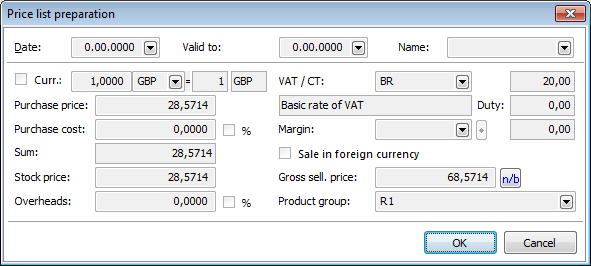
Picture: Form Price list preparation
Description of Fields:
Date |
The initial date of the validity of the appropriate Price list. The field is used for setting of a validity of a date price. |
Valid to |
The last possible date of a validity of a price list. The field is used for setting of a validity of a date price. |
Name |
Name of the price list. |
Curr. (currency), |
In the case of an actual price these fields will be pre-filled from the appropriate fields on 2nd page of the Article card. Values can be changed, the appropriate fields will be updated on the 2nd page of the Articles card at the same time. In a case of a data price the updating will not be done. |
Margin |
In this field you select an appropriate margin, or you can define a new one (see Margin subchapter). |
Sale in foreign currency |
By checking of this field the selling prices and price group will be recalculated according to the specified currency and rate. |
Net sell. price / |
The selling price is the basic price, from which a creating of the final prices in the individual price groups. It is entered manually or it depends on inserted input price and margin. Switching between Net and Gross prices is performed by the button 'n/b', which is accessible in Browse mode and Change mode too. A name of the field Net sell. price or Gross sell. price informs which of the prices is currently displayed. After pressing the button n/b the displayed prices will be switched within the prices group. |
Product group |
In this field you select appropriate product group (see the Product groupsubchapter). After setting the field Product group and completion of work with the form the query, if you want to recalculate the price groups, will be displayed. In the lower part of 5th page of Articles card the prices for prices group which is defined within the product group will be inserted. |
Margin is determined as the difference between selling price and purchase costs, or as a part between selling price and purchase costs of articles. Margin can be set either in absolute amount or percentage. You can insert a new margin into a code list by Ins or F6 key.
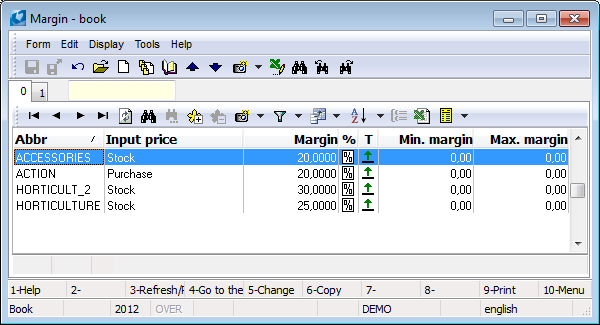
Picture: The Margin code list
Description of Fields:
Name |
Margin name. |
Input price |
An input price is a basic price which corresponds to calculation of selling price. You have eight possibilities:
|
|
|
|
|
|
|
|
|
|
|
|
|
|
|
Margin |
Level of margin can be entered absolutely or in percent (by checking flag %). |
Margin from above |
If you count the price from above, i.e. you subtract margin, you will check the field Margin from above. Example: Input price is 100 GBP and margin is 20%. If you count margin from below, than selling price is 120 GBP. If the field Margin from above is checked, than the selling price is 125 GBP. |
Min. margin and Max. margin |
The fields can affect on some output reports. K2 IS Standard does not use it. |
Purchase cost |
You mark this field in case, that you want the purchase costs, inserted on the 2nd page of Article card, will be entered to calculation of selling price. |
Duty |
If you want the duty, inserted in customs tariff on the 2nd page of Article code, enter to the selling price, you will mark this field. |
Excise Tax |
This field has not got a use in current K2 IS. |
Product groups divides database of articles to the groups according to discount (sign '-') or surcharge (sign '+') to basic selling price of appropriate article. The surcharges (discounts) are given in percent of selling price.
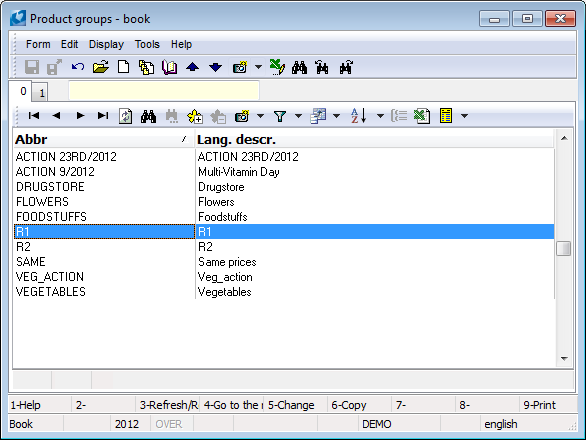
Picture: The Product groups code list
You can insert a new product group by Ins key or F6 key. Deleting from the book Product groups is not possible. Language Description of product group is possible to be inserted.
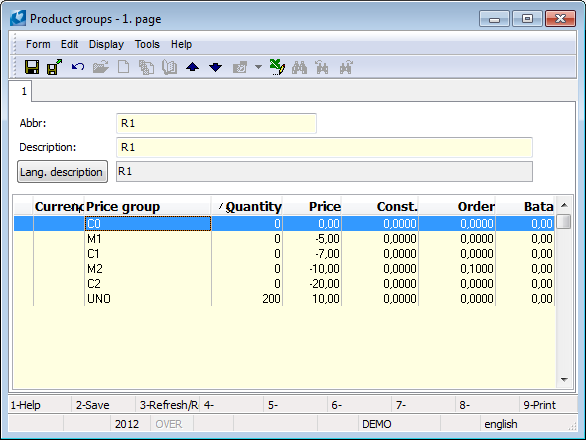
Picture: Product groups - 1st page
The list of items of a particular product group (particular customers and price groups with defined surcharges) is given on the 1st page. In the Change mode you can define a new one (by Ins key) or edit the existing price groups. For deleting a product group item you can use key Del in Change mode.
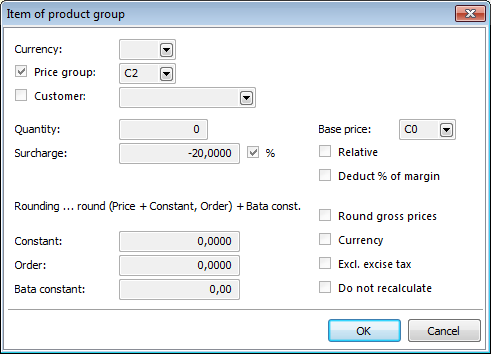
Picture: The Product group item form
Description of Fields:
Currency |
By the Search field you select the currency in which the price should be counted and displayed. It is counted according to an actual rates. |
Price group |
By checking the field Price group you can define that the entered price will refer to a price group. Note: If you check the field Price group, the field for entering of customer will be inaccessible. |
Customer |
By checking this field you define that the entered price will relate to selected customer - the so called customer price. Note: If you check the field Customer, the field for entering the price group will be unavailable. |
Quantity |
The minimum quantity of articles, from which (including) the entered price is valid. Attention: When entering the quantity is suitable to cover the whole interval, i.e. e. g. in a different price since 10 pc to create 2 records: for 0 - p and for 10 and more. Otherwise the price according to price category will be entered for less quantity. |
Surcharge |
In this field you set a surcharge amount or discounts (if you set negative sign) that will be added to the basic price. The surcharge you can set either by an absolute amount or in the percentage. |
Base price |
If you want the price of a given price group to be based on a price of another price group, you fill this field by selecting from Prices group book. |
Relative |
By checking of this field the price is zero in a current display (in a Change mode) and it is calculated according to a specified percentage or amount up to define of an article into a sale item. In this case the same field is checked when displaying the price by the Article prices form on the 5th page in the lower part of Articles card. |
Deduct % of margin |
During the turned on the option the percent of a surcharge, entered in the field Surcharge, is deducted from the selling price. It is just about prices groups. Example: You have a basic selling price 100 GBP and surcharge for the price group -10%. Resulting selling price for the price group than will be 90 GBP. After checking of the field Deduct percent of margin the resulting price will be 90,91 GBP. (Amount 100 GBP isn't 100% but 110%). |
Rounding |
During the calculation of the price groups the programme executes rounding of the prices according to the given algorithm: (Price + Constant, Order) + Baťa Note: "Price" is a selling price edited for a surcharge. |
Constant |
Constant is an amount which will be added to a selling price edited for a surcharge. It serves to rounding up or down (thus not mathematically). |
Order |
To the field you enter how many places you want to rounding. It is possible to enter not only the decimal numbers, but also rounding off to units, tens etc. |
Baťa |
If you want the resulting price ends with a concrete number, you can enter amount to this field. This amount is added to the price. Example: If you want to have the final prices set as Baťa's, that means the prices have to final by nine, than during the pricing you will enter rounding on the tens (the field Order) and to the field Baťa number "-1". Than the value "-1" will be deducted to the calculated selling price. |
Round gross prices |
By checking the flag you ensure rounding of a gross prices according to set algorithm, that means, set rounding in the left part of a form, relates to the gross prices. |
Currency |
By checking you can enable the price to enter in foreign currency which is selected on the Article card. Recalculation between the currencies executes by a course from the Article card. |
Excl. excise tax |
Current IS K2 doesn't use the field. |
Do not recalculate |
By checking of this field you set that the appropriate price should not be recalculated when price groups/customer prices recalculating. Theirs value will stay the same, the percentage of displayed surcharge will be adjusted. Check mark is transferred into the Article prices form when creating of this record, a later change here and in the Article prices form will not reflected in the next - bundled form. |
By price groups you can divide the Suppl./Cust. database into the smaller units. Price groups are mutually different by size of price surcharge or discounts in the sale of articles.

Picture: Code list Price groups
By pressing Ins or F6 key you can set a new price group.

Picture: Price groups - 1st page
Description of Fields:
No. |
A price group number that you have to enter manually. Two price groups can not have the same number. The number you can not change subsequently. The number is important when the parameter Unsorted price groups is not checked (see Client parameters (2nd page)). |
Name |
Price group name. |
Description |
Brief price group description. |
Base price |
The price is not changed when recalculating. The field has the same function as the field Do not recalculate in the Product group item form. |
Local price |
The price is not transferred to the branch. |
Do not show |
The price group is not displayed after displaying of Article prices form by pressing F7 key in Article card. |
In the lower part of 5th page of Article card there are displayed data that relate to price groups setting, alternatively to customer prices. The prices you can set by two ways:
- By inserting of the Product group field in the Price list preparation form and by recalculating price groups these prices will be automatically pasted if the option Customer prices in product group is not checked on 2nd page.
- By pressing Ins key you display the Article prices form where we can set the appropriate data. These prices, however you can update only manually by display the same form, the price recalculation will not affect them (they can just delete them).
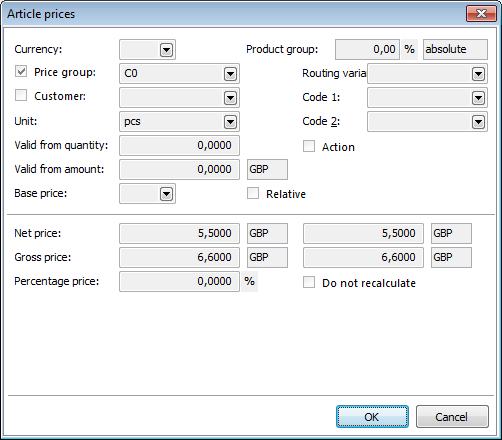
Picture: Article prices form
Description of Fields:
Currency |
The currency in which the price is specified. If this currency is the same as the basic currency, it does not fill. |
Price group |
A price group from which the price will be derived. If you check the field for price groups the field Customer will be inaccessible. |
Customer |
You can select a customer whom this price will be valid for. If you check the field for a customer, the field Price groups will be inaccessible. |
Unit |
The prices that are displayed in the lower part of the form are related to a selected unit. |
Valid from quantity |
Quantity of articles from which above (including) the price is valid. After setting an appropriate quantity, the field Valid from amount will be calculated by multiplying of the fields Valid from quantity and Net price. Attention: When you enter the quantity, it is suitable to cover the whole interval, i.e. to create 2 records: for 0 - p and for 10 and more with a different price since 10 pc. Otherwise the price according to price category will be entered for less quantity. |
Valid from amount |
The field is filled in depending on the value of the field Valid from quantity automatically. |
Base price |
The price group from whose price the surcharge is based on. If the field is not completed, surcharge is related to a Selling price from the 5th page of the Article card. |
Action |
The field has no effect on K2. |
Relative |
By checking this field you enable to calculate the price at the time of its use. A relative price is defined by a percent of Basic price and its particular value (how it would be calculated at the moment) is displayed in a Browse mode. If the field is not checked, it deals with an absolute price which amount is fixed at the moment of inserting and it remains the same unless it is changed manually or calculated in bulk. |
Routing variant |
Routing variant of a product or semi-finished product for that the price is valid. This field is able for a user identification, K2 standard does not work with this field when price is created and inserted in documents any more. |
Code 1 |
Possibility of code settings. It is important for a user identification. |
Code 2 |
Possibility of code settings. It is important for a user identification. |
Net price |
Net price is entered after the Article field is filled in as a selling price from the Article card automatically. Here it is possible to set other price than it is given on the Article card. The change will take effect in the fields Valid from amount, Gross price and Percentage price. Note: If a foreign currency is entered in the Currency field, an amount in this currency is entered in the right part of the field Net price. Recalculation of foreign currency is executed according to the current exchange rate. |
Gross price |
Also, the gross price is automatically set after you fill in the Articlesfield as the selling price of the Article card after adding the relevant VAT rate. The change of Gross price will take effect in the fields Valid from amount, Gross price and Percentage price. Note: The way the price is displayed corresponds with the net price display. |
Percentage price |
The percentage price indicates the percentage to be added to the original selling price defined on the Article card or to the price according to the price group specified in the Basic price field. You can set the percentage price with a negative sign, and the original selling price will be decreased. If you set the percentage price, the field Valid from amount, Net price and Gross price will be changed. |
Do not recalculate |
Check to specify that the price is entered manually and should not be recalculated. The price is not deleted not even in the case when you check the Delete current price groups/customer prices field during the price recalculation. |
Its are prices whose are valid at concrete date. Date prices are defined by the same way as selling prices on the 5th page of the Article card with the difference that you enter Date (date from) and Valid to (date to) in the Price list preparation form, that means in which interval is price valid.
Except this entered interval is given by so called current prices, where date doesn't define (that means it is display in format 0.0.0000). Current price will create automatically with creating article card. This price you can only edit, not delete.
In order date price will automatically inserted to an invoice out, you need to checked the field Use date prices of articles on-line in the Client parameters.
You find detail description of work with date prices in the chapter Price Creation methodology in K2 IS.
Stock turnovers (6th page)
Overview of article turnovers by periods per period and stock is displayed on the 6th page of Article card. Selection of displayed interval and stock is started in Browse mode by pressing Alt+F10 key. Interval and abbreviation of stock will be displayed in upper blue bar.
Summation data is displayed in the upper part of the 6th page of Article - Op. level, Turnover, Balance, Cl. level.
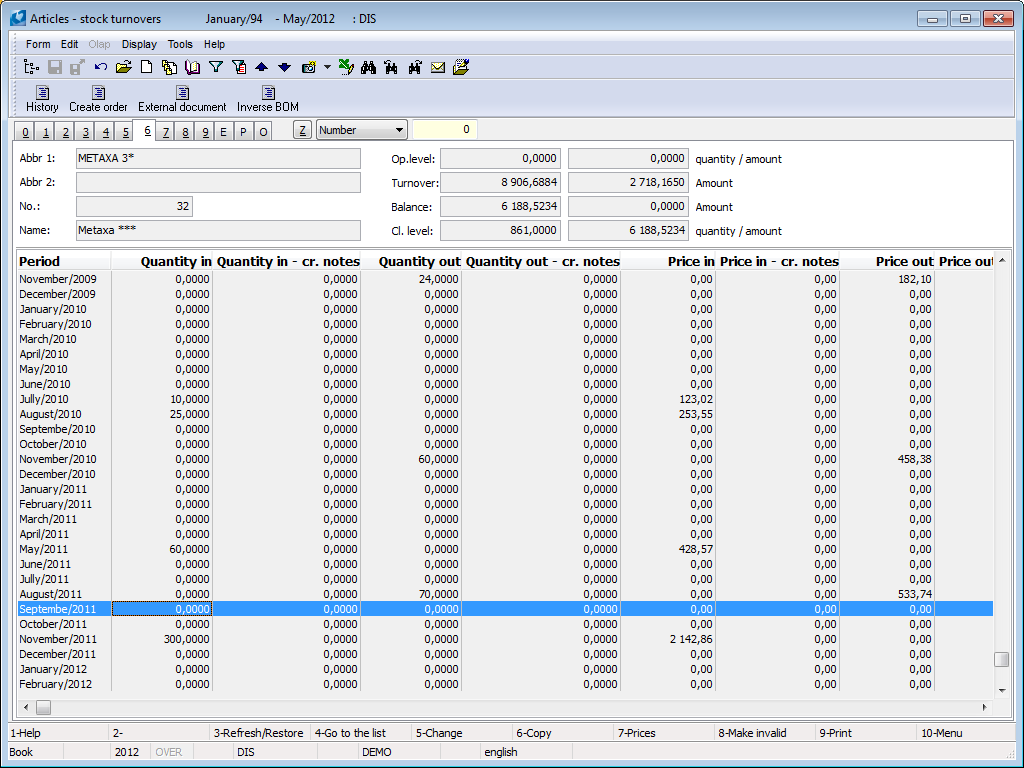
Picture: Articles - 6th page
Description of selected fields:
Quantity In |
Quantity of receipts (positive movements on receipt documents) |
Quantity In - cr. note |
Quantity of receipts on credit notes (negative movements on expense documents) |
Quantity E |
Quantity of expenses (positive movements on expense documents) |
Quantity E - cr. note |
Quantity of expenses on credit notes (negative movements on receipt documents) |
Calculation of movements to sum of turnover in header
Negative movement does not increase the turnover, but only decreases the relevant side of turnover. It follows that credit notes for stock documents should only be used to correct the original movement.
Movement |
Calculation into the sum of turnovers |
Receipt by Receipt card |
positive value on the receipt side |
Release by Release note |
positive value on the release side |
Receipt by Release Note |
negative value on the release side |
Release by Receipt card |
negative value on the receipt side |
Suppl./cust. turnovers (7th page)
On the 7th page of Article card the suppl./cust. turnovers are displayed namely in case that the field Customer record / article record in the client parameters. Selection of displayed interval is started in Browse mode by pressing Alt+F10 key.

Picture: Articles - 7th page
Stock card (8th page)
On the 8th page of Article card the stock movements of article will be displayed in a selected business year and warehouse. They will be automatically updated by a stock document confirmation or by a Stock recalculation. Set period and stock is performed by pressing Alt+F10 key.
In the header of a stock card, the summing data (Op. level, Turnover, Balance, Cl. level) is displayed.
A stock movement is realized by the following documents: Receipt card (RP), Release note (RL), Transfer note (TR), Job card (JC). It is possible to switch directly to the particular document by pressing Enter key on the appropriate line. By pressing Ctrl+F5 keys, it is possible to change the confirmation date of document from the currently highlighted line. After making the change, the line automatically moves, the ruler stays on the changed record.
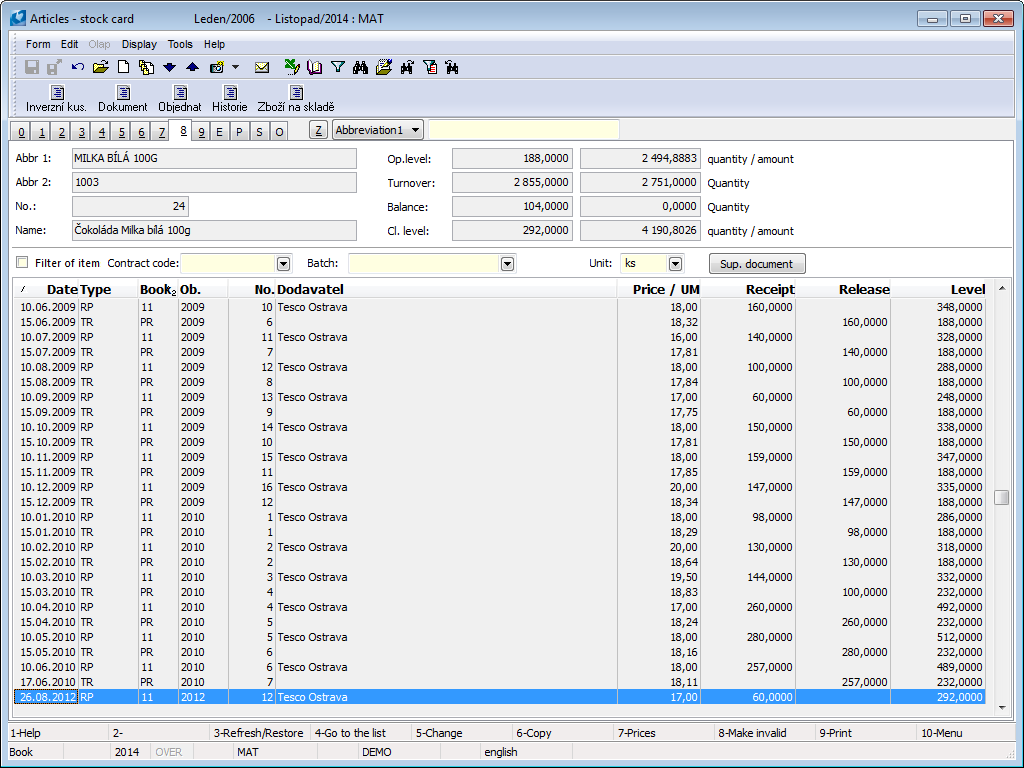
Picture: Articles - 8th page
By pressing Shift+F6 keys, you can select between displaying in quantity or in monetary amounts. The change of displaying will take effect in a header of a screen in Turnover and Balance fields and in a Receipt, a Release and a Level columns.
By checking the field Filter items you can define filtering of documents according to the contract code or the batch, or by their combination. By pressing the right mouse button on the Contract code and Batch fields and by using the function Copy from current row you can fill quickly the fields with values from item that is marked at the moment (you can use it for searching associated movements e. g.). Use the Internal transfer notes option to specify whether or not the movements of internal transfer notes (transfer notes within one warehouse) will be displayed.
Furthermore on this page, the field Unit is available where you can select the basic unit in which you want to display the values. You can select them from active stock units defined on the Article card.
By pressing the Sup. document button you will display these:
- a purchase order for a receipt card,
- a sales order for a release note,
- a superior sales order or a superior job card for a job card or a transfer note.
The adding of the stock movements into the summing turnover in the heading with regards to credited items is described in the Stock turnovers (6th page).
Ext. documents (9th page)
On the 9th page of Articles you can assign ext. documents or documents to an appropriate articles as in other modules. In the case of article it may be, for example, the attachment of instructions, declaration of conformity and other items. Further description of work with external documents is stated in the chapter Basic Code Lists and Supporting Modules K2 – 9th Page.
Articles - Parameters tab
The tab enables to register the structured information of technical character to the Article cards - so called Parameters. Their list can be created separately for each card by Ins key, or it is possible to use predefined lists - so called Classification. This predefined list on the Article card you can any complement by other parameters (this inserted parameter will have flag of manual insertion) but these parameters will remain on the card only in the case they will be filled with a value. Each parameter on the Article card or in Classification has to have assigned the Group from list of groups. The parameter can occur only once on the one Article card or in one Classification.
If you change Classification on the Article card, a list of the parameters will be changed automatically. But the parameters with filled in values remain as manually inserted.
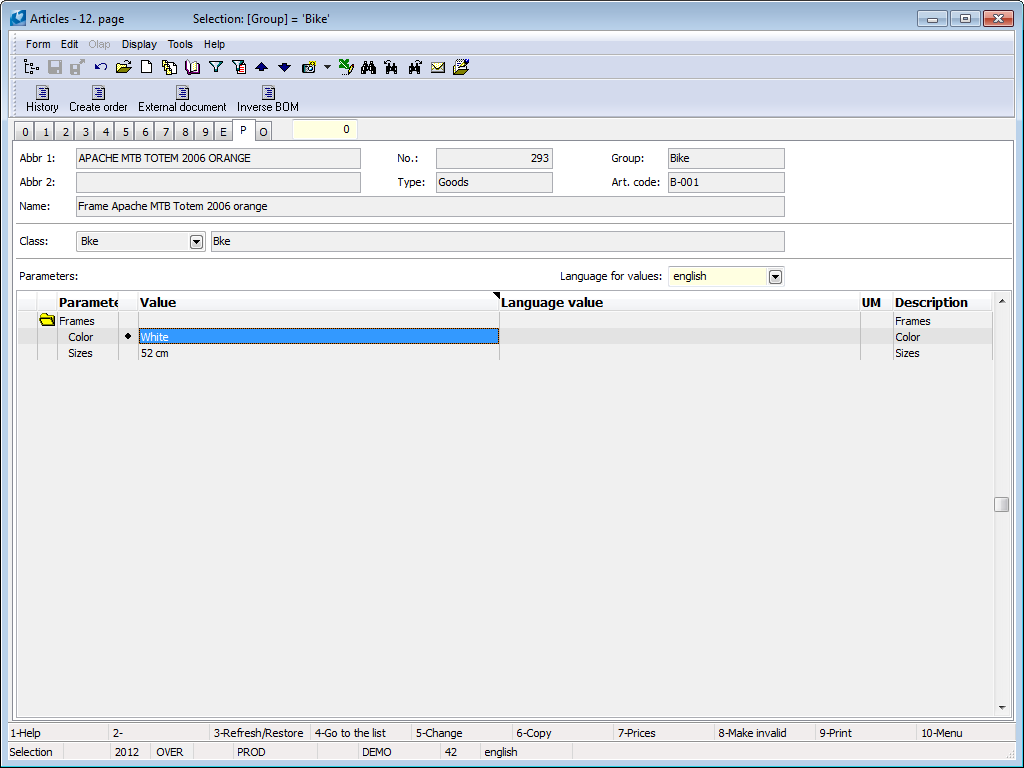
Picture: The Articles book - Parameters tab
Editing of the parameter values
The parameter values you can change by three ways:
- During the inserting of free parameter you enter the value directly in form for selection of parameter.
- You edit the particular parameters by so called line editing - in the column Value you press Enter key, you enter/select required value from the list and by Enter key you confirm entered value. At parameter with option of enumeration values the same form opens as during the inserting of parameter (point 1). In a list of the values you mark values, which are valid for appropriate goods. By pressing of the button OK you close the form. These selected values, consecutively separated by semicolon, will display in the column Value.
- If you enter all values to the one group, you could use form for entering of more values at once. On the group you press combination of keys Shift + Enter. The form to enter the parameter values will be displayed in the group. Here you can enter the required values directly to the fields Value to the particular parameters. You can open the list of predefined values by F12 key in the case of order (selection of a list or enumeration values). You can choose the value by Enter key. You can mark the required values at enumeration
 and you can close the list by Enter key or Tab.
and you can close the list by Enter key or Tab. - Also you can use this variant in case that you enter so called the comparative values at parameter or you want to change unit of parameter value.
Note: Comparative value - there are parameters whose value develop so much that the previously used unit is no longer practical (clear) and in some cases another unit is mentioned. However if you want to search according this parameter, subsequently for example in e-shop, it is necessary that the system compares absolute value in the same unit. "Hard drives" are the examples. Previously their capacity was stated in "GB" (gigabyte) but today the common capacity is in "TB" (terabyte). Therefore you can state the value "1 TB" to the disc and write the number "1000" to the comparison value.

Picture: A form for entering the parameter values in the group
In Classification in the Change mode, it is possible to move the item (parameter or group) on which the ruler stays, using the gray + and -. The parameter form can be displayed from the 1st page of the Classification or in the table on the 'P' page using the Ctrl+Shift+Enter keys.
By the Parameter the properties that are related to an Article card are registered. The colour, weight, material, length, speed, Supported file formats etc. might be an example.
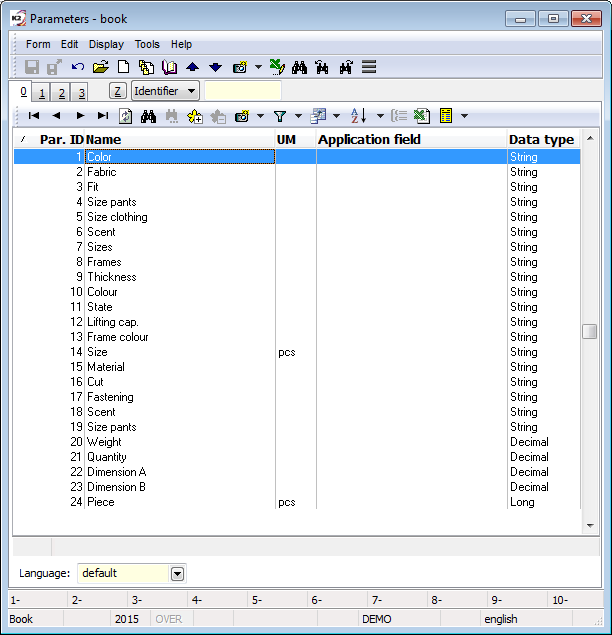
Picture: The Parameters book
The Basic Data tab of the Parameter tab is used to define the properties of the parameter.
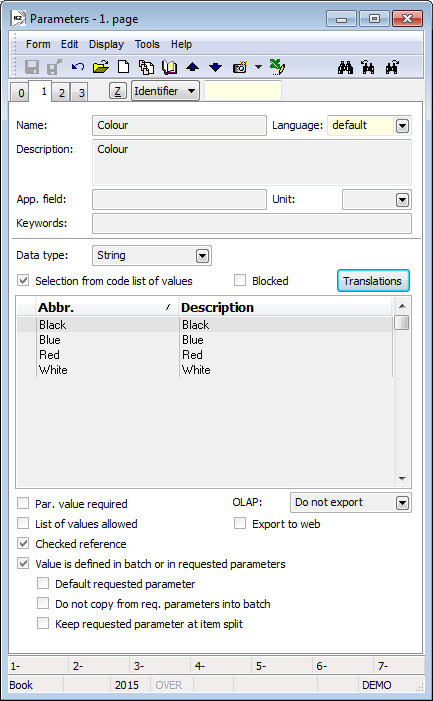
Picture: The Parameter book - Basic data
Description of Fields:
Name |
The parameters name. |
Description |
The description that can be exported e. g. to the e-shops as a explanation of a parameter content. |
App. field |
Working description for a better orientation among the similar parameters, it can briefly summarize the parameter setting. |
Unit |
The link to the code list of unit parameters. If it is filled in, it has to correspond to the record from a code list. |
Keywords |
For the export possibility to e-shop. |
Data type |
The kind of an expected value. Text, Integer number, Decimal number, Date, Time, Field from article card are offered. If the number is selected, next field is displayed and you can define a number format there. In the case of the Field from article card option the next field will be displayed too, and you should select to which field or note the parameter would refer from an Article card. You can use a linkage field too, in this case the link is indicated by semicolon. The link to a note type is written as "P@type" of a note, also e. g. to a business text you can link by "P@DH". |
Selection from code list of values |
The option provide a possibility to display to an user the list of predefined values. |
Par. value required |
If a parameter is obligatory, the Article card, where this parameter is inserted by the Classification, can not be saved without filling of a parameter value. This applies only to users who have the right to fill in the parameter values. |
The value is defined on the batch or the required parameters |
This option does not allow entering parameter values on the 'P' page. To distinguish individual article deliveries or production batches, you can enter values directly on batches. The parameter is therefore not generally valid for articles. The Batch Type is also saved internally in the batch. The Classification with parameters containing the flag "Value is defined on the batch or the required parameters" will be generated by the new batch type with each relevant change of the Classification (i.e. especially items) or parameters (flag, data type). Without this symptom, old batches would report an inconsistency in this case. |
Default required parameter |
The parameter with this option will be inserted by default when the newly created required parameter is created on the P/S item in the Parameters tab. The option is active only if the option Value is defined on the batch or the required parameters is checked. |
Do not transfer from the required parameters to the batch |
A parameter with this option will not be transferred from the required parameters to the batch when it is created (e.g. by receipt confirmation) and will not be displayed on the 'P' page. The option is active only if the option Value is defined on the batch or the required parameters is checked. This parameter can be used as an auxiliary parameter when defining a multidimensional quantity. |
Keep the required parameter when splitting the item |
Selecting a parameter causes the values to be copied to the newly created set of required parameters when splitting the purchase/sale items. We recommend to check the option for such parameters for which you do not want to lose their values when splitting the item. On the contrary, for parameters that explicitly require re-entry of values after splitting the item, this option does not have to be checked, but we recommend to check the Compulsory data option for such a parameter so that in case of omitting to enter a new value, the document with empty value is not confirmed. |
List of allowed values |
It enables to select and mark more values, that the Article card fulfils, from the list of predefined values. This possibility is useful e. g. if you want to create the list of supported picture formats for cameras. In the predefined values you can define all known and used picture formats and then at a concrete camera you can mark all these that the camera can create or process. |
Checked linkage |
It solves the ability for the user to enter a value other than the predefined value when selecting predefined values. In the case of enumeration the control is obligatory, that means it is possible to select values only from the list. |
Export to web |
It helps to ignore or place the parameter in the export to the e-shop. |
OLAP |
This option provides the ability to export parameter values as OLAP dimension. |
The list of Groups and the list of Classifications where a parameter is saved as a predefined is displayed on this parameter page.
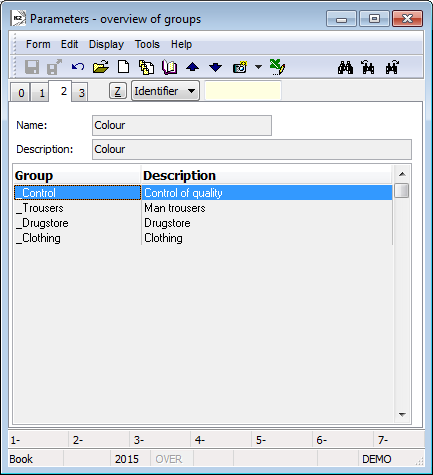
Picture: The Parameter book - Places of use
Parameters groups have got a double meaning. It enables to sort the list of the parameters in the Classification or on the Article as they belong logically to each other. In this case you can insert a parameter and than you can choose an appropriate group.

Picture: The Parameters groups book
The second option is to use the meaning of the group, which we often use for the same list of parameters. For example the group Packaging always contains the same parameters: The English instructions (yes/no); Box size (small, middle, large); Packaging content (text string for listing content). During the setting up of the group you directly add these parameters to the group. Any time in the Classification you want to describe package, you insert all group with predefined parameters.
You insert the parameters to the list by Ins key, you delete by Delete key. You can edit a parameter order by Gray Plus and Gray Minus. That group will be visible on the 2nd page on the parameters used in the group. Updating the list of parameters in a group will not affect any existing classifications.
The Class predefines the list of parameters, their class to the groups and determining the order, in which they will be displayed. You can use the predefined class on a random number of the article cards.
Basic data
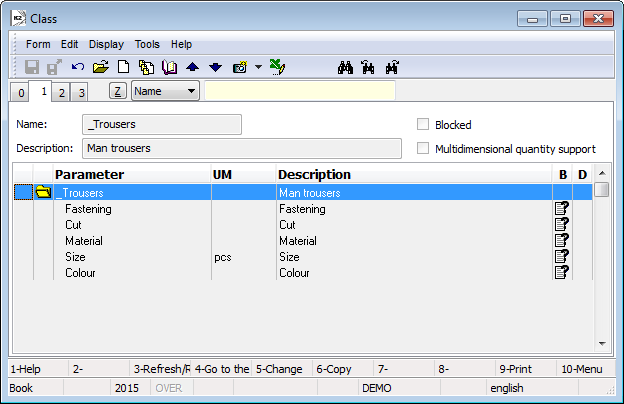
Picture: The Class book - Basic data
Into the table you can insert the list of parameters which are divided to the groups (marked ![]() ). Two options are available:
). Two options are available:
- You can insert them one by one by Ins key - to select parameter, to assign a group to it and to insert into the list by OK button.
- The second option how to use the predefined lists of the parameters in the groups - press Shift+Ins keys, choose the one from the list of groups and insert it into Class. The group with all its predefined parameters will be inserted. However, we do not have to follow the order of parameters or the content of group, the groups are used only for simplified insertion.
You can randomly delete the parameters by Delete key. By the same way you can delete the whole group - just press the Delete key when the light indicator is positioned on the group. You can randomly edit the order of parameters by the Gray Plus and Gray Minus keys. Later change of Class will be displayed to the article cards where the class is used.
Fields Description:
Blocked |
Block / invalidate Class. |
Multidimensional quantity support (VRM support) |
If there is at least one formula for multidimensional quantity on the 3rd page of the Class parameters tab, then the program automatically activates this option. For a more detailed description of the meaning and use of a multidimensional quantity, see the Basic code lists and Supporting Modules K2 / Articles / Articles Methods / Multidimensional Quantities. |
By clicking on the parameter, you will display a form with setting options for the e-shop:
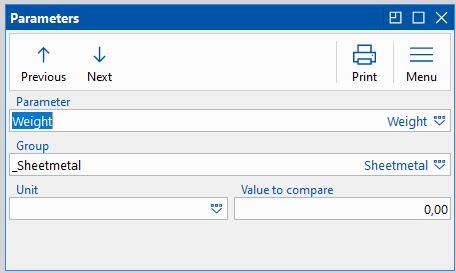
Picture: Parameter class
Fields Description:
Lower value in the parameter value is better |
It is not implemented |
Higher value in the parameter value is better |
It is not implemented |
Parameter to distinguish article variants |
Parameter to distinguish article variants on the 3rd page of an article card. |
Do not show in internet shop |
The parameter does not appear in e-shop. |
Formulas for VRM
On the Formulas for VRM tab, you can add formulas for multidimensional quantities.
Description of Fields:
Unit |
Specifies for which stock unit the formula applies. In the case of activated option Valid for release or Valid for receipt the formula is used in the case of agreement stock unit with unit in the sale or purchase item. In the case of activated option Formula to determine coeff. the stock unit is important if the same unit is selected by the user in the Batch book - then the quantitative values (Disposition, Assigned) are recalculated based on the coefficient in batch. |
Formula |
Formula for calculating the value. Enter individual parameter identifiers (e.g. V67) to the field. |
Variables for entering quantities |
Here are those variables you need to enter on the Purchase / Sales item (in the Multidimensional quantity form that we call the Quantity button). |
List of available variables |
List of parameters, which a user has defined in the Class. |
Formula to determine coefficient |
If the option is enabled, then this formula calculates coefficient to convert the quantity between the base and the alternative stock unit. This coefficient is saved when a batch is created. It is always calculated regardless of the stock unit, the meaning of the unit input is described above for the Unit field. |
Valid for release, Valid for receipt |
This formula will be used for release or receipt, if the specified unit matches the unit in the sale / purchase item. |
For a more detailed description of the meaning and use of multidimensional quantity, see the Basic code lists and Supporting Modules K2 / Articles / Articles Methods / Multidimensional Quantities.
In the universal interface, bulk change Change Article parameters is available, which can be used to change the Article parameters.
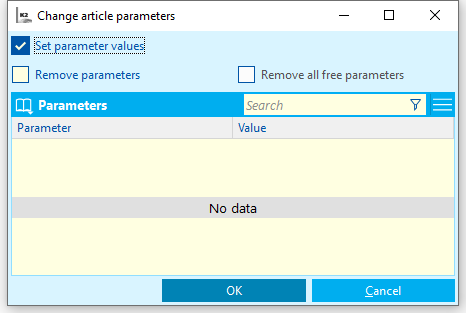
Picture: Change Article Category
When you set values, the parameters are inserted with the Ins key, and after selecting a specific parameter, a form is displayed to specify the settings for bulk value change.

Picture: Edit parameter values
You can select a group to add a parameter. If the group is filled in, then if the given parameter is not on some Article, it is added as a free parameter to this particular group. If it is not filled in, then the parameter is not added (only the value will change if it already exists on the Article).
If it is a parameter with a possible enumeration of values, there is an option to check the box Add to list of values, when it is checked, the value will not be overwritten, but will be added (if it does not already exist).
You can set a specific value to compare in the Value to compare field.
Articles - Complaints and Services (S page)
On the 'S' page of Articles tab, the records of service sheets, defects, service operations that are released for these articles are displayed.
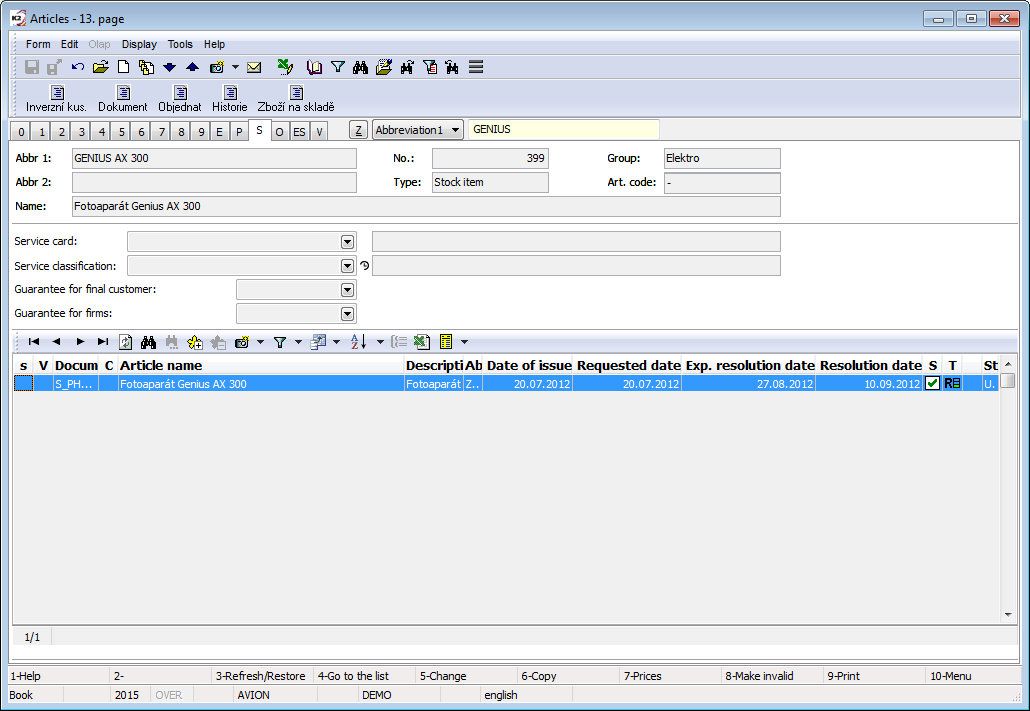
Picture: Articles - "S" page
Description of Fields:
Service card |
Assigned article card, which has the routing variants of product repair defined. |
Service classification |
Assigned service classification with parameters which will be in the Parameters tab in service toolbar. |
Guarantee for the final customer: |
Length of Guarantee period. If the customer does not have the Comp. Reg. No on the Suppl./Cust. card, the length of the guarantee is preset to the sales item and subsequently it is necessary type of service (Guarantee/ Post-guarantee) in the case you create a service sheet above the sales item. |
Guarantee for companies: |
Length of Guarantee period. If the customer has the Comp. Reg. No on the Suppl./Cust. card, the length of the guarantee is preset to the sales item and subsequently it is necessary type of service (Guarantee/ Post-guarantee) in the case you create a service sheet above the sales item. |
Articles - view (page O)
If you check the Display page O - Olap views in User parameters, than you can create views in OLAP important for K2 IS data evaluation on the "O" page.
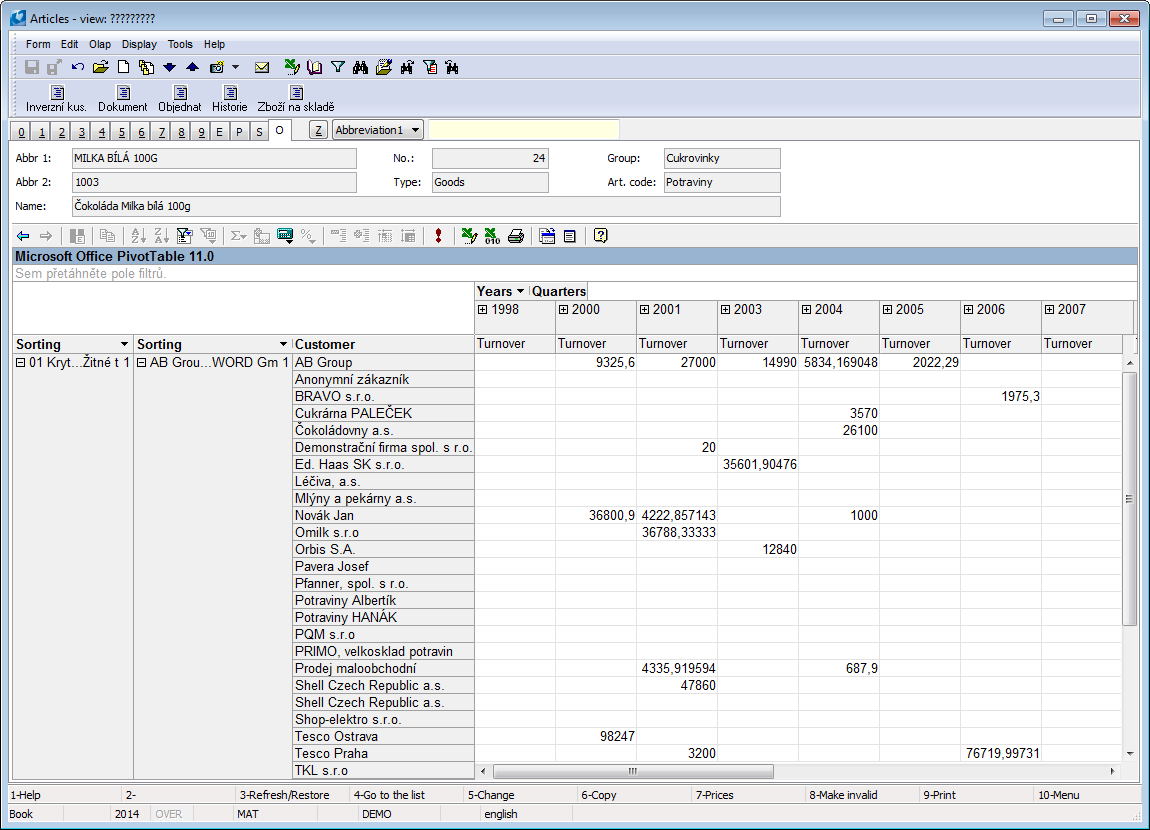
Picture: Articles - page "O"
Articles - page ES
The E-shop tab is intended for the specification of all data on articles sold on the K2 E-shop. The page is visible for a user who has the right to Browse the ES page in the book of Articles in the section Webs and E-shops - Articles - Browse the ES page in the book of Articles. Only those users who have the right to Change the ES page in the book of Articles (Webs and e-shops - Articles - Browse the ES page in the book of Articles) can change the data here.
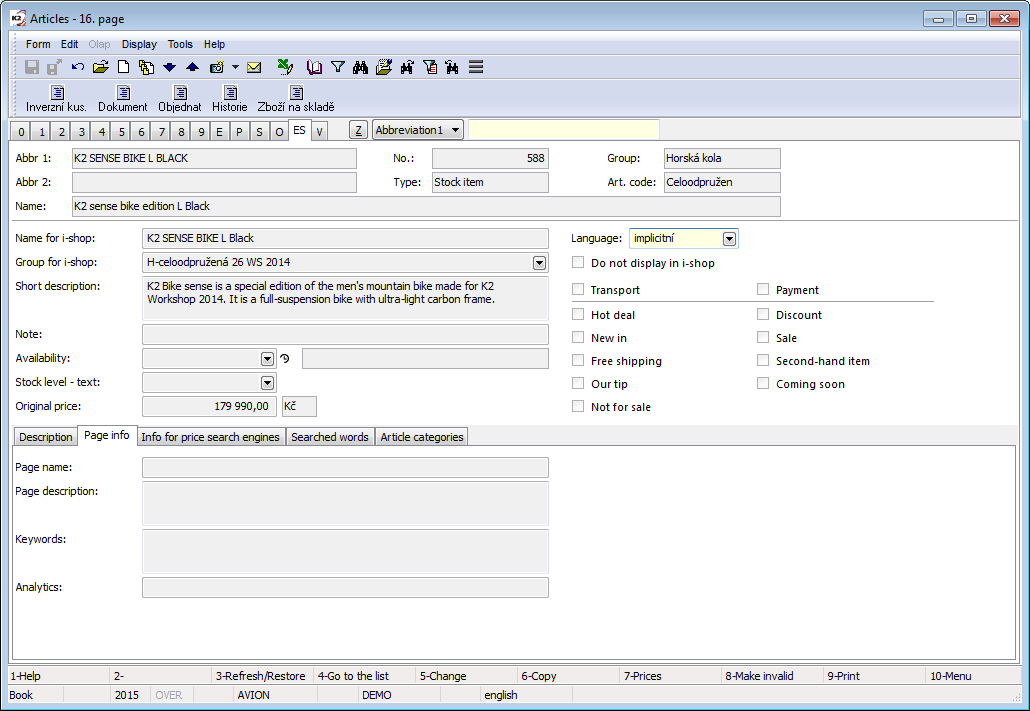
Picture: E-shop tab
Description of Fields:
Name for e-shop |
The unique name of the article, which will be used to name the article in the e-shop. |
Group for e-shop |
Group of article to classify the article to e-shop. |
Short description |
An article description that informs what the product is about and why the customer should buy it. It is displayed in the detail in the product catalogue just below the product name. |
Note |
The text of note will be published in the detail of the article, in the pre-basket, basket and comparison. |
Text at zero warehouse* |
The text that will be displayed if the articles are not in stock and at the same time the Alternative text is not filled in. Texts can be suppressed in bulk with the Show actual warehouse statuses flag in the Web and E-shop settings. |
Alternative text* |
The text that is displayed when the warehouse status is specific. Texts can be suppressed in bulk with the Show actual warehouse statuses flag in the Web and E-shop settings. |
Original price |
The original price stated in this field is displayed / hidden in the article detail depending on the - flag Show "original price" in Web and E-shop settings - Catalogue of articles. You can enter the price without VAT, then it is displayed on the e-shop according to the settings for displaying prices without tax or tax. |
Transport / Payment |
The option will be checked in the case of an Article card representing transport / payment. The marking allows the cards not to be transferred to an order created as a copy of another order - then only the Articlecards will be transferred. At the same time, the articles marked in this way will be displayed on the e-shop even if they have a set zero price (regardless of the Do not display articles at zero price flag in the Web and e-shop settings. |
* Text at zero warehouse and Alternative text can also be suppressed with the option Disallow sale of available articles. This can be found in the Web and e-shop settings, on the Article Catalogue tab. The user can thus limit the sale of articles for which, for example, the Text at zero warehouse is set to 2 weeks. In this case, the customer will not have a Buy button available on the e-shop.
At the bottom of the page you will find several tabs:
The Long description tab contains text in which you can explain in more detail which product it is. The long description is displayed in the product detail under the Description tab.
The Page Info tab is important as a so-called search engine optimization. The content of these fields is only the content of the page code for automata. They are not displayed to a normal e-shop / website user, but they can significantly affect website traffic if they are set up correctly.
On the Info for price search engines tab the data needed for the active use of web and e-shop information in various search engines and price comparators are given.
The Search words tab contains passwords that are associated with the articles and according to which the customer can search the web / e-shop. It can be, for example, colloquial names, usual customer typos, but also, for example, 1 + 1 text for free, etc.
On the Article category tab, it is possible to assign articles to a category. If the item has an Article group assigned to it, the category where that group is used is automatically added here. An entry added here using the Ins key is indicated in the table by a manual edit icon ![]() .
.
On the Flags for shops tab you can set flags Hide on e-shop (Articles are not filled into EsGoods and EsGoodsPrice tables after recalculation, then not available on eshop), New, Actions, Discount, Sale, Free shipping, Tip, We are preparing, Used Articles, Non-sale Articles (Articles cannot be added to the basket) and Sale to registered users (Articles are added to the basket only by the logged-in user). The Default category is also set here, which is to be displayed if the articles are included in more than one category of the same web/e-shop. The Inquire only flag has not been implemented yet. All the above-mentioned flags can be set for individual shops manually using line editing. If you exclude the article from e-shop, the line is marked as invalid by icon ![]() .
.
Shift+F8 delete the e-shop on the Flags for e-shops tab
If we cancelled the e-shop and no longer want to see the flag on the articles on the flags for e-shops tab, it is possible to use the Shift+F8 function.
The function is available in the Webs and e-shops books. Above the invalid e-shop / website, press the Shift+F8 keys - this function deletes the records (in the Articles book on the Flags for e-shops tab) for all articles that have been assigned to the e-shop.
The function is active with the right: Webs and e-shops / Administration / Delete web, e-shop data
Note.-
If the articles have been discarded firstly, i.e. the e-shop has a red circle flag (see above), after paying the e-shop, then the article will not be assigned back to the e-shop.-
If the article is still connected to the e-shop and you use the Shift+F8 function, after validating the e-shop (and starting the recalculation), the article remains assigned to the e-shop.
In the "Alternative warehouse texts" code list the texts are defined for the various warehouse layouts.
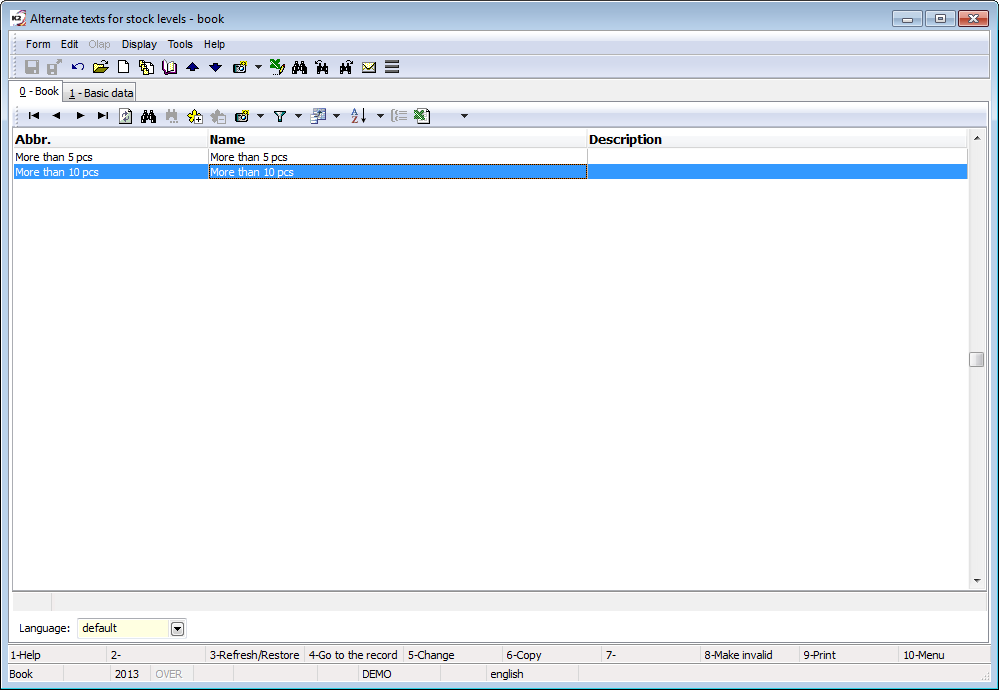
Picture: List of alternative warehouse texts

Picture: Alternate texts for stock levels - Basic data
Description of Fields:
Abbreviation |
Unambiguous identification of alternative warehouse status text |
Number |
Order number of record |
Language |
The language which the alternative texts of the warehouse are modified for. |
Name |
The name of alternative warehouse status text |
Description |
The description of alternative warehouse status text |
Items
On the 1st page in the bottom part are inserted items for the alternate texts for stock levels. Here you can define from what stock available the specific text should display.
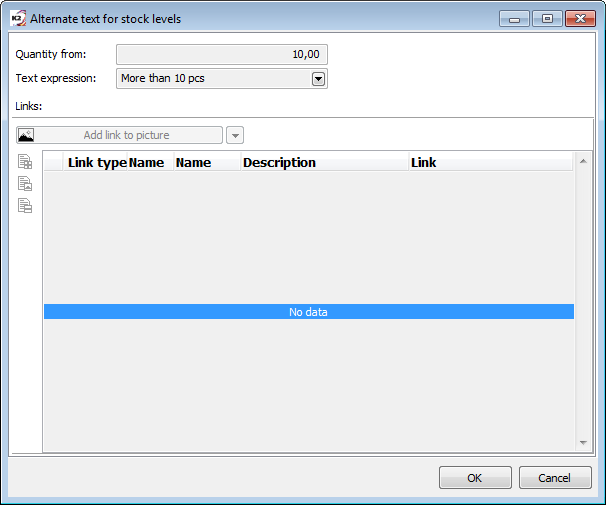
Picture: Alternate stock texts - Basic data
You can assign a custom icon to your own stock levels text. The icon must be added to the alternate text via the "Add link to picture" button as the Main picture - Preview type.
For proper functionality in companies that already operate an e-shop, it is necessary to add 2 lines with image dimensions to the special config_menu.php. Lines can be copied from a standard file
$Img [Image_Type_StockTextImage] ['Width'] = 33; // Warehouse image of alternate warehouse status text
$Img [Image_Type_StockTextImage] ['Height'] = 32; // The height of the image of the alternate warehouse status text
Description of Fields:
Quantity from |
Definition of stock level availability from which the text should appear on e-shop. |
Text expression |
The text which displays on e-shop. |
Evaluation (V page)
On the individual tabs, the user will find various evaluations of the Article card from the point of view of logistics.
The tab contains the following sub-tabs:
- Daily reports: displayed if the user has the right Code lists / Articles / Display daily reports.
- Inventory turnover: is displayed if the user has the right Code lists / Articles / Display inventory turnover.
- ABC analyses: are displayed only if the user has the right Code lists / ABC analyses / Browse ABC analyses.
If the user does not have any of the listed rights, the "V" page will not be displayed.
On the tab, you can find the graphical form of daily stock for the selected period and warehouse (Alt + F10). Daily balances of articles in warehouses are counted using the function Stock recalculation. In addition to the inventory display, you can activate the display of other preset series in the chart:
- Sales: displays the daily value of sales. The calculation is performed from the items of confirmed Release Notes of the currently set warehouse, the decisive date for inclusion in the timeline is the date of confirmation of a Release Note.
- Consumption in production: shows the daily value of factory consumption. The calculation is performed from the items of confirmed Job Card according to the currently set warehouse, the decisive date for inclusion in the timeline is the date of confirmation of the Job Card.
- Minimum level, Maximum level: displays the set minimums and maximum stocks for a given warehouse or period.
All values can be displayed in both quantities and amounts. You can activate the display in amounts using the Show amounts option. The "Sales" and "Production Consumption" series can be displayed as a daily, weekly, or monthly aggregation.
To display, you can specify whether data will be read only for the current card, or whether data will also be read from cards for which the current card is the successor in the successor tree. We influence the loading by selecting Load successor tree.
Note: Negative stocks are displayed in a pale red colour.
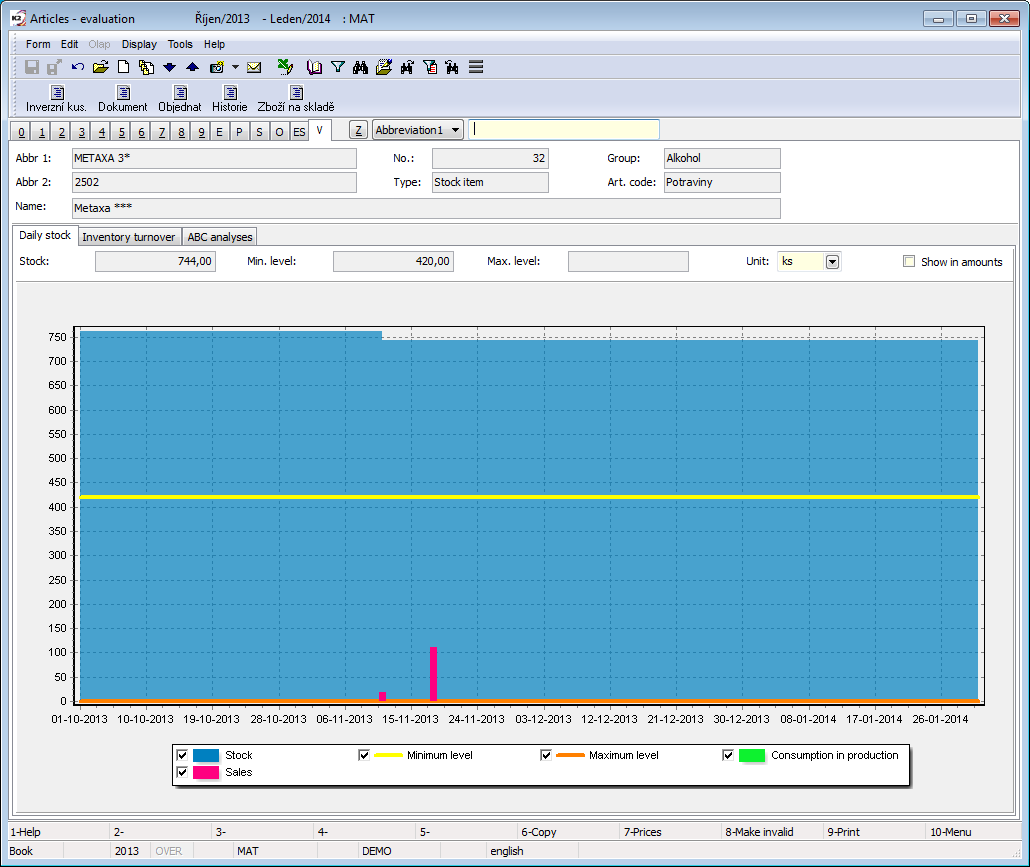
Picture: Articles - page V Daily stock
On this tab, you can find turnover or inventory turnover times.
Inventory turnover
It says how many times the average inventory is reversed for a given period (the period is set in the Configuration). Turnover is calculated as Sales / Average Stock.
Turnover time
It says how long (how many days) one inventory turnover lasts, or how long the average inventory is in stock. The turnover is calculated as Period Length / Turnover.
The user finds the following information on the tab:
- In the header it is possible to define the required minimum and maximum speed, and then the value of the speed from the last calculated default configuration is saved in the Current field. You can set the default turnover configuration by means of this button
 (if the user has the right Code lists / Articles / Turnover configuration - selection).
(if the user has the right Code lists / Articles / Turnover configuration - selection). - The table shows the records of the last calculated turnovers of the individual configurations. The user has all the data needed to calculate the turnover: Turnover in quantity, Turnover in stock prices, Turnover in selling prices, Turnover, Turnover time and in addition a Profit.
- Development of individual values over the history of calculations is graphically displayed in the lower part. Select the displayed value by Display option. If the turnover value is displayed, then in the case of setting the minimum and maximum speed, the minimum and maximum series are also displayed. If you wish to monitor or compare values in the graph for more configurations, you can mark the individual records in the table with asterisks.

Picture: Articles - page V Inventory turnover
Turnover configuration
You can see the configuration overview using the button ![]() .
.
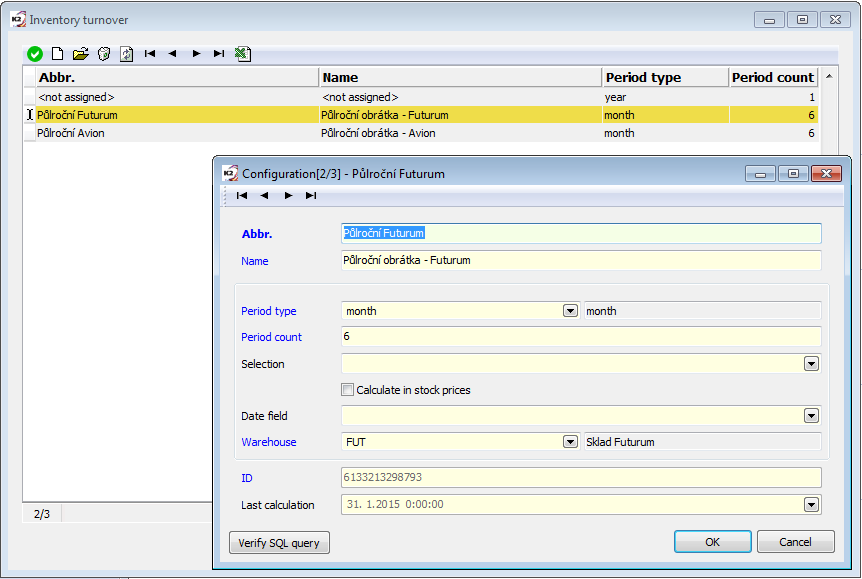
Picture: Turnover configuration
Fields Description:
Abbreviation, Name |
Configuration identification, necessary abbreviation and name. |
Data module |
Select a data module to calculate the turnover. As a data source, you can choose:
|
Type of period Number of periods |
These fields help you to set the length of a period for data loading for calculation of values by the date of analyses calculation. Note: The date on which the turnover is calculated is set in the turnover calculation. |
Container |
The container from a selected data module to determine the range of data (items to be processed). If there is no container selected, all items are loaded with respect to the field filled in the Date field. |
Recalculation of stock prices |
If the option is activated, the turnover will not be calculated from the quantity values but from the stock prices (Turnover in stock prices / Average accounting value). |
Date field |
The date field according to which the time record option will be determined. |
Whse |
Warehouse for which we count the turnover. Summing warehouses can also be entered. Note: The container for items is always automatically temporarily supplemented by a condition for the warehouse specified here. Therefore, it is not necessary to have a whse condition in the conditions of the used container. At the same time, however, the warehouse is used to calculate the average whse, so it must always be entered. |
Last calculation |
By the date, the configuration was calculated for the last time, is displayed here. |
Test SQL Query |
Verifies the validity of the configuration entry - especially whether a valid date field is defined when you enter the selection. |
Calculation
Run the turnover calculation from menu Form / Actions / Calculate inventory turnover. The calculation processes the articles from the container, possibly marked with asterisks.
Two types of calculation with the respect of number of repetition will be done:
- Calculation with repetition, which guarantees repeated loading for various periods. Example: once a year you can calculate the turnover for each month.
- One-time calculation for a one required period. Example: in the beginning of every month you will calculate the turnover for the previous month.

Picture: Inventory turnover calculation
Description of Fields:
Date |
The date, by which the analyses will be calculated. In case of repeated calculation it is important to set the date of the first calculation. If the selection The last day in a month is activated in a setting of repetition, then just the month and the year is important, not the day. |
|
Repeat calculation |
Repeat |
Setting of calculation repetition. The first analysis is done by entered date, the last one by the last possible date before the current date of running. |
|
Every |
You can set the frequency of repetition here. You can select day, week, month as the type of recurrence period. |
|
The last day of the month |
Specifies that the turnover is always counted on the last day of the month. Example: You can calculate the (annual) turnover and always want it on the last day of the month. We will set the date 1.1.2014. Repeat set to 1 month. Activate this selection. The first calculation will take place on 31/1/2020, the second on 28/2/2020, etc. |
The extant of calculation |
All configurations |
By activating, you can determine the calculation of all configurations. |
|
Configuration |
By means of the Configuration button (in the lower part of the form) you can select the particular configuration for the calculation. |
Delete history |
Before calculating the selected configurations, the existing calculation records for the given configurations will be deleted. |
|
The shortcut to calculate turnover
The turnover can also be started using the shortcut Recalculation of inventory turnover, which can be started as a button from the desktop or included as an automatic action in the Task Scheduler. The shortcut can be used only for a one-time turnover calculation, without the possibility of repetition. Closer description is in the chapter Administration/System/Task Scheduler Administration/Standard actions.
It contains information resulting from the calculation of ABC analyses.
- The list of all calculated configurations of the current analyses is stated in the table.
- The ABC group field is in the header bar. It is necessary to set so called default configuration if you want to save the appropriate ABC groups to Article card. This can be set on this tab by the button
 (if the user has the right Code lists / Articles / ABC analyses configuration - selection). In this case, the group from the current (last calculated) default analysis is then save in the article header.
(if the user has the right Code lists / Articles / ABC analyses configuration - selection). In this case, the group from the current (last calculated) default analysis is then save in the article header. - If the Predefine ABC group option is not activated on the Article card, the resulting group will be also written into the next field. However, this field can be redefined by the user to another group (e. g. due to the goal where we want the Article to belong, etc.). In this case, it is no longer overwritten during the calculation.
- At the bottom there is a chart showing the history of the development of the monitored values for the currently marked configuration. If you wish to monitor or compare developments for multiple configurations, just mark these required ones in the table with asterisks.

Picture: Articles - page V - ABC analyses
Articles - EKO-KOM packaging (only universal forms)
The EKO-KOM packaging tab and related books and code lists are only available in universal forms. The EKO-KOM packaging tab is available on the Sale tab in the Articles book. It records possible packaging for Articles and is important as a basis for the Eko-Kom report. For further description see the chapter Sale.
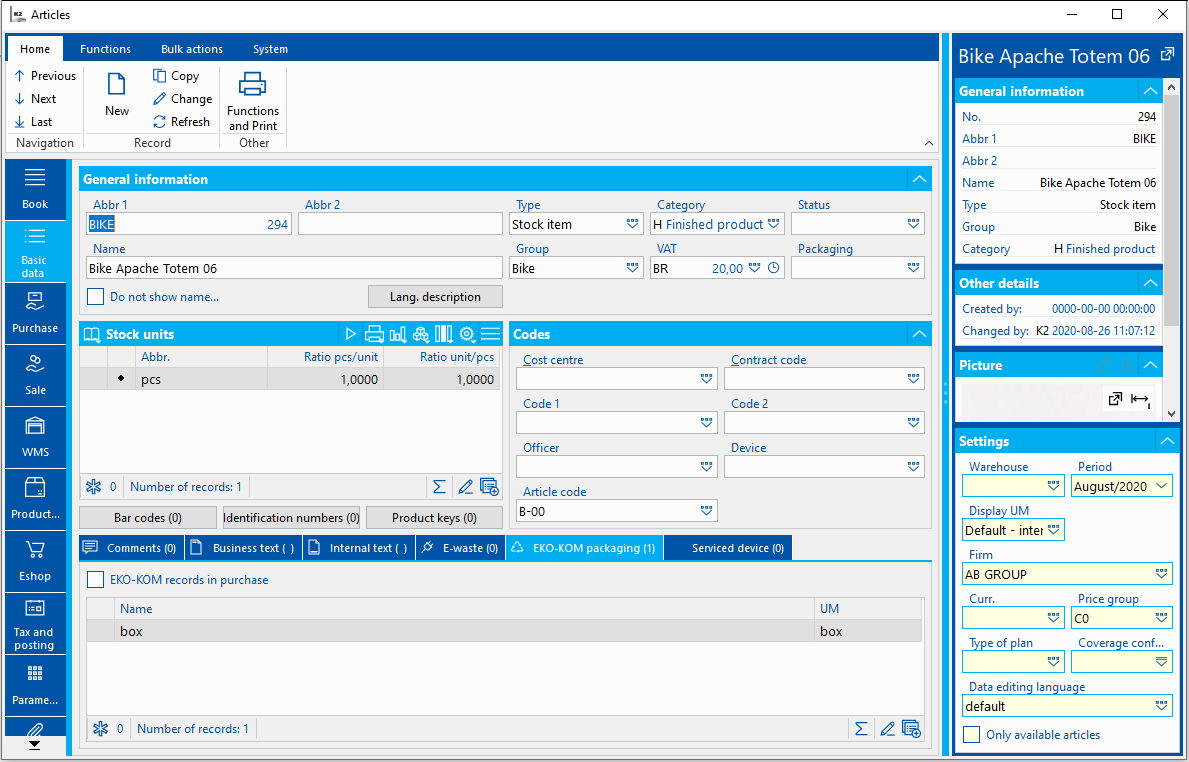
Picture: The EKO-KOM packaging tab
The EKO-KOM packaging tab contains the list of all packages for an appropriate article. Records are selected and defined in the book EKO-KOM packaging. You can enter as many records on the Article card as there are types of packaging related to the sale of these articles. For each basic or alternative storage unit, all packaging that is used for that unit must be defined.
Functions over Article database
Functions description:
F7 |
Displaying prices of a concrete article for individual price groups in the Article price in Browse mode form. You can select a customer whose customer prices should be displayed. The function consider neither the data prices nor the checked option Customer prices in product group. |
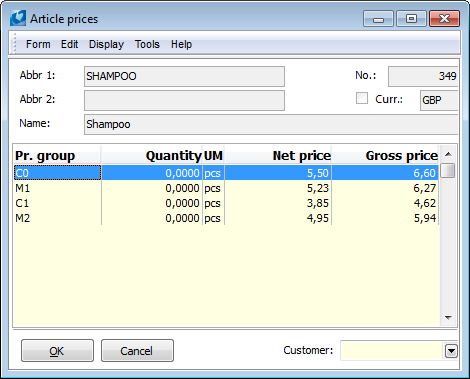
Picture: The Article prices form
F8 |
Function for make invalid/valid record. Make record invalid means that in the Book mode the cards are not visible and are accessible only in All mode. Up on the 1st page of the card a red check mark is visible and next to the field Abbr 1. |
Alt+F3 |
Display the default variation of the routing. |
Alt+F10 |
On 0th, 6th, 8th page the form Set period and stock display where you define period and warehouse. On the 7 the page in the Browse mode the form Set period and stock display where you define period. |
Ctrl+Enter |
On the 4th page in Browse mode displays 1st page of Suppl./Cust. card. |
Ctrl+F3 |
It displays the Location book with information about the status of articles at the locations of the set warehouse (on page 0 for a specific Article card). |
Ctrl+Shift+F3 (only universal forms) |
Starts the recalculation of price lists for the Articles on which we are currently standing. If the Article is included in a product group, product key or category for price lists, then the conversion adds the article to the current price lists that the product keys, groups and categories contain. |

Picture: The Location book
Ctrl+F4 |
It displays the book of Location with information about Article state on the individual batches (on page 0 for a specific Article card). |
Ctrl+F5 |
It displays the book of Contract code with information about Article state on the individual codes (on page 0 for a specific Article card). |
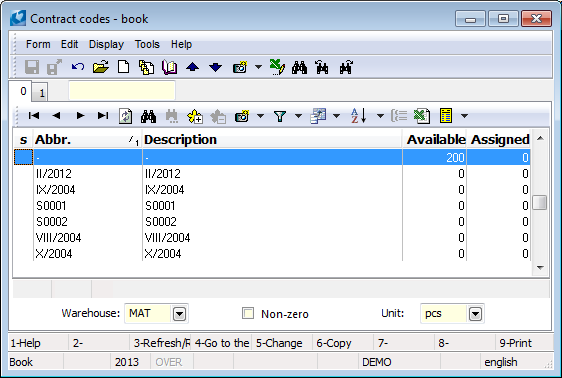
Picture: Book Contract codes
Ctrl+F5 |
It changes date of stock document from the currently marked line on the stock card (8th page). |
Ctrl+F6 |
It displays the Stock wizard, which shows the stock status of the goods in warehouse in the decomposition to the auxiliary stock records - contract codes, batch, location and handling unit (on page 0 for a specific Article card). |

Picture: Wizard
If you display the wizard form from document item (by pressing the button ![]() by Batch, Contract code, Location, Handling unit) you can insert all combination of Sales order, Batch and Location and Handling unit all at once by confirmation of a selected row into the item. If you use the Release entire avail. quantity button, then all disposal of this combination will be automatically entered in the item. If you use this function in a purchase item, then the flag of a negative quantity will be automatically entered as well.
by Batch, Contract code, Location, Handling unit) you can insert all combination of Sales order, Batch and Location and Handling unit all at once by confirmation of a selected row into the item. If you use the Release entire avail. quantity button, then all disposal of this combination will be automatically entered in the item. If you use this function in a purchase item, then the flag of a negative quantity will be automatically entered as well.
Ctrl+F7 |
On 0th page the book Serial numbers in stock is displayed. The history of the serial number is displayed on the 1-History tab. |
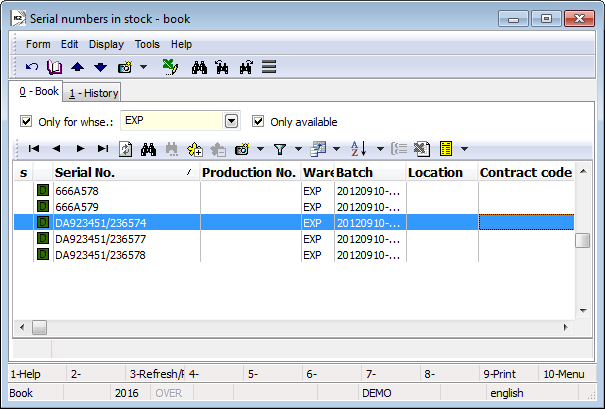
Picture: The Serial numbers in stock form
Ctrl+F11 |
Displays a form with all translated fields on the item. Translations can be changed using Line editing, or if it is a field with a description, you can use the form for editing text with a toolbar |

Picture: The Fields translations book
Shift+F2 |
On the 0 page the Dispatcher function is displayed. Further description is stated in Production - Production planning and supplying - Dispatcher chapter. |
|
Shift+F4
|
On the 0 page the function BOM decomposition is displayed, that serves for creating of item filter from product routing. The container is filled with cards according to the conditions entered in the form. From Obligatory items, Supplements or Substitutions fields must be activated at least one. |
|
Routing variant |
Selection of a routing variant. |
|
Filter of cat. |
It reduces BOM decomposition only to the specified species. |
|
Kinds |
After pressing this button the Article categories book will be opened where you can insert Article categories that you want to display in the evaluating filter of article by pressing Ins key. |
|
Obligatory items |
In the container of article all routing items will add apart from substitutions and supplements. |
|
Supplements |
In the container of article the supplements will be added. |
|
Substitutions |
In the container of article the substitutions will be added. |
|
Go through all levels |
It scans all levels of routing variant, i. e. TP semi-finished products. |
|
Products and semi products |
In the Article container the products and semi-finished products will be added apart from inputs. Otherwise only inputs will be added. |
|
Add to container |
Articles that satisfy the defined parameters will be added in the existing container. |
|
Create filter |
A new container with articles that satisfy the defined conditions will be created. |
|
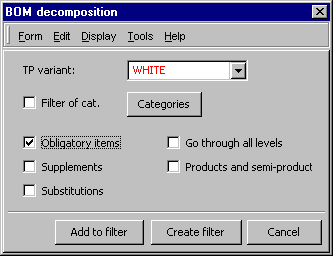
Picture: The BOM decomposition form - Shift+F4
Shift+F5 |
It will display the coverage of demanded articles (page 0) (closer description Coverage is in the Coverage of demanded articles chapter). |
Shift+F6 |
On the 8th page of Articles book it switches display of the Amount and Quantity (see the stock card). |
Shift+F7 |
On the 0th page the Stock levels form and information, where (in which warehouse) and the quantity of the Articles just marked, will be displayed. If we set the ruler on a line with a different warehouse than the one displayed in the Articles book, after pressing the Enter key, this warehouse will also be set in the Articles book. |
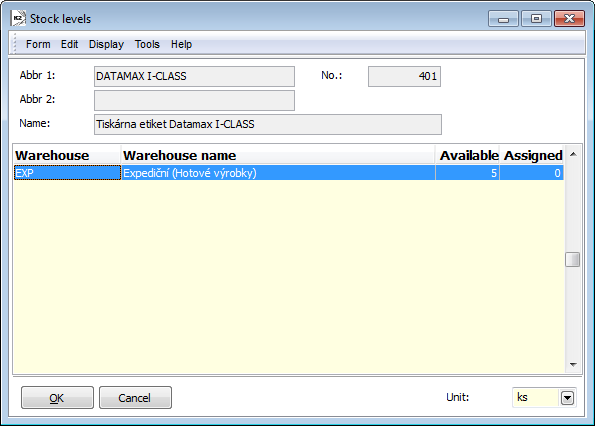
Picture: The Stock levels form
Alt+Shift+F4 |
Filter the Batch parameters (see the Articles - Batches chapter). |
Ctrl+Shift+F4 |
Filter the Batch parameters of selected Article (see theArticles - Batcheschapter). |
Alt+Ctrl+Shift+F4 |
Properties of searched batches over the whole Articles database (see theArticles - Batches chapter). |
Ctrl+Alt+F5 |
The function allows you to select the Status of Article card. |
Module Menu Functions of Articles
Form - Bulk Actions
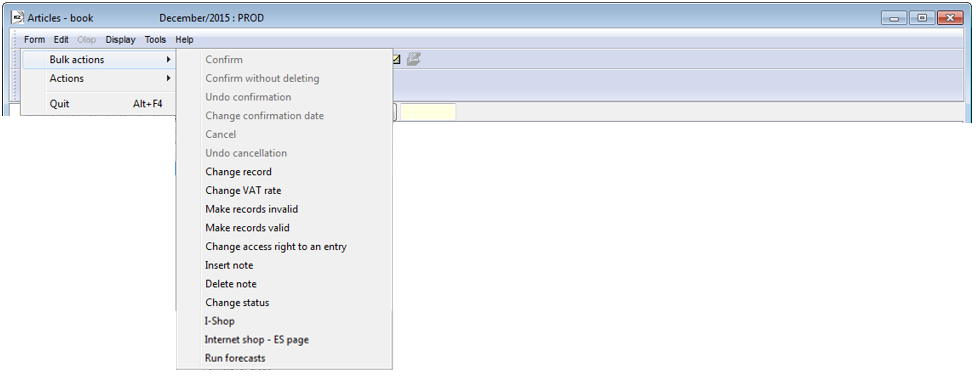
Picture: Form - Bulk actions - Module Menu Functions of Articles
Bulk actions work over a Container state or over records marked with an asterisk.
Actions description:
Change Record |
Enables edit in bulk data of the 1st and 2nd page of selected article cards. Checked option Delete from container performs deleting records from container after launching this action. |
|
Rate |
When changing the exchange rate, the setting of the Currency option on the Article cards is ignored, the change proceeds as if the option is turned off. This means that the values of the prices in the base currency do not change. There is only a recalculation of prices in the currency. Note: To change the amounts so that it is respected whether the Currency option on the Article cards is enabled / disabled, use the action from the menu Form - Action - Change exchange rate with price recalculation. |
|
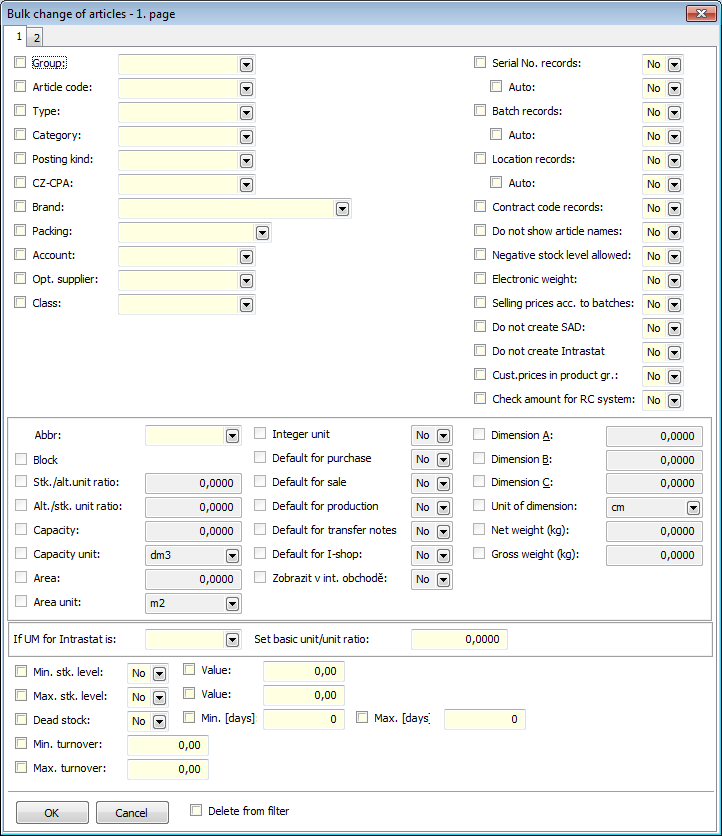
Picture: The Bulk change of articles form - 1st page
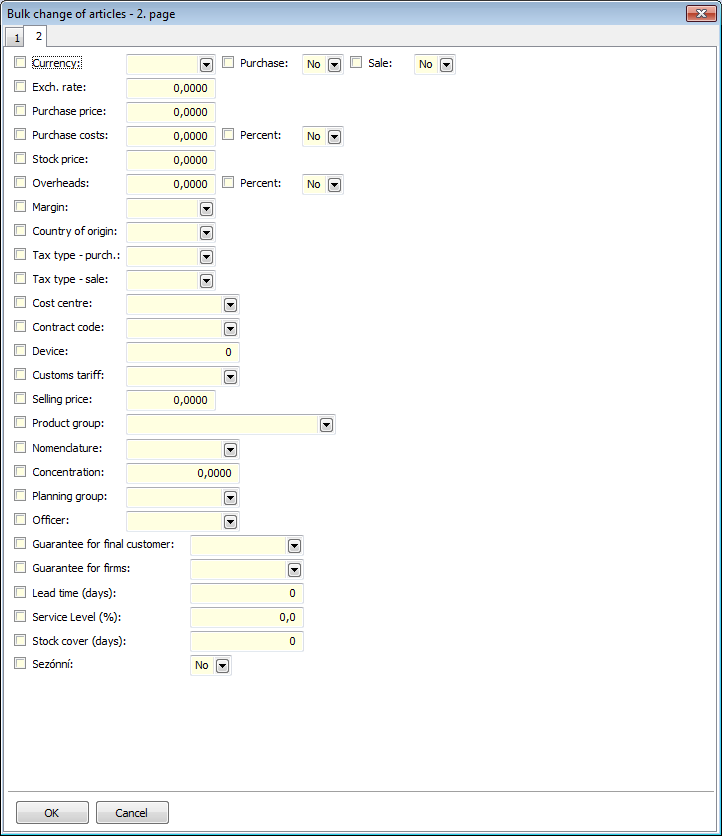
Picture: The Bulk change of articles form - 2nd page
Change of VAT rate |
The feature allows you to change the VAT rate on the Article card with validity from a certain date. Picture: Change of VAT rate form |
Edit article/warehouse data in bulk |
Allows you to add, change and delete records with data for selected warehouses (4th page of Articles, bottom table, the Article/warehouse data tab; e.g. minimum and maximum quantity for warehouses, optimal location, etc.) Picture: Bulk edit of article/warehouse data, the Add action |
Make records invalid |
Function for bulk cancellation of the records with concurrent deleting of the records from filter. |
Make records valid |
Function for bulk cancellation of the records with concurrent deleting of the records from filter. |
Change access right to an entry |
Assign the group of rights for browsing and changing of selected cards. You can browse and change these cards only by the users that have the appropriate group of rights. Other users see only crosses instead of cards. The rights to record are allocated on the 4th page of the Users book. |
Insert Note |
A note of the same type can be inserted to the selected records. Concurrently executes deleting of the records from filter. You can choose notes from the book Kinds of notes. |
Delete Note |
It performs deleting of the selected notes of the appropriate records. These functions are described in Basic function - Module Menu Functions - Form chapter. |
Change status |
It allows to change the Status field of the selected entries in bulk. |
I - shop |
Enables edit in bulk data of the "E" page of selected article cards. The fields, you want to edit, you check in Change internet shop parameters form. For every selected field you set value which you want to entered on individual Article cards or you want to delete from the cards. |
Add / Remove sorting key |
The function enables to add / remove sorting key in bulk for selected records |
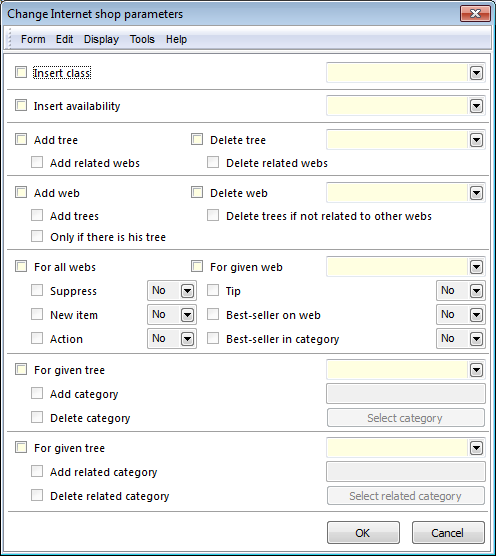
Picture: Change internet shop parameters
Bulk actions for the ES e-shop (ES page) work in the same way as bulk actions for other pages in the Article card. It works above the evaluation filter enabled or the records marked with an asterisk.
On the 1st page, you can change the data of the ES page of selected Article cards in bulk. Check the fields you want to change. For each selected field, set the value you want to have listed on the individual Article cards, and if it is possible to select an action, then choose whether to remove or add the value to the card.
On the Flags for E-shop, you can set these flags for individual or all e-shops.
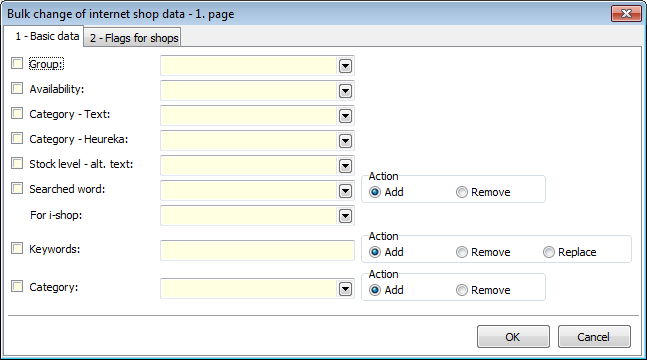
Picture: Bulk change - ES e-shop
Form – Actions
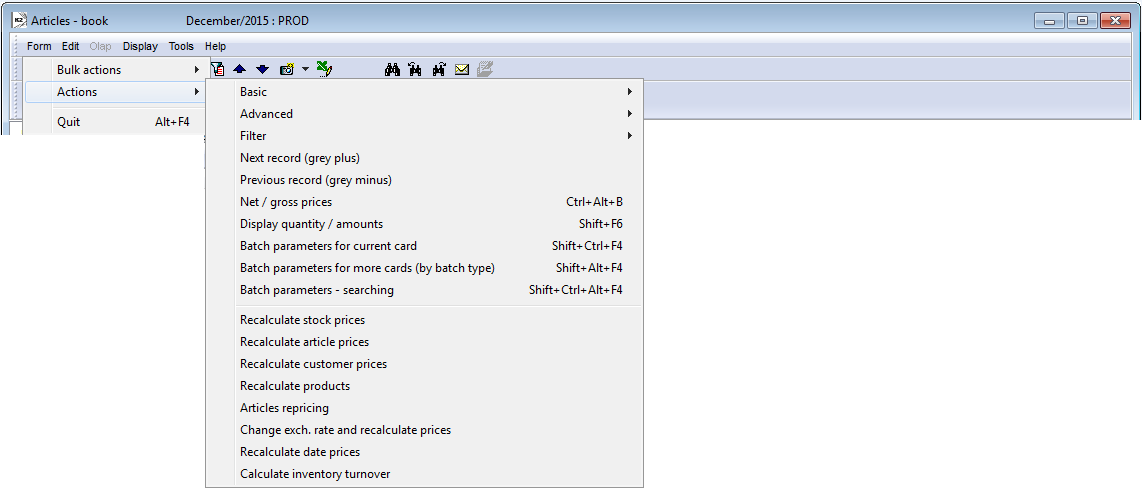
Picture: Form - Actions - Module Menu Functions of Articles
Nett / gross prices |
It affects displaying of Article prices on the 5th page of Article card. For this function you can use the Ctrl+Alt+B keys combination. |
Recalculate stock prices
The function is used to update the planned stock price on the 2nd page of the Article card. You can run this function either over a specific Article or Article container.
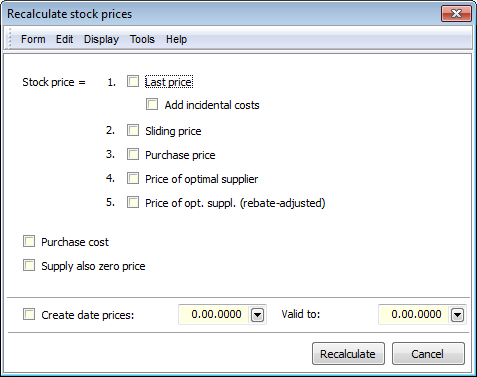
Picture: Recalculate stock prices form
Description of Fields:
The last price, Add incidental costs |
The last price from the 2nd page of Article card will be entered into planned stock price. If the Add incidental costs option is activated at the same time, then the last incidental costs from the purchase item (in the Articles field "CFLastCosts") are also added. |
Sliding price, |
The particular price from the 2nd page of Article card will be entered into planned stock price. |
Price of optimal supplier |
The price from the supplier's price list of the optimal supplier (price list for the given articles on the 5th page of the card of the relevant Suppl./Cust., or the price list on the 4th page of Articles for the optimal supplier card) will be added to planned stock price. |
Price of opt. suppl. (rebate-adjusted) |
The reb. adj. price from the supplier's price list of the optimal supplier (price adjusted by multipliers) will be entered into planned stock price. |
Purchase cost |
The purchase costs from the 2nd side of the Article card will also be added to the selected price. |
Supply also zero price |
Purchase costs will be entered to the planned stock price even if it is zero. |
Create data prices |
It creates or updates data prices. If the date sale price already exists, the stock price in the definition of this price will be recalculated. If the date price does not exist, it will be created. The selling price remains unchanged. If this option is activated, then the stock price on the 2nd page of the article card is not recalculated. |
Recalculation of article prices
It offers updating of the article prices that means of the purchase prices, selling prices, price groups and customer prices. The Function is activated either over an Article card (not over a Book) or over the Article container. Recalculating is related to purchase price and selling price.
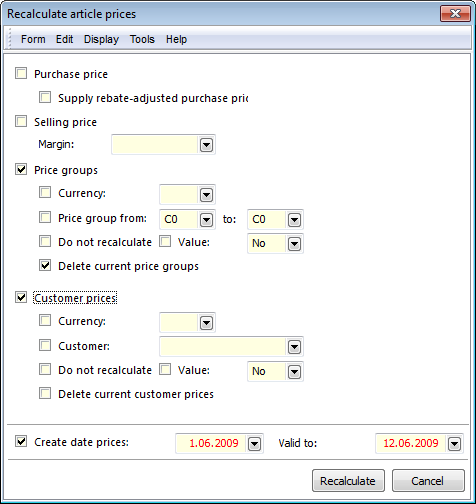
Picture: The Recalculate article prices form
Description of Fields:
Purchase price |
It recalculates the purchase price on the 2nd page of Article card according to the price of optimal supplier. If in the card the currency is saved, the first found price that is defined in the same currency will enter. If this price does not exist, a price in a basic currency or a first founded price will enter. |
|
Supply rebate-adjusted purchase price |
It recalculates the purchase price on the 2nd page of Article card according to the price of optimal supplier that is edited about multipliers. The Purchase price field has to be checked. |
|
Selling price |
It recalculates the selling price on the 5th page of Article card either according to a selected margin or according to margin that is set on 5th page of Article card. However it does not recalculate the prices of individual group prices and customer prices. |
|
Margin |
The selling price will be recalculated according to this margin. This margin is not entered into the price, only the value will be calculated according to this margin. |
|
Price groups |
Either the prices of selected price groups (if the Price group from - to field is checked in this form) or the prices of all price groups (if the Price group from - to field is not checked in this form) will be recalculated. The customer price will not be recalculated. If any of following fields is checked, only these price groups will be recalculated whose values match the specified values. |
|
|
Currency |
Recalculate those price groups that are set in the given currency. |
|
Price group from - to |
Select the price groups interval to which the price recalculation will be applied. |
|
Do not recalculate |
By checking this field the prices that has checked the Do not recalculate field in the Article prices form will be recalculated. All recalculated prices will have set this field according to the definition in a Product group. If you check the field Value in addition, then each new recalculated price will have checked the Do not recalculate field according to the value that is selected in a code list. |
|
Delete current price groups |
Before you run recalculation the prices for price groups from the bottom of the 5th page of the Article card will be deleted. If the field is not checked, the prices that should have been loaded according to the current (recalculated) definition will be overwritten. The prices that are not replaceable remain unchanged - they will be against the definition in addition. |
Customer prices |
The customer prices will be recalculated. If the customer price comes from a certain price group, you have to check the Price groups field. |
|
|
Do not recalculate |
It has an analogous meaning as for price groups, i. e. if records with the Do not recalculate check box are also to be recalculated and possibly what value is to be set in the new prices. |
|
Customer Currency |
Only records that match the values entered in these fields are recalculated. |
|
Delete current customer prices |
It deletes the current customer prices which means all prices related to customers in the bottom of the 5th page of the Article card. |
Create data prices |
Data price will be loaded - its Selling price, Price groups or Customer prices. If the Date from and Date to is identical with any price that is already created, its values will be changed. If any of the data (From or To) is different, a new data price is created. |
|
Recalculate customer prices
The function is activated over an Article card (that means different from 0th page) or over the Article container and it recalculates the prices of a selected customer according to the defined parameters.

Picture: The Recalculate customer prices form
Description of Fields:
Currency |
You select the currency if you want the defined customer price in a different currency as well. |
Customer |
You can define a customer whose prices you want to recalculate. |
Quantity |
You define the quantity to which the recalculation will relate to. If you set a different quantity than is in defined customer prices, a new customer price will be created. |
Base price |
You can select the price group on which the recalculation will be based. If you not enter a price group, it will be proceeded from a basic selling price on 5th page of an Article card. |
Relative |
If you check this field, the field Relative in the Article prices form will be checked after recalculation. |
Surcharge |
You can enter the surcharge absolutely or in percentage (if you check the % field) |
Create data prices |
A data price will be counted - its Selling price, Price groups or Customer prices. If the Date from and Date to is identical with any price that is already created, its values will be changed. If any of the data (From or To) is different, a new data price will be created. |
Recalculate products
The function is activated either over an Article card or over an article container and it calculates planned stock price, selling price or weight according to a selected costing model.
- Run over article container: browse only the routings of those cards that are in the container that means if the product consists semi-finished product, then routing browses this semi-finished product only if it this semi-finished product is in the container as well.
- Run over one card or cards marked by asterisks: in this case, you can browse all levels of routing (i. e. all semi-finished products without having to add them to the container) by activating the Browse all levels option. The function fills in all child products/semi-finished products (according to the settings in the Product Category) in the card queue for processing and processes them without affecting any existing container.
If any level of production tree is no longer recalculated, then, if a specific variant is not specified in the item of parent product, the data from the card of given product is used. If a variant is listed, then the current data from the given variant (applies to the calculation of the stock price and weight).
The recalculation does not recalculate invalidated routing variants. If such a variant is encountered during the conversion, it is written to the conversion error log. The product/semi-finished product is then valued in the calculation at the current price of the invalidated variant.
Note: The recalculation browses the cards sorted according to the Abbr 1 field till all the cards will be valued correctly. That means if any semi-finished product will be valued after a product, the recalculation of this product card will run again. That is why it is recommended to have named the product cards and semi-finished product cards by this way that these semi-finished products that are generally on the lowest levels of produced trees were alphabetically according to the Abbr 1 field. You can provide the faster the recalculation process.
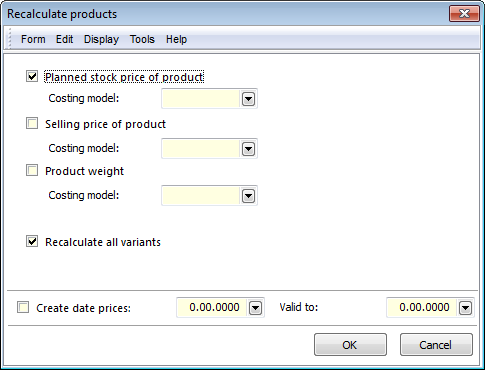
Picture: The Recalculate products form
Description of Fields:
Planed stock price of product |
According to the chosen calculation formula, they will evaluate the defaults routing variants of recalculated products / semi-finished products. The price is entered in the Plan. stock pr. /UM on the 1st page of variant. If the Recalculate all variants option is activated, then a stock price will be recalculated in all routing variants. The price of default routing variant is also entered in the Plan. stock price on the 2nd page of the Article card. If calculation base is defined in the Routing variant (the Calculation base field is filled in), then this quantity is taken into account for the calculation of unit planned price. Example: RV is defined for a quantity of 1 piece of product. It contains materials for CZK 10,000 and overheads independent on the quantity produced in the amount of CZK 1,000. Unit planned price is then CZK 11,000. However, if you normally produce batches of 5 pieces (calculation lot), then the planned stock price for one product is CZK 10,200 (CZK 10,000 x 5 pieces + CZK 1,000 overhead / 5). |
Selling product price |
According to the selected costing model the selling price will be recalculated and entered on the 5th page of Article card in so called current price (price where the date is defined in a format "0.00.0000"). |
Product weight |
According to the selected calculation formula, calculate the weight of the default routing variant of the recalculated products / semi-finished products. The weight is entered in the field Weight (kg) / UM on the 1st page of the variant. If the Recalculate all variants option is activated, then a weight will be recalculated in all routing variants. The weight from the default RV is also entered in the field Net weight (kg) for the basic storage unit of the Articles. |
Costing model |
The selection of a costing model according to which the final value will be calculated. If you do not define a costing model, the recalculation will run according to a costing model that is defined on the Article category card (for a stock and selling price according to CM - planned; for a weight according to the CM - weight). |
Recalculate all variants |
If the option is marked, all routing variants will be recalculated and appropriate values in these variants in a case of Recalculation of planned stock prices and Recalculation of weight will be entered. The function does not recalculate variants that are invalidated or blocked for selection. |
Go through all levels |
The option can be activated when you start the recalculation over one item card or over the cards marked with an asterisk. The activated option ensures the recalculation of all levels of the production tree - a more detailed description is above in the introduction to this function. |
Create data prices |
If the Product Selling Price option is activated, it creates and calculates date selling price for the recalculated products. Of the calculated items, only the date price valid from-to the same as the created date price for the product is taken into consideration. If the Date from and Date to is identical with any price that is already created, its price will be changed. If any of the data (From or To) is different, a new data price is created. |
Articles repricing
The function is activated either over an Article card (that means different from 0th page) or over an Article container and it reprices (recalculation) of Supplier prices, Purchase prices, Selling prices, Price groups and Customer prices based on an entered surcharge. Also here it is possible to create the date prices. The prices can also be rounded according to a defined order and constant.
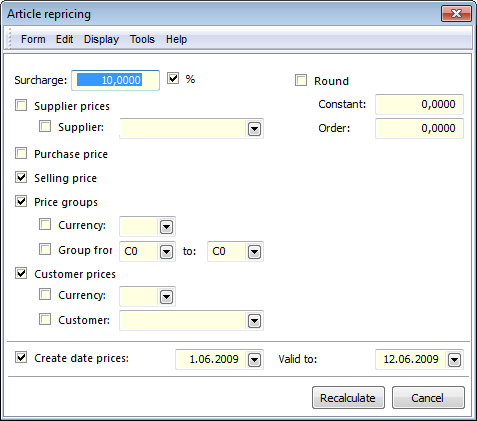
Picture: The Articles repricing form
Note: The meaning of each field corresponds to the fields in the other forms for recalculations.
Change exch. rate and recalculate prices
This function allows you to change the purchase and sale prices of articles that have the appropriate selected currency set. If you change the exchange rate and activate the Purchase prices or Selling prices fields, the saved settings of the Currency option is taken into consideration:
- The Currency option is disabled on the Articles tab: the amount in the base currency does not change, only the exchange rate changes (and the amount in the foreign currency is recalculated).
- The Currency option is enabled on the Articles tab: changing the exchange rate does not change the amount in the foreign currency, the amount in the base currency is re-saved in the database.
If the Purchase Price or Selling Price option is not activated, then only the exchange rate will change (the recalculation behaves as if the Currency option has been turned off).
The function is activated over an Article card (different from 0th page) or over the Article container.
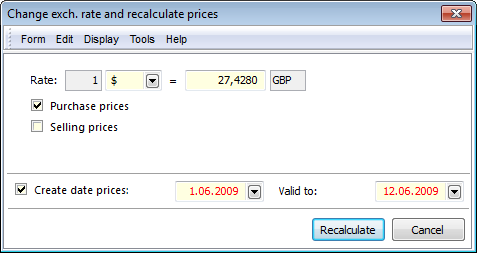
Picture: The Change exch. rate and recalculate prices form
Recalculate data prices
The function enables to recalculate the current prices to the data prices and the data prices to the current prices. If you copy from the data prices to the current prices, you can check the fields that should have been copied by the recalculation to the price. Further you can edit the data of existing data actions or delete data prices in a selected interval.
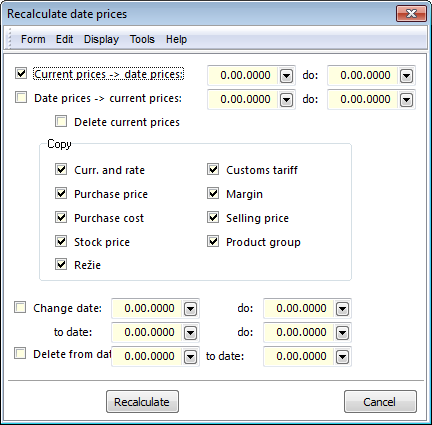
Picture: The Recalculate data prices form
Fields Description:
Current prices - date prices |
It recalculates a date price according to a current price. In this field you can enter a data price that you want to recalculate (both dates have to be identical), respectively that you want to create (If at least one date will be different from the existing date price). |
Date prices - current prices |
It recalculates a current price according to an entered date price. If this variant is used, the option Delete current prices and the fields in the Copy section will be important. |
Delete current prices |
When recalculating the date prices to the current prices (i. e. the field Date prices -> current prices is checked) the current price groups will be deleted and substituted with date price groups. |
Copy |
You can define which items should be copied when recalculating of prices. Note: It is valid for a recalculation of the date prices to the current prices only! |
Change date to date |
It changes Date from and Date to of the date prices. That means that you can change all date of a date action by this way. |
Delete from date to date |
It enables to delete date prices that are valid in a defined interval. |
Inventory turnover calculation
It opens the form for calculating inventory turnover. The detailed description in the Basic code lists and supporting modules K2 - Articles - Article card - Basic data (1st page) chapter.
Reports of Article
Articles price list
Process No: CIS008, ZAK007 |
Report ID: SCIS017 |
File: ZB_CEN01.AM |
|
Report description: Articles price list. |
|||
Address in the tree: [Sale/Processing of sale orders] [Basic data] [Prices] [Price lists] |
|||
Reports parameters:
DisplZer - Yes Yes - display as zero. |
ShowDealCat - Yes Yes - displays price groups. |
ShowInEuro - No Yes - displays conversion to EUR according to current rate. |
ShowNonArticle - Yes Yes - displays either Non-stock items. |
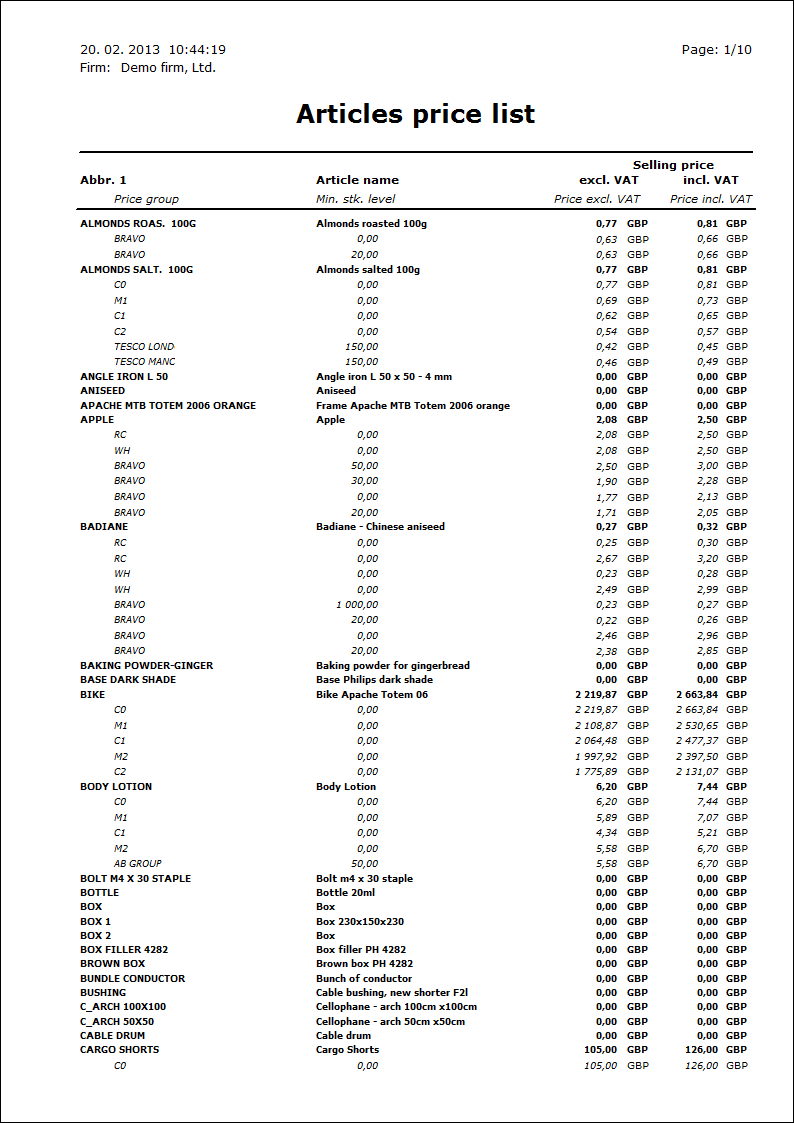
Catalogue of articles
Process No: CIS007 |
Report ID: SCIS056 |
File: ARTICLEPICT.AM |
|
Report's description: Catalogue of articles with information about the price, stock level and ordered quantity. Displayed price meets the current selling price for the price group or customer according to the settings of the Price group, Company and Currency fields in the bottom panel in the Articles book. (The price can be displayed in the Price Group ("CFDealC") column). If the article has got an image preview, the article image will be displayed. |
|||
Address in the tree: [Sale/Processing of sale orders] [Basic data] [Articles] [List of articles] |
|||
Reports parameters:
ConclusionText Text at the end of a report. |
HideDescription - No Yes - hide text over the picture. |
MainTitle Main title of a report. |
PictureFolder - PICTK2 Type of picture. |
ShowAmount - Yes Yes - displays the current stock level. |
ShowOrder - Yes Yes - the current ordered quantity. |
ShowPrices - Yes Yes - displays information about selling price. No - do not display information about selling price. |
SubTitle Text below the main title. |
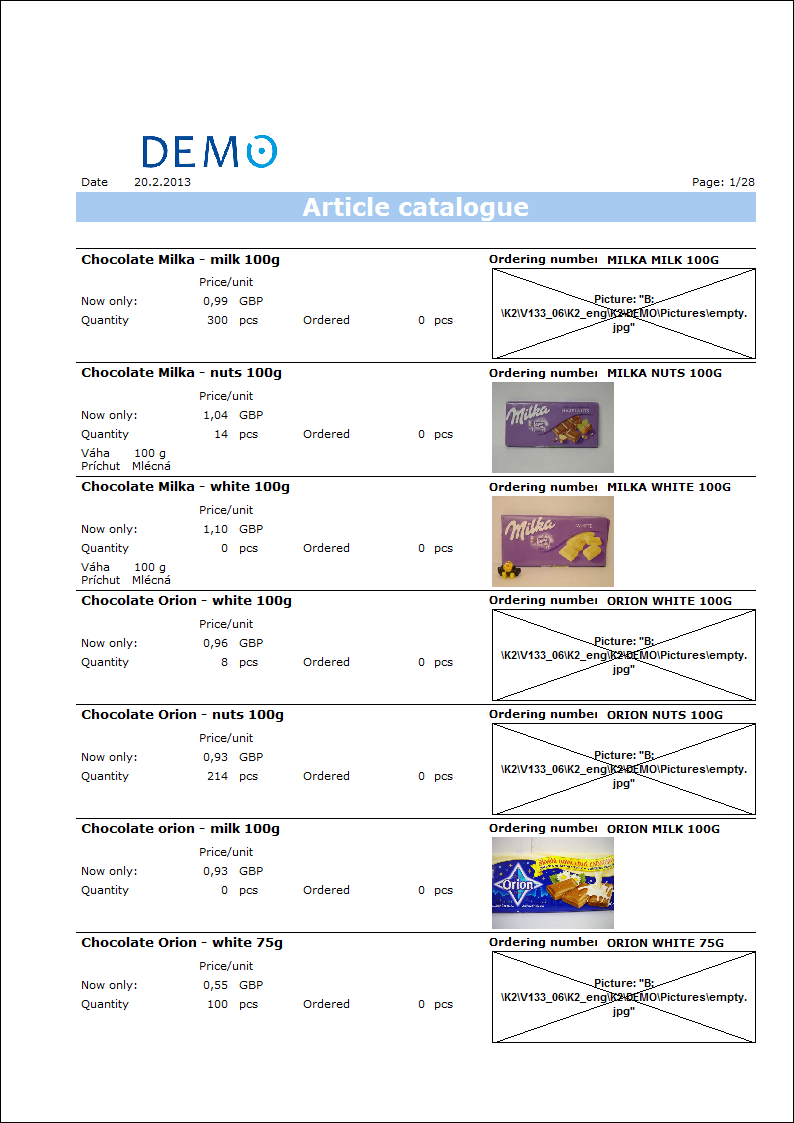
Turnovers of articles
Process No: CIS007 |
Report ID: SCIS028 |
File: ZB_SKE09.AM |
Report description: Goods turnover per selected time interval. Output can be printed in the prices or in quantity. Internal turnovers (transfers within one warehouse, or between warehouses of one summation warehouse when processed above the summation warehouse) are not counted. |
||
Address in the tree: [Sale/Processing of sale orders] [Basic data] [Articles] [Stock levels] [Purchase/Processing of purchase orders] [Basic data] [Articles] [Stock levels] |
||
Reports parameters:
CurrentWarehouse - Yes Current warehouse. It is important when the summation warehouse is set. Yes - data is printed for the summation warehouse as a whole. No - data is printed for each physical warehouse belonging to the summation warehouse separately. |
OtherUnit - ' ' Abbreviation of stock unit for evaluation. This parameter is important only if you set the "UnitType" parameter to 5. If the Article card does not have a given unit, it is evaluated in the base unit. |
ShowBatches - No Yes - turnovers of batches will display. |
Show_prices - No Yes - data in the prices will display; No - in quantity. |
ShowZeroItem - No Yes - articles with zero turnover will display. Note: Cards with zero turnover and zero initial state are never printed. |
UnitType - -1 Type of stock unit for evaluation. It meets the Unit code list on zero page of the Articles book (lower panel). The default value "-1" means processing according to the settings in the Articles book. |
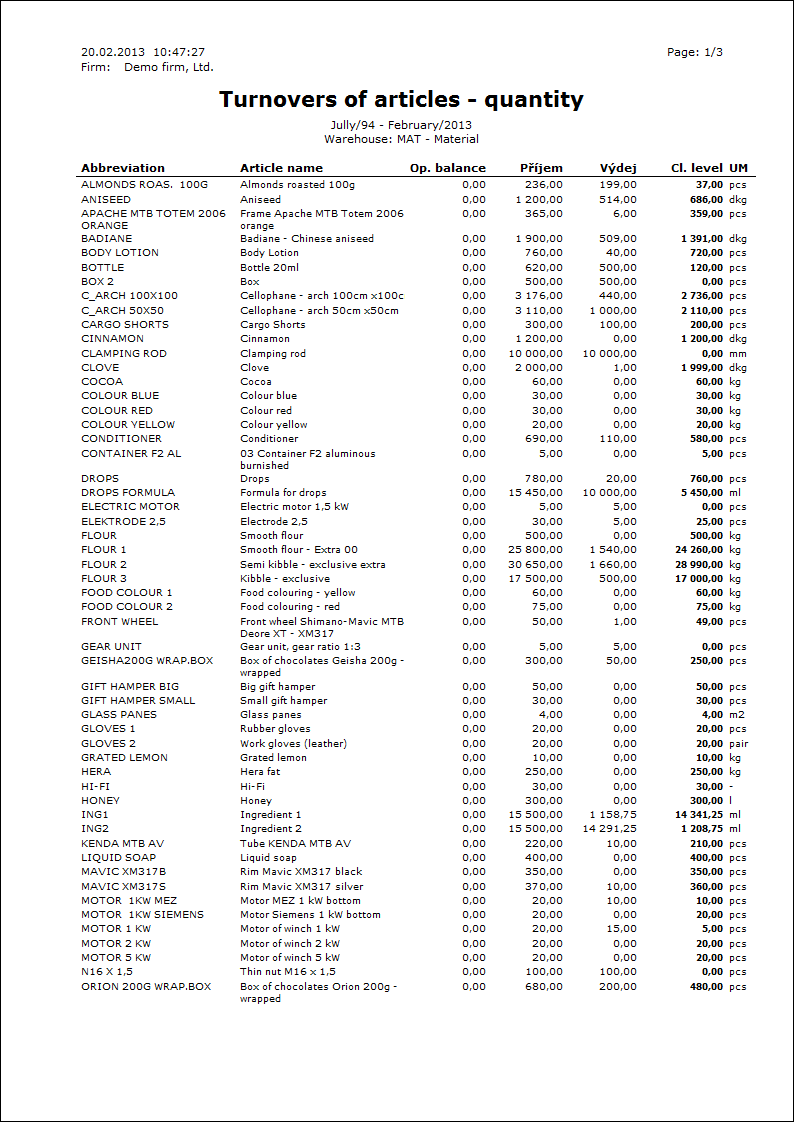
Methodologies of Article
Multidimensional quantity
Multidimensional quantity offers several variants of use. Using Class the changeable conversion factor can be used. It will be calculated and saved to batch after inserting required properties. On a release this coefficient will be used instead of a defined ratio of the Article card.
Example 1 - Metal Sheet
You can buy metal sheets in pieces with fixed size from your supplier. But you pay him in kilograms, while one piece of metal weighs differently by the delivered doses. We would like to account this difference during a release, or pricing.
This case, simply said, works by entering the total weight and number of pieces when receiving. During a receipt confirmation the coefficient will be saved to batch characteristic, how much one piece weights. When releasing after selecting a batch, one piece is then calculated according to the coefficient to the correct weight, and thus the price for this piece is calculated correctly, because the selling price refers to the basic unit, i.e. to kilograms.
Another possibility of using a multidimensional quantity is, for example, the sale of articles for which we want to record its dimensions and, if necessary calculate the selling price according to them.
Example 2 - Glass Sheets
You can purchase and sell the glass sheets which you want its proportions to enter and display. Stock records are kept in square meters, which are derived from the sheet proportions. Selling price is in square meters as well.
In this case you can enter proportions to batch characteristic. After you enter proportions and the number of pieces, a total size will be counted in square meters on either receipt or release automatically.
Attention!!! Multidimensional quantity cannot be used in production, it is intended only for purchase and sale. It is impossible to cut e.g. a sheet with certain proportions - to do this, a standard production process must already take place.
Article, for which you want to use multidimensional quantity, must has set these data:
- Bath records (machine isn't significant - currently this field is ignored and batch is created automatically in purchase; inside out during a release batch always must be entered manually).
- Stock units have to contain the units, where you will deal, whether it is purchase or sale. For the recalculation between units, the ratio from the Article card will be used in the issue until the batch is selected, after selecting a particular batch, the coefficient from the batch will be used.
- Classification - see the next chapter.
- All other fields do not affect the functionality of multidimensional quantity and follow general meaning in the K2 IS.
Example 1 - Sheet metal:
Create an Article card "Sheetmetal 0,05 pcs". As a basic Stock unit you select kilograms and as the next stock unit pcs as a default unit for sale. Activate the Batch records and Automate options. You fill all the others demanded fields.
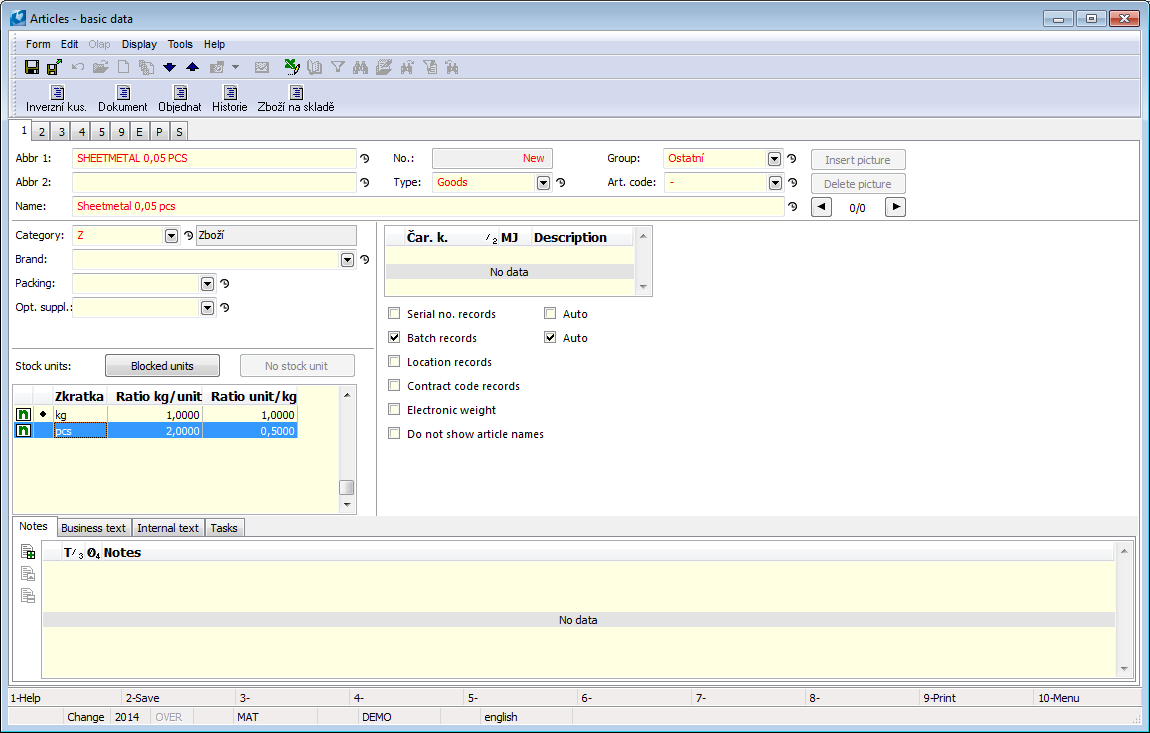
Picture: A created Article card "Sheetmetal 0,05 pcs"
Switch to the 'P' page and apply the classification "Sheet metal" in the Classification field.
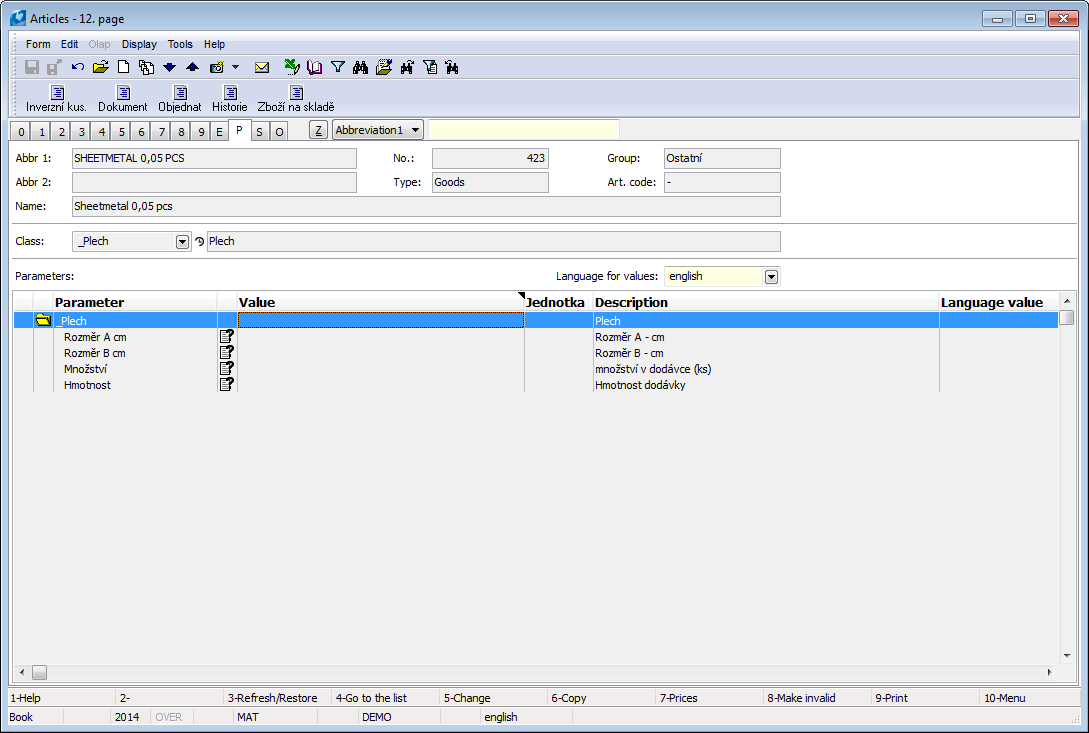
Picture: The Article card with assigned classification "Sheet metal"
Example 2 - Glass:
You create an Article card "Glass". As a basic stock unit just select square metre, in this unit you can buy and sell. Activate the Batch records and Automat options. You fill all the others demanded fields.

Picture: You can create an Article card "Glass"
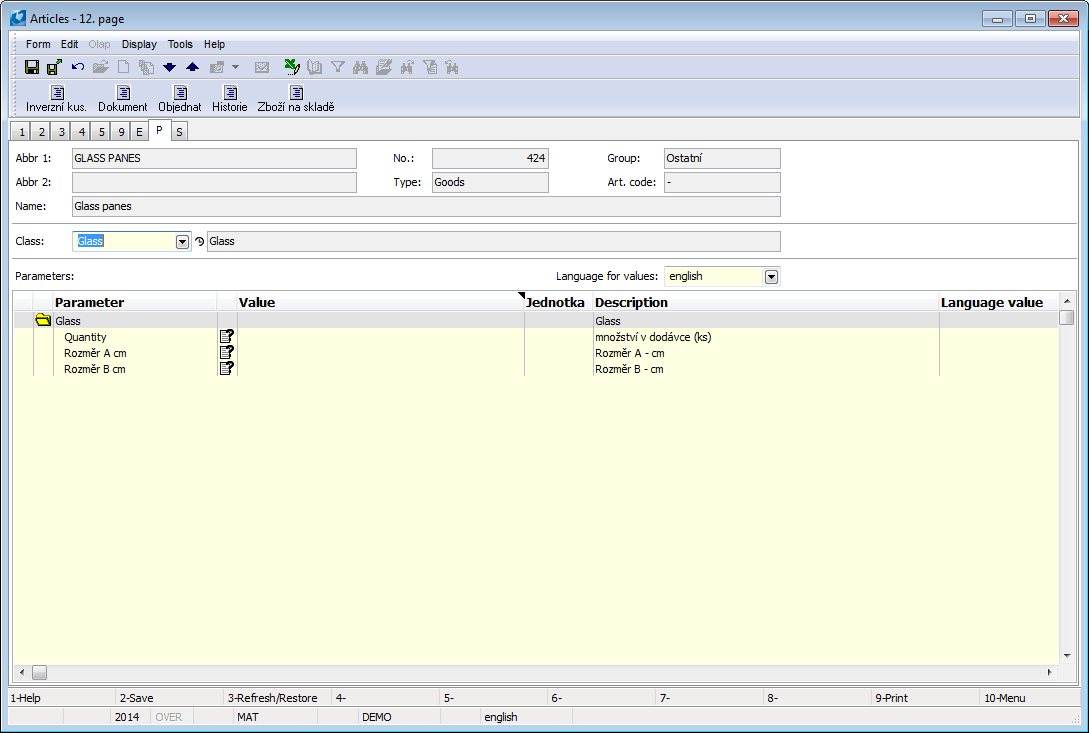
Picture: The Article card with assigned classification "Glass"
Example 3 - Pipes
You can buy pipes of different diameters, for each type of pipe you can require to have one card of Article. Each pipe of a given diameter can be purchased in a different standardized length, the pipes are then cut even further. You can buy meters of the required lengths of pipes (e.g. 5 pieces of eight-meter pipe). In the stock records, you need to see the total length of a given pipe in meters in stock and also have an overview of how many pieces and meters you have individual lengths of pipe. You will use batches for this.
Create an Article card "Pipe" (identification will also include the diameter) and enter the storage units: meters (base unit) and pieces. You will leave the ratio unspecified. Activate the Batch records and Automat options.
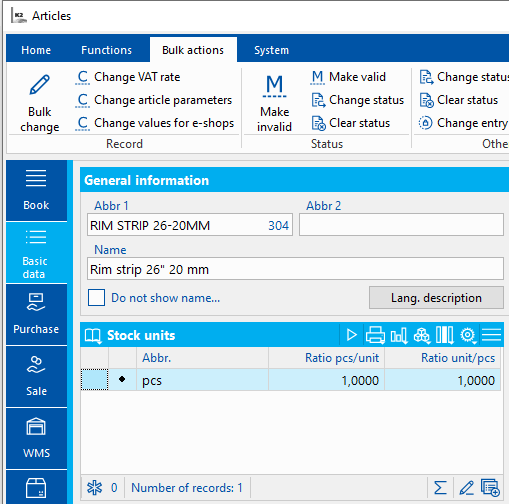
Picture: The "Tube" card stock units
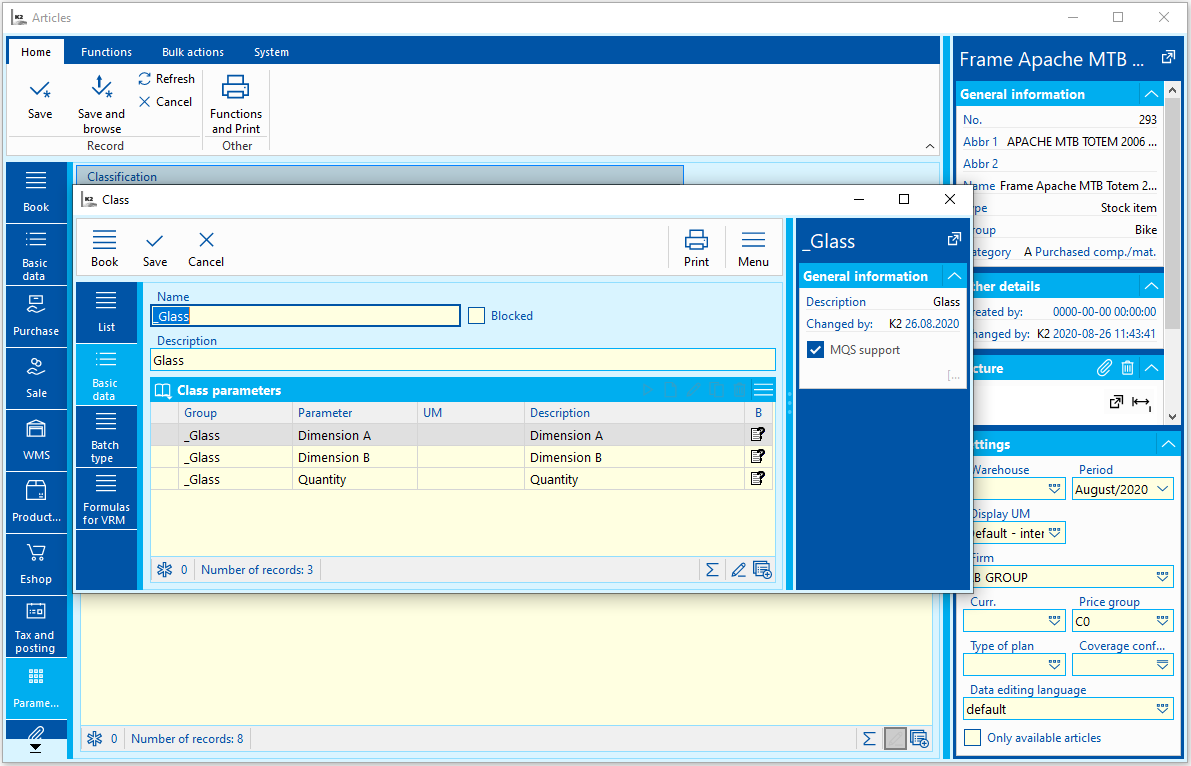
Picture: The "Tube" card with the assigned "Tubes" Classification
In order to be able to work with a multidimensional quantity, the given Articles must have a Classification selected, in which the formulas are set on the 3rd page. For further description see the chapter Classification and Parameters in the Parameters chapter in the Basic code lists and supporting modules K2 part. If there is at least one formula on the 3rd page of the Classification, then the program automatically activates the Multi-dimensional quantity support option on the 1st page of the Classification form. Checking this option cannot be changed manually.
Example 1 - Sheet metals
We will create a new Classification "Sheet metal" and a group "Sheet metal", you will establish parameters for the weight of the delivery and the number of pieces in the delivery. The "Number of pieces (psc)" parameter will contain entered number in pieces. To the "Weight kg" characteristic you can set the total weight of delivery. Both parameters will have the option Value defined on batch or required parameters and Default required parameter activated.

Picture: Set parameters for Classification "Sheet metal"
Then you can enter the formula Classification on the 3rd page. The formula valid for receipt will be defined for the storage unit "kg" because you buy sheets in this unit. The result of entering the weight (calculated value that is entered in the purchase item in the Quantity field) must be this weight (because you buy in kilos). Therefore, enter the identifier of the "Weight" parameter (V67) in the Formula field. In the Variables to enter quantity field, enter the parameters that you wish to enter when receiving. In our case, in addition to the weight, also the number of purchased sheet metal plates (V67, V168).
The entered formula therefore means that in the Quantity field in the purchase item there will be the same value as we enter using the form via the Quantity button into the "Weight" parameter.

Picture: Set formulas for receipt
For the unit "pcs", a formula will be entered in order to calculate the coefficient (ratio between kg and pcs for each batch). This ratio replaces the fixed ratio from the goods card when calculating the quantity in pieces. This formula has to be checked the field Valid for purchase and Formula to determine coefficient. Formula displayed on the picture counts coefficient as a contribution of total weight and total quantity. You determine the weight of the one piece. The value of the coefficient is saved in the batch when the batch is created.
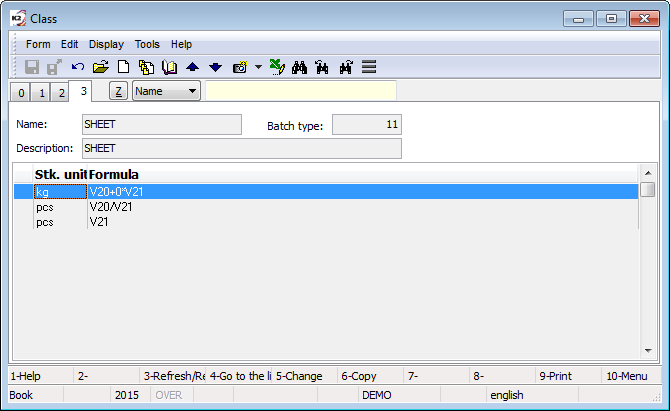
Picture: Set formulas for "Sheet psc."
After entering the formulas on the 3rd page of the Classification form, the Multi-dimensional Quantity Support option on the 1st page of the Classification form will be activated automatically.
Example 2 - Glass
Create a new Classification "Sheet metal" and enter parameters for the height, weight and the number of pieces in the delivery. Properties "Dimension A" and "Dimension B" contain height and weight, property "Quantity" contains number of received pieces in appropriate proportions. All parameters will have the Value from batch option checked.
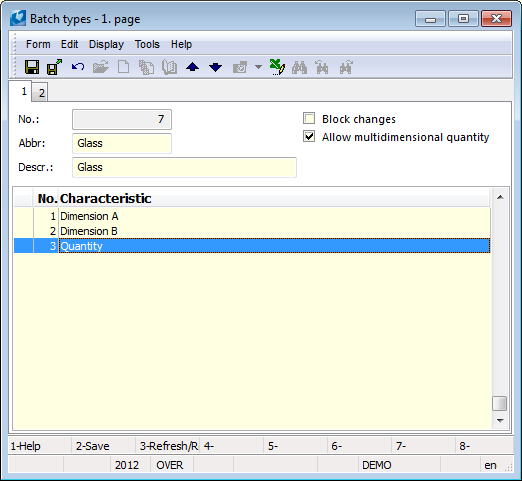
Picture: Set characteristic for the Batch type "Glass"
You can enter formulas on the 3rd page of code list Classification. In this example you buy and sell in square meters which you calculate by multiplying of both proportions and by number of pieces. Thus you can count purchase and sale according to the same formula "Dimension A x Dimension B x Quantity". You don't need other formula.
.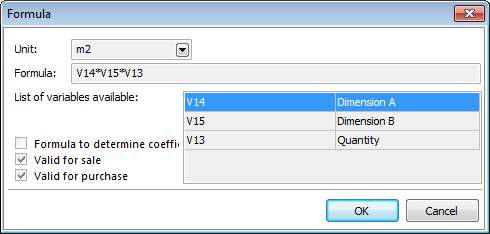
Picture: Set formula for the Classification "Glass"
Example 3 - Pipes
You will create a new Classification "Pipes" and a group "Pipes", then enter parameters for the number of pieces in the delivery and the length of the pipe. The characteristic "Number" will contain entered number in pieces. You will enter the length of the pipe in the "Length" parameter. Both parameters have the Value is defined in batch or in requested parameters option activated.

Picture: Set parameters for Classification "Sheet metal"
Then we enter formulas on the Formulas for VRM tab. The formula valid for receipt will be defined for the stock unit "meters" as you can buy pipes in this unit. In the Variables to enter quantity field, just enter the parameters that you wish to enter when receiving, that is, the pieces and the length of the pipe. The result of the entry must be the total purchased length, i.e. the sum of the number of pipes and the length of the given pipe. Therefore, in the Formula field, enter the product of the identifiers of the "Number" (V177) and "Length" (V178) parameters.
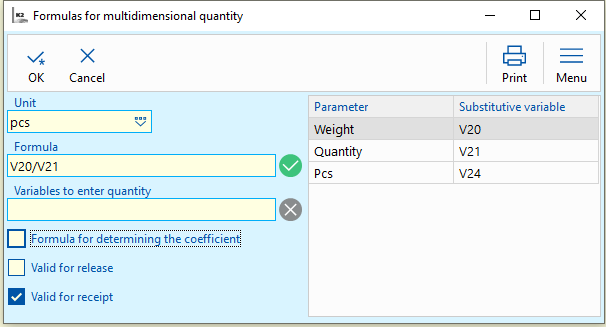
Picture: Formula for receiving tubes
A formula will be entered for the "pcs" unit in order to calculate the coefficient so that the user can display not only meters in stock for individual batches, but also the number of pieces in stock. This ratio replaces the fixed ratio from the Article card when calculating the quantity in pieces. This formula should have the Formula to determine coefficient option activated. To calculate meters to pieces, you need to have the value of the coefficient equal to the length of the pipe. Therefore, you can enter the identifier of the "Length" parameter. The value of the coefficient is saved in the batch when the batch is created.
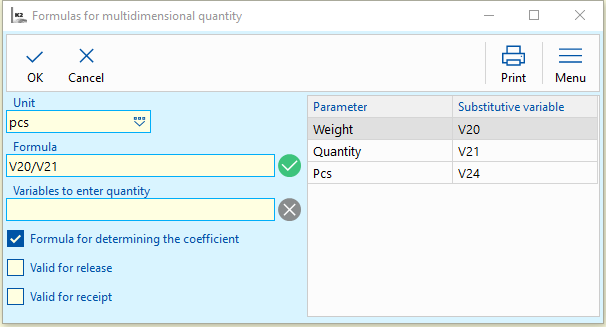
Picture: Formula to determine coefficient
Example 1 - Sheet metal
You have ordered 2130 kg of sheets from the supplier. Supplier has sent 100 pieces which total weigh 28 kg together. You want to receive this article to the stock.
Enter a Purchase order in a standard way. Select the "Sheet metal 1200x1500x1,5" article to the sale item. The button Quantity will be now accessible. By this button you can activate the Multidimensional quantity form. Enter the required value of the Order into it - order in kilos, so you can enter 2130 kg in the "Weight" parameter. According to the formula where the field Valid for purchase is checked and which is displayed in the upper part, the result quantity will be calculate that will be inserted into a Result. This value is entered in the Purchase Item.
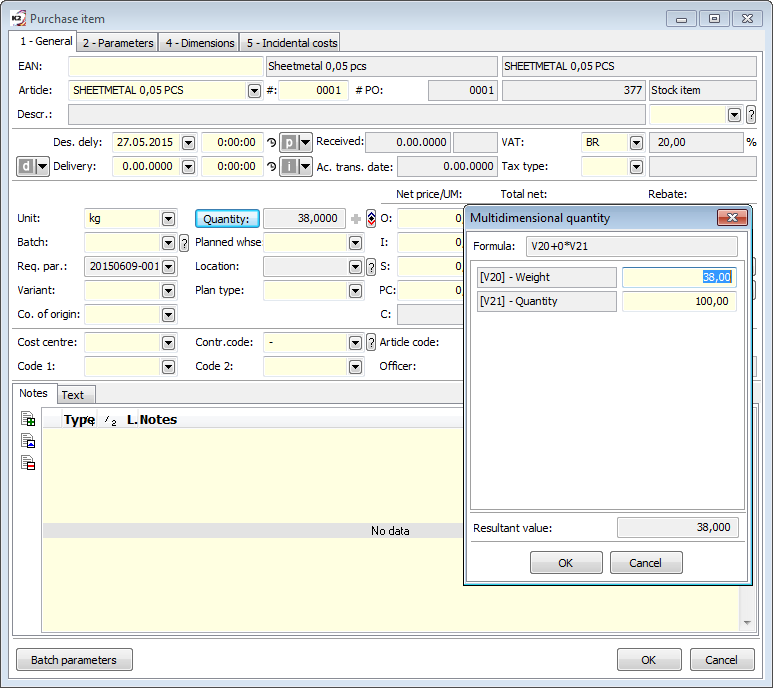
Picture: The Purchase item on Purchase order with the open Multidimensional quantity form
A record of the required parameters is created (in the Required par. field) with the parameters "Number of sheets" and "Weight" filled with the values entered in the Multidimensional quantity form.
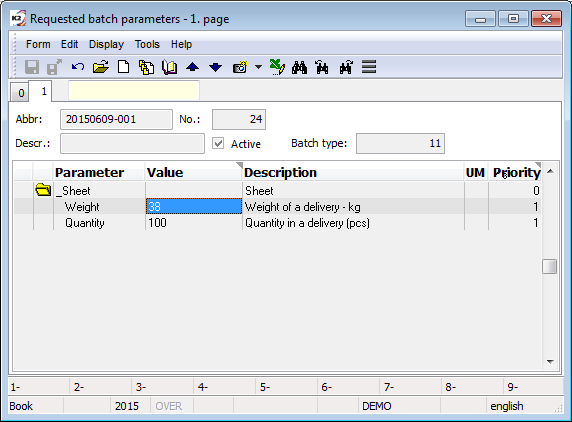
Picture: Required parameters of the planned batch after entering the order
Enter the item on the Receipt Card and enter the missing values via the Quantity button, or edit the existing ones according to the actual delivery. In our example, just leave the weight and add the parameter "Number of sheets", i.e. 100 pcs. The parameter values in the required parameter record are updated. Go to the Receipt Card and confirm it. During confirmation a batch will be automatically created where the values from Required characteristics will be copied. At the same time, the Batch coefficient is calculated according to the formula for determining the coefficient - in this case the total weight / number of pieces. Therefore, the average weight of one piece of this batch (21.3 kg) is calculated.
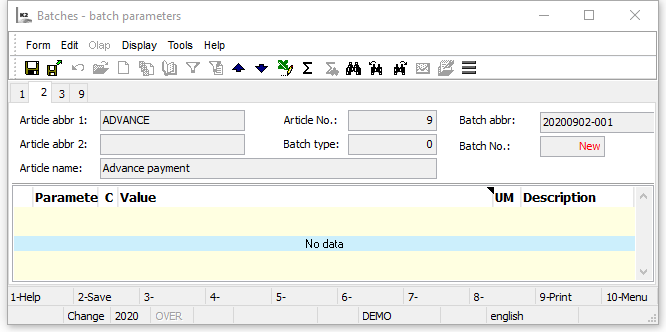
Picture: Values in the batch after adding the quantity to the recipient and confirming the receipt
To display the value of the coefficient, it is necessary to display a column with the program name "Coefficient" in the Batch book. The Available column ("CFDispMJ") then shows:
- when setting the stock unit "kg", the value in kg (according to the actual value of receipt);
- when setting the stock unit "pcs", the value in pcs (calculated on the basis of the batch coefficient).
If you wish to monitor the status in pieces (alternative unit) at the same time as the selected unit "kg" (alternate unit), then the column Avail. coef. can be displayed. ("CFDispCoef"), which displays the value converted from kilos to pieces according to the batch coefficient.

Picture: Batches - book
Example 2 - Glass
The supplier sent 40 pcs glass sheets with dimensions of 0.2 x 0.5 m.
You set up Purchase order by standard procedure. Select the Article "Glass" into the purchase item. The button Quantity will be accessible. By this button you activate the Multidimensional quantity form (hereinafter referred to as Quantity). There you set required values - proportion A, proportion B and number of sheets. According to the formula the final quantity will be calculated that will be inserted into a Purchase item. If you want to insert next characteristics by this way, you would have to state them in the formula multiplied by the zero, like in the previous example.
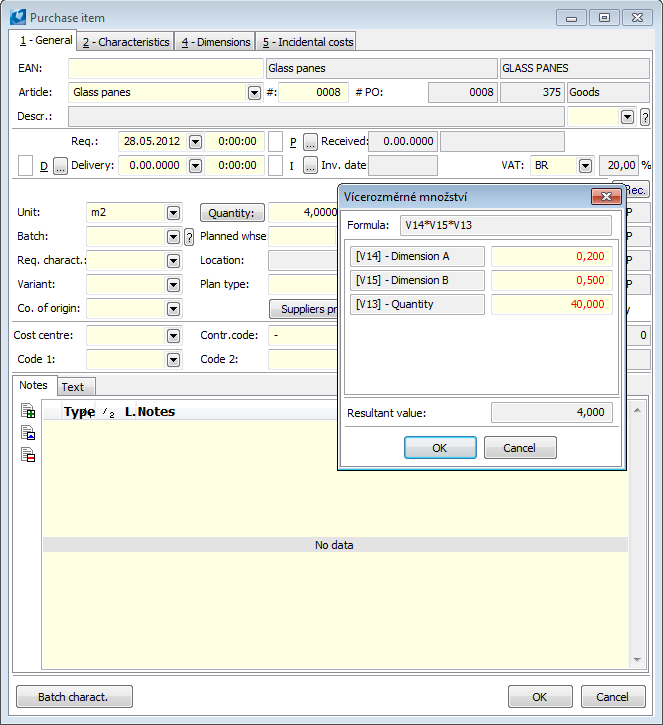
Picture: Pasted proportions and number of glass sheets in the order item
In the required characteristics a planned batch (i. e. required characteristics) will be created after setting of an item. A planned batch has characteristics "Proportion A", "Proportion B" and the "Quantity" with their content identical with inserted values in the Quantity form. You insert an item into a receipt card (or other documents that are not important for you at the moment) and you confirm the receipt card. During confirmation a batch will be automatically created where the values from Required characteristics will be copied.

Picture: The characteristic of automatically created batch on a receipt card
So you have 40 pcs loading glass sheets with dimensions of 0.2 x 0.5 m. Available in the Articles book has increased by 4 square meters.
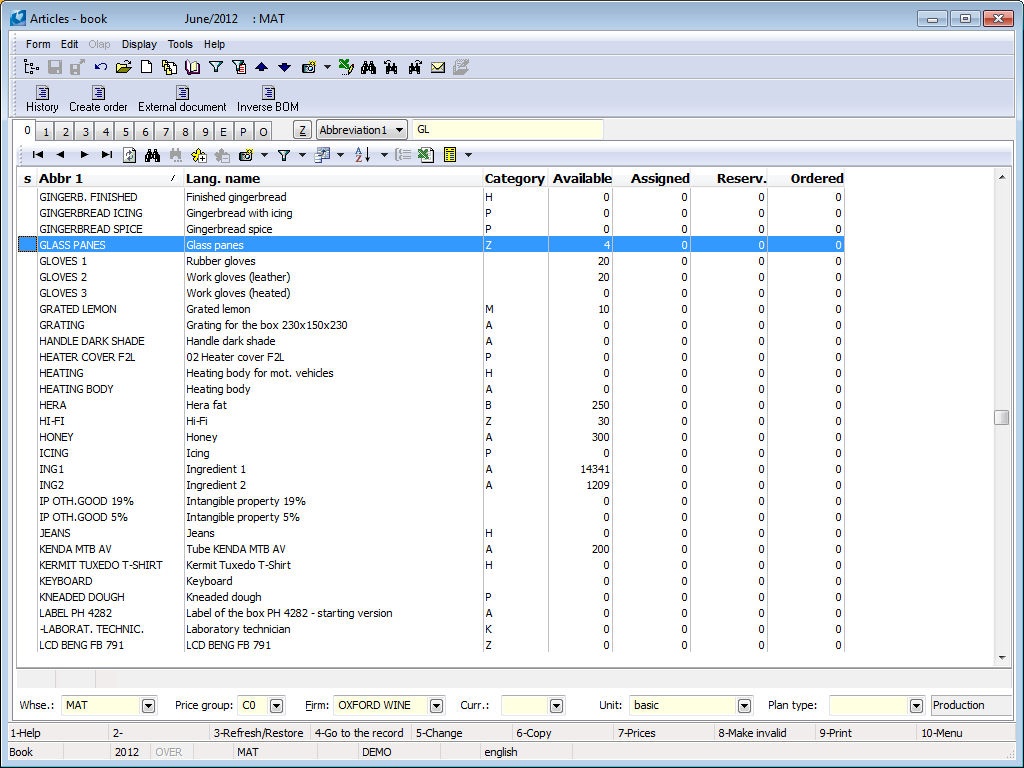
Picture: Increased available of the "Glass" Article
Example 3 - Pipes
You have bought 10 pieces of eight-meter pipes and 10 pieces of twelve-meter pipes from the supplier.
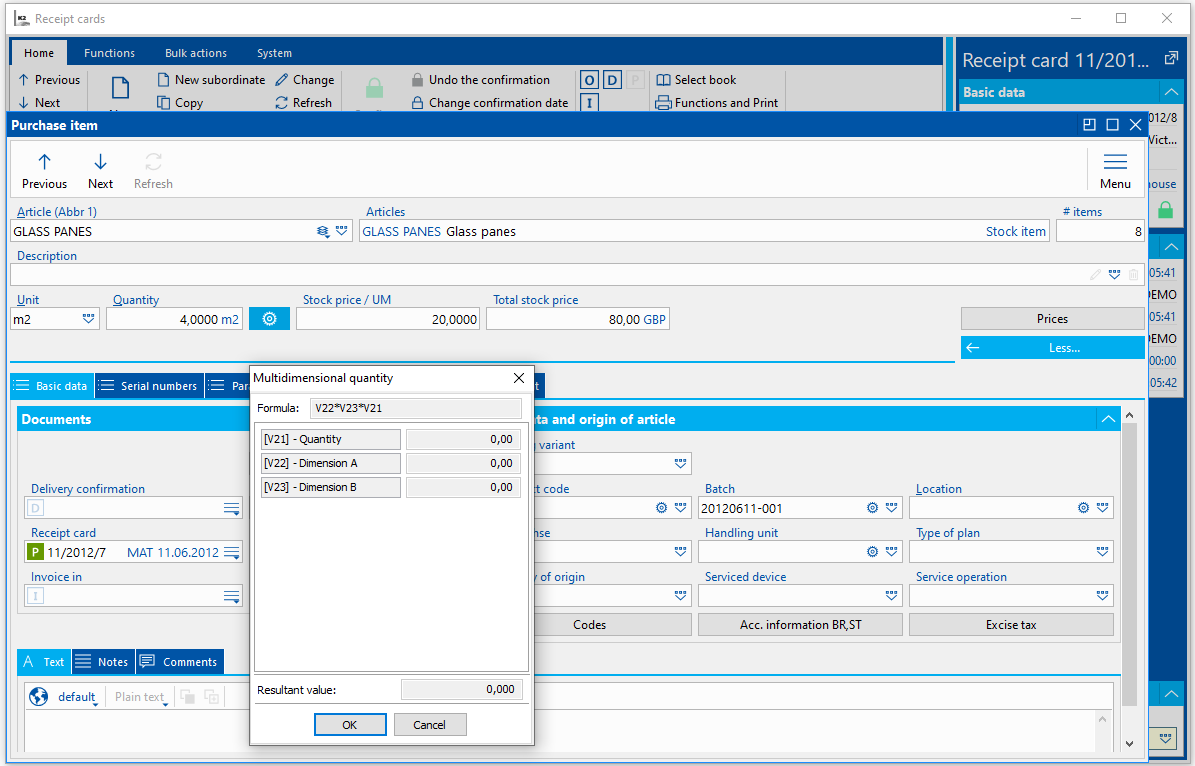
Picture: Receipt of pipes to the warehouse - detail of entering an item for 10 pieces of twelve-meter pipes
In the stock records you can see the data as in the following picture:
- You can see the availability of 200 meters for the "Pipe" Article card
- in the batch records you then can see a detailed division by type of pipes, their dimension in meters and pieces
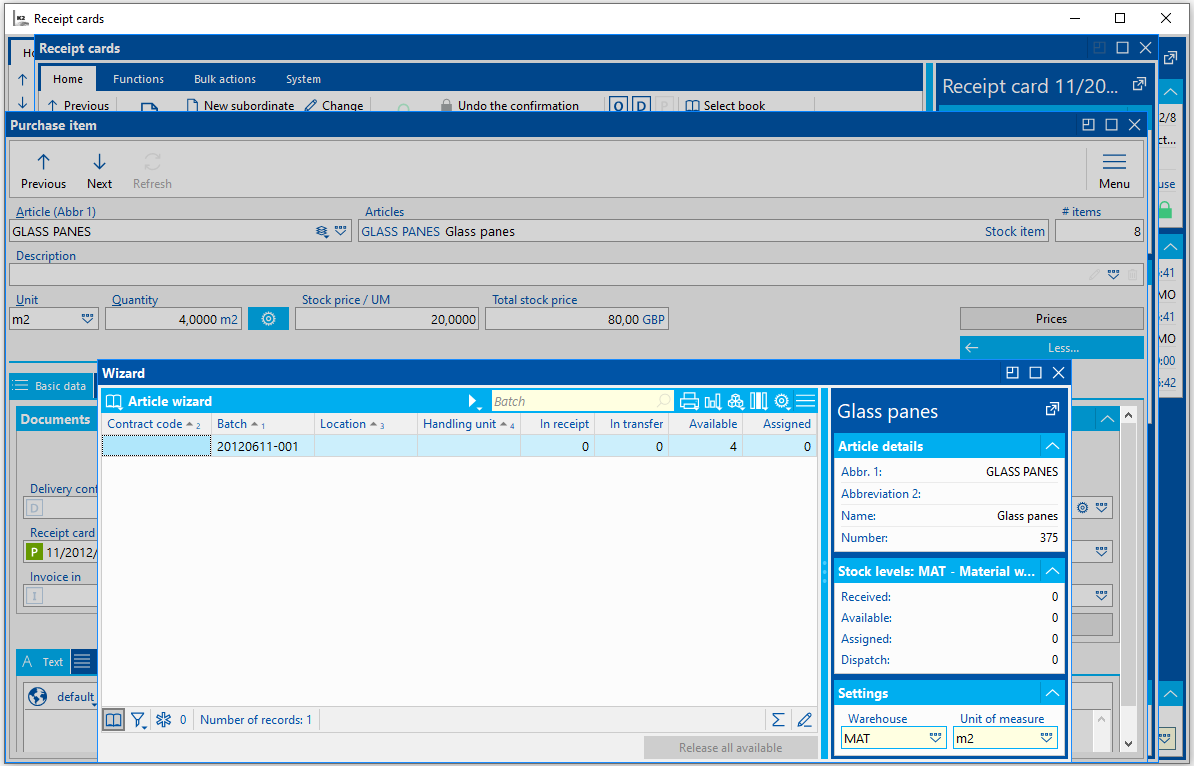
Picture: Disposition of pipes in stock - for the Article card and Batches
Example 1 - Sheet metal
A customer wants to buy 40 pcs of an article "Sheetmetal 0,05 pcs" and he wants to know the price. You want to sell the sheetmetal for the price 175.50 GBP/kg always on the whole pieces to corresponded price with a specific sheet according to its weight.
Set a selling price 175.50 GBP to the Article card. Detailed information about how to set selling prices is stated in the chapter Pricing in K2 IS.
You create a standard Sales order as you used to. You choose article " Sheetmetal 0,05 pcs" to the Purchase item. Thus the button Quantity activates by which you open Quantity form. In this form you enter only value "Quantity" (it means a number of pieces which you want to sell), because this one property which is given in formula valid for sale.

Picture: The Purchase item with the open Multidimensional quantity form
Entered quantity automatically enters to Quantity in Sale item, because you have got set default sale unit of this Article card on "pcs". Before a batch isn't selected a conversion on the kilograms will execute according to a proportion which is set in alternate unit on the Article card. Price 2106,- GBP (it means 52,65 GBP/pcs, it is 175,50 GBP/kg) is only preliminary price and doesn't correspond with concrete delivery.
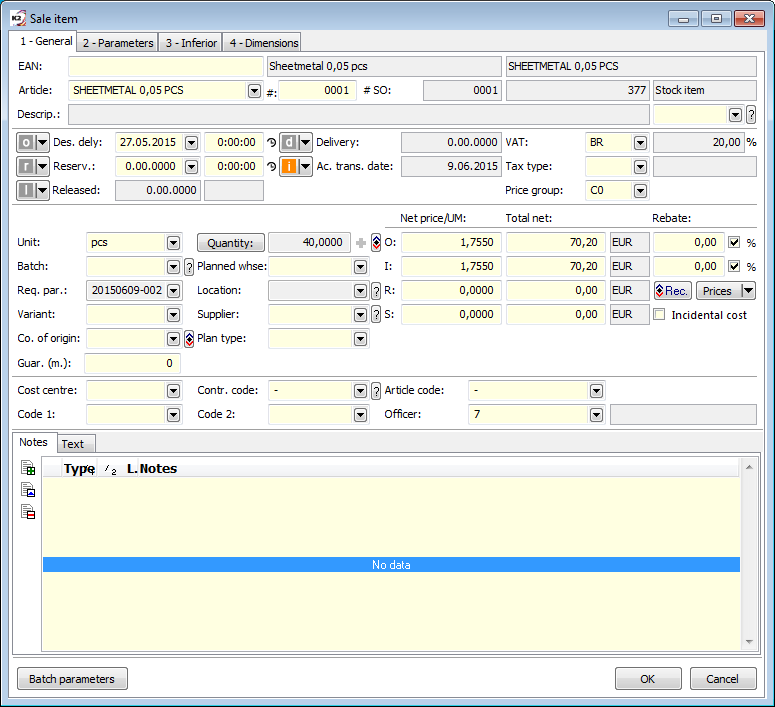
Picture: Sale Item - alternative unit "pcs"
If you change alternate unit on "kg", you will see the quantity 12 kg.
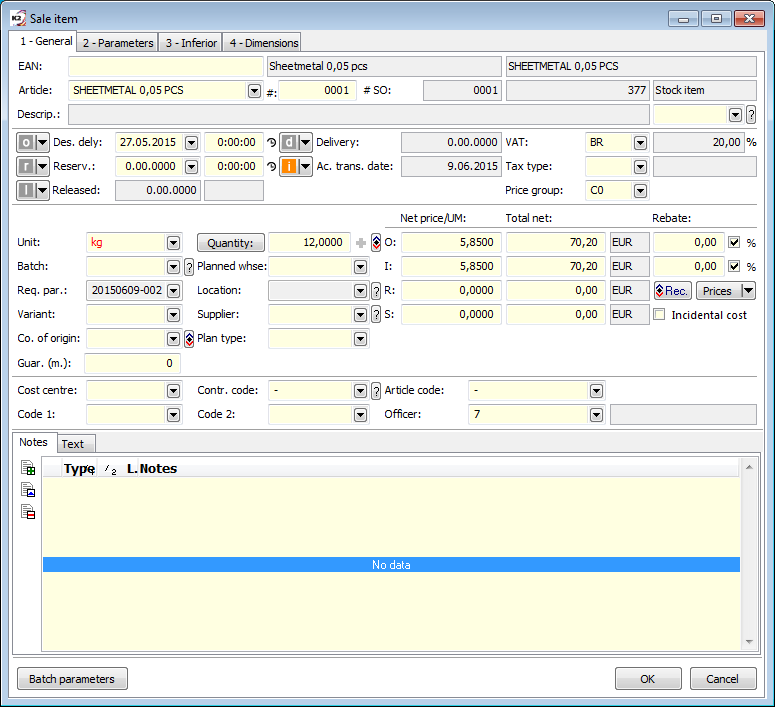
Picture: Sale Item - alternative unit "kg"
Change unit on the pieces backward.
For specification of a price you have to choose a batch. The parameter "pcs" will be used for accurate calculation of weight of required 40 pcs. After at selection of batch a price will change on 66,69 GBP per piece. This price is exact.
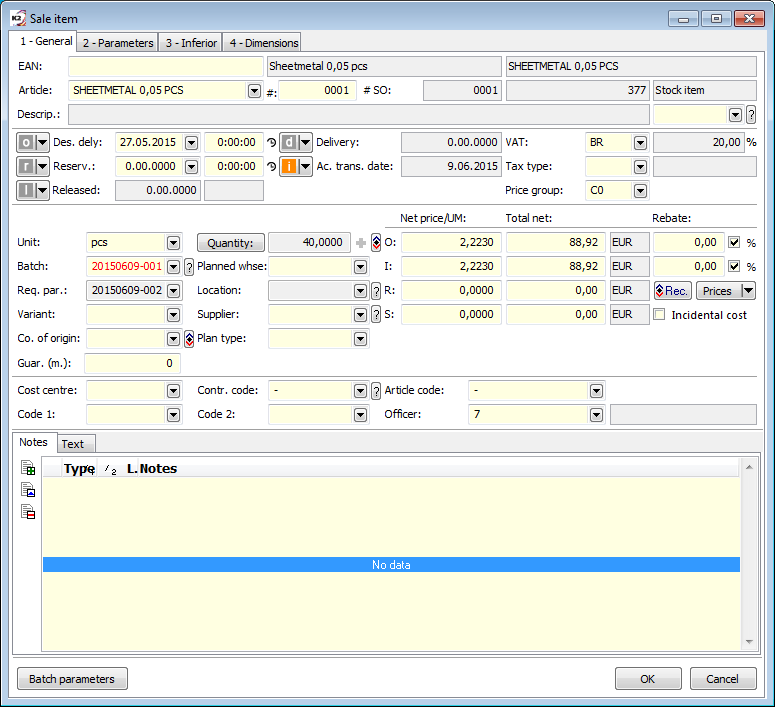
Picture: Sale Item with selected Batch
Now if you change unit on "kg", 15,2 kg will display, because required batch weighs 0,38 kg/pcs against 0,3 kg/pcs in ration for the alternate unit.
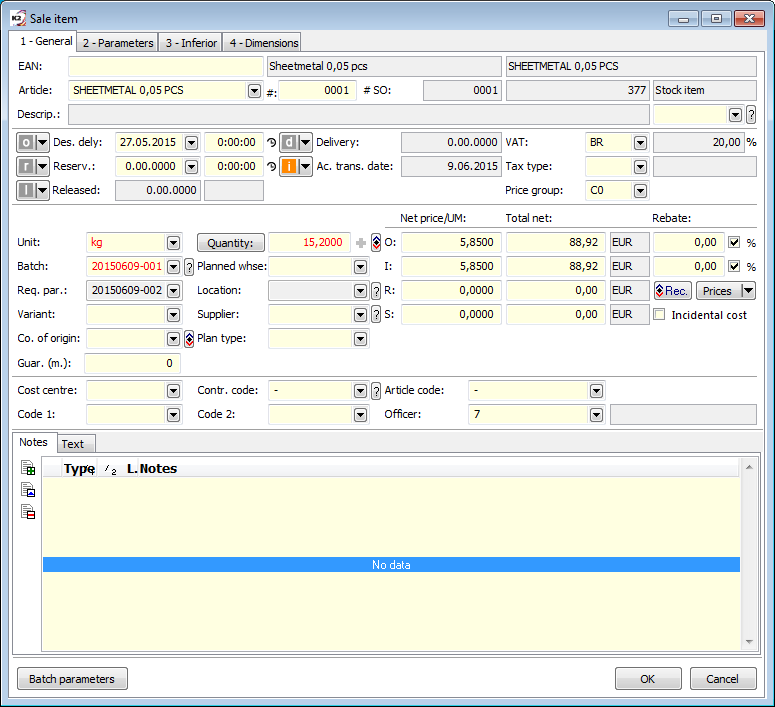
Picture: Sale item with selected Batch and changed unit to "kg"
After confirmation of a created release note an available of article "Sheetmetal 0,05 pcs" will decrease on 22,8 kg.
Attention! A batch in release has to always be selected manually, auto-completion batch doesn't work here. The item could be divided, which would damage the data, because the quantity values are saved in the parameters, which are also copied to the newly automatically created item!
Example 2 - Glass
A customer wants to buy the 30 pcs glass sheets with proportions 0,2 x 0,5 m and he agrees with the price 300 GBP per square meter.
You create a standard Sales order as you used to. You choose article "Glass" to the Sale item. Thus the button Quantity activates by which you open Quantity form. In this form you enter the required proportions and a quantity. Calculated area (according to a formula for sale) will automatically entered to the field Quantity to the Sale item.
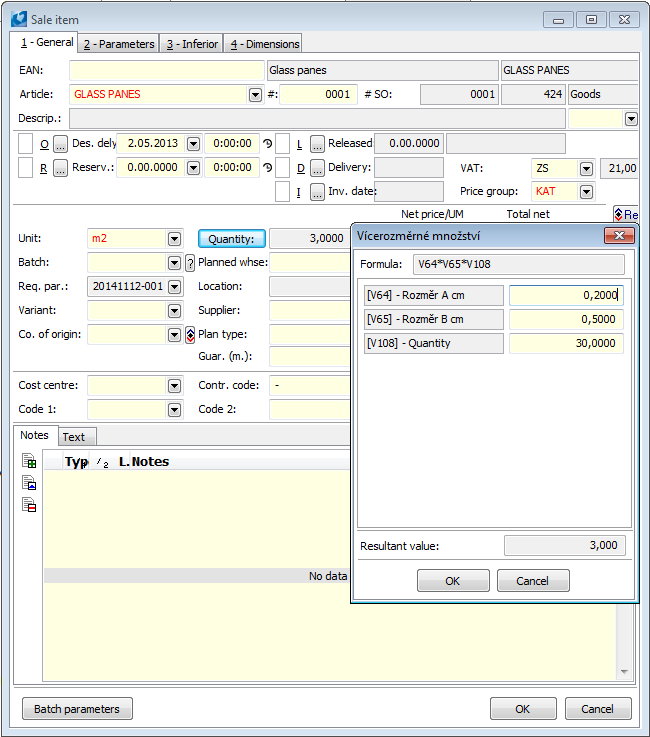
Picture: Sale Item - alternative unit "m2"
You create a release note. From the column Available in the Article book the 3 square meters will displaced to the column Assigned. On the basis of required characteristic (proportions and number) you can select an appropriate batch. Now you can confirm a release note. Released quantity deducts from the column Assigned, on the stock the one square meter will remain.
Attention: If you confirm the older stock document and the formula has been changed in the meantime, the document cannot be reconfirmed due to a change in the algorithm calculation! In this case, it is necessary to delete the Batch and the required parameter and re-enter the values via the Multi-dimensional Quantity form to create a new required parameter and, by confirming the document, also a new Batch according to the new formula.

